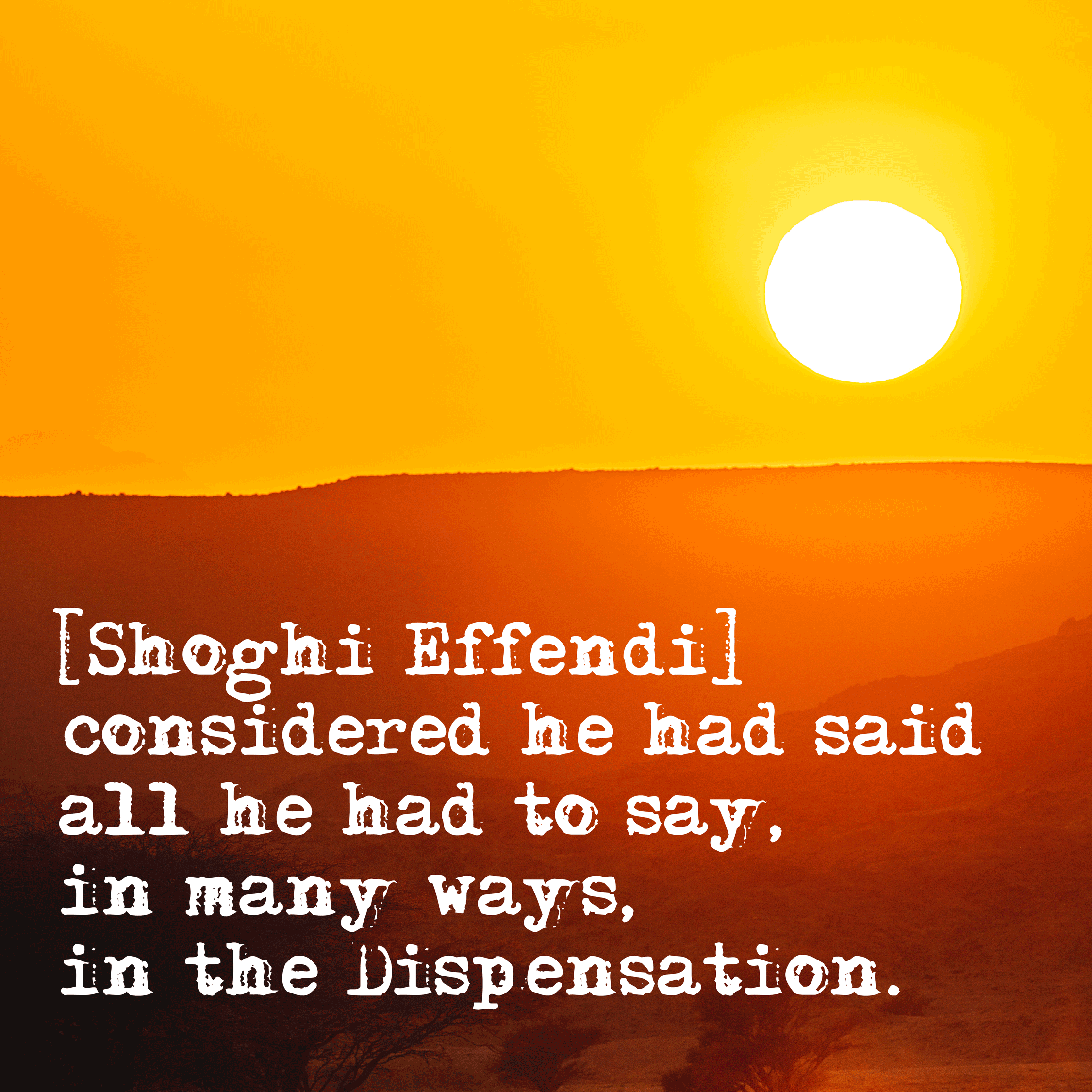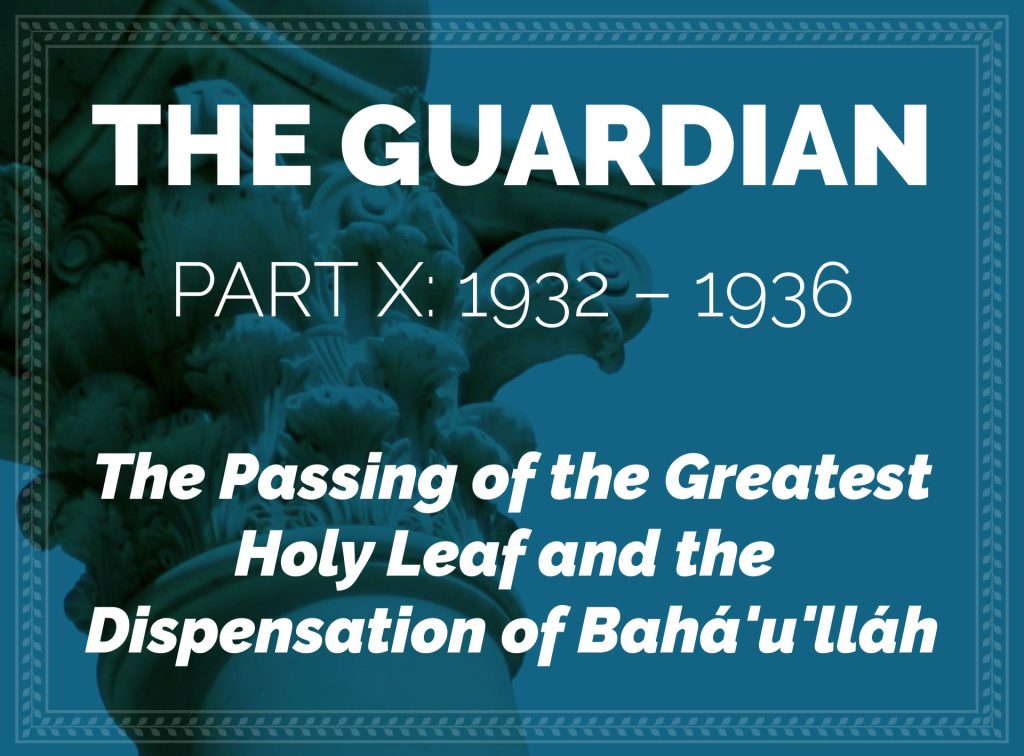
Written and illustrated by Violetta Zein
This part covers the life of Shoghi Effendi from the age of 36 in 1933 to the age of 39 in 1936.
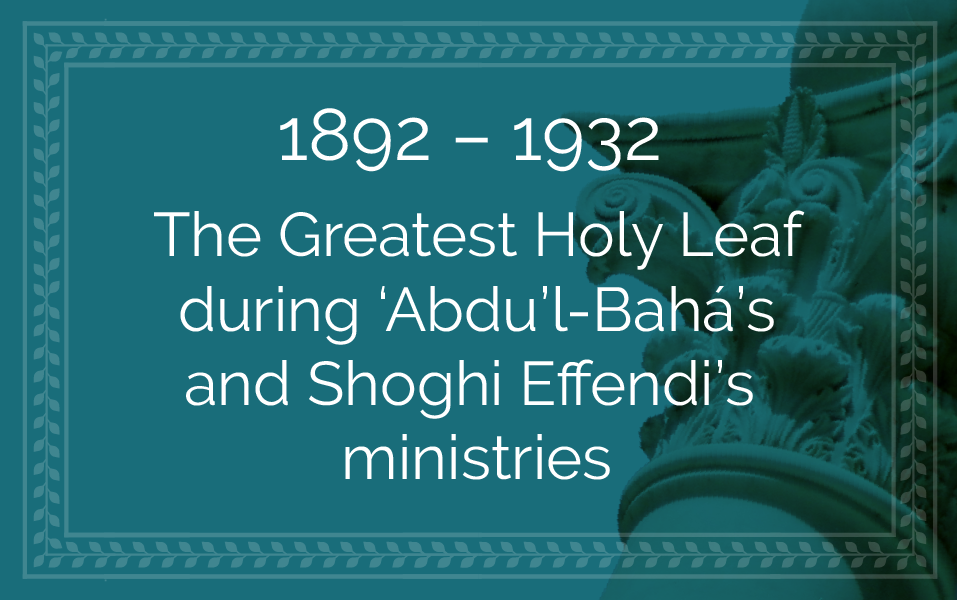
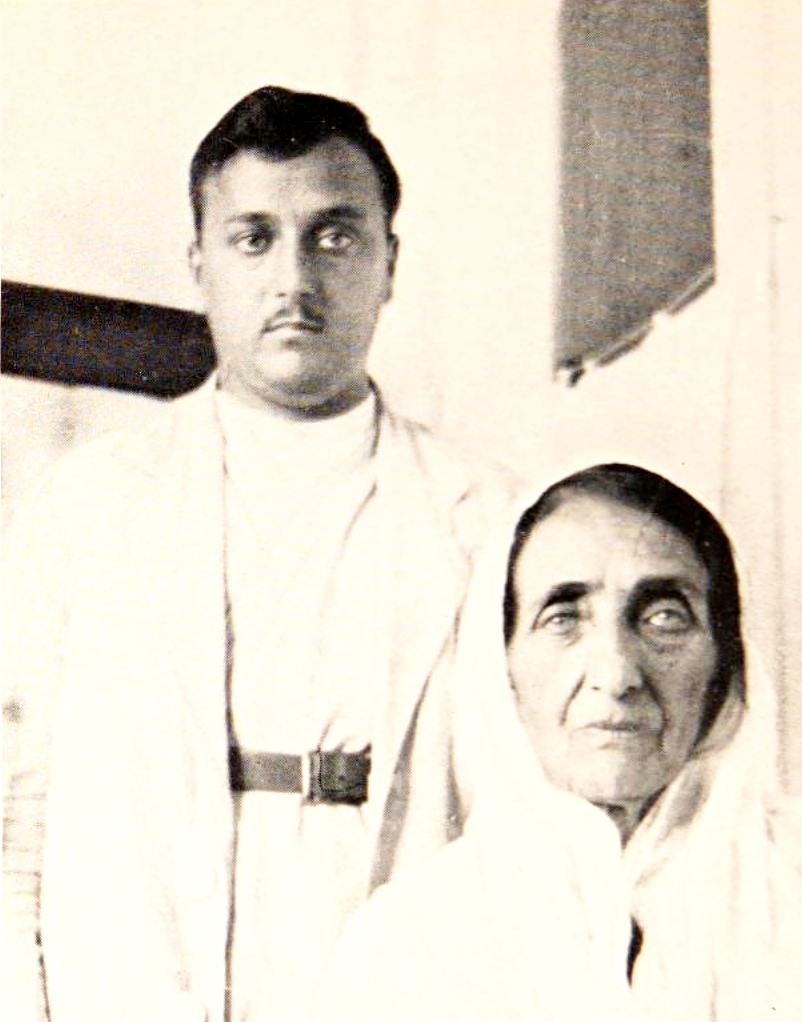
Shoghi Effendi and the Greatest Holy Leaf some time between 1918 and 1920. Source: The Priceless Pearl, between pages 168 and 169.
Shoghi Effendi had grown up worshipping 'Abdu'l-Bahá and the Greatest Holy Leaf, they were his two most beloved people in the world. Both the Master and Bahíyyih Khánum also adored him, and even if they tried not to show it, Shoghi Effendi was their favorite grandchild/grand-nephew.
Shoghi Effendi was a constant reminder to the Greatest Holy Leaf of her beloved father, Bahá'u'lláh. When he was a child, the Greatest Holy Leaf would take Shoghi Effendi’s hands in hers and say:
These are like the hands of my father.
It is clear that Shoghi Effendi was much closer to 'Abdu'l-Bahá and the Greatest Holy Leaf than his parents, aunts, and siblings. Shoghi Effendi always considered the Greatest Holy Leaf to be an incarnation of 'Abdu'l-Bahá's all-encompassing tenderness and love. This is how Rúḥíyyih Khánum describes the love between Shoghi Effendi and his Great-Aunt:
However faithful and tender Shoghi Effendi’s relationships were throughout his life with those closest to him, his supreme relationship was with the Greatest Holy Leaf.
When he became the Guardian, he was 24 years old and the Greatest Holy Leaf was 75. Shoghi Effendi was beginning his life, and Bahíyyih Khánum was entering old age. When the Greatest Holy Leaf passed away, Shoghi Effendi was 35 years old, still young, but he had grown strong in his Guardianship, but as Rúḥíyyih Khánum states, the bond between the Greatest Holy Leaf and the Guardian was as strong as ever:
This love the Guardian had for the Greatest Holy Leaf, who had watched over him for thirty-five years as far more than a mother, continued to be demonstrated for the remainder of his life.
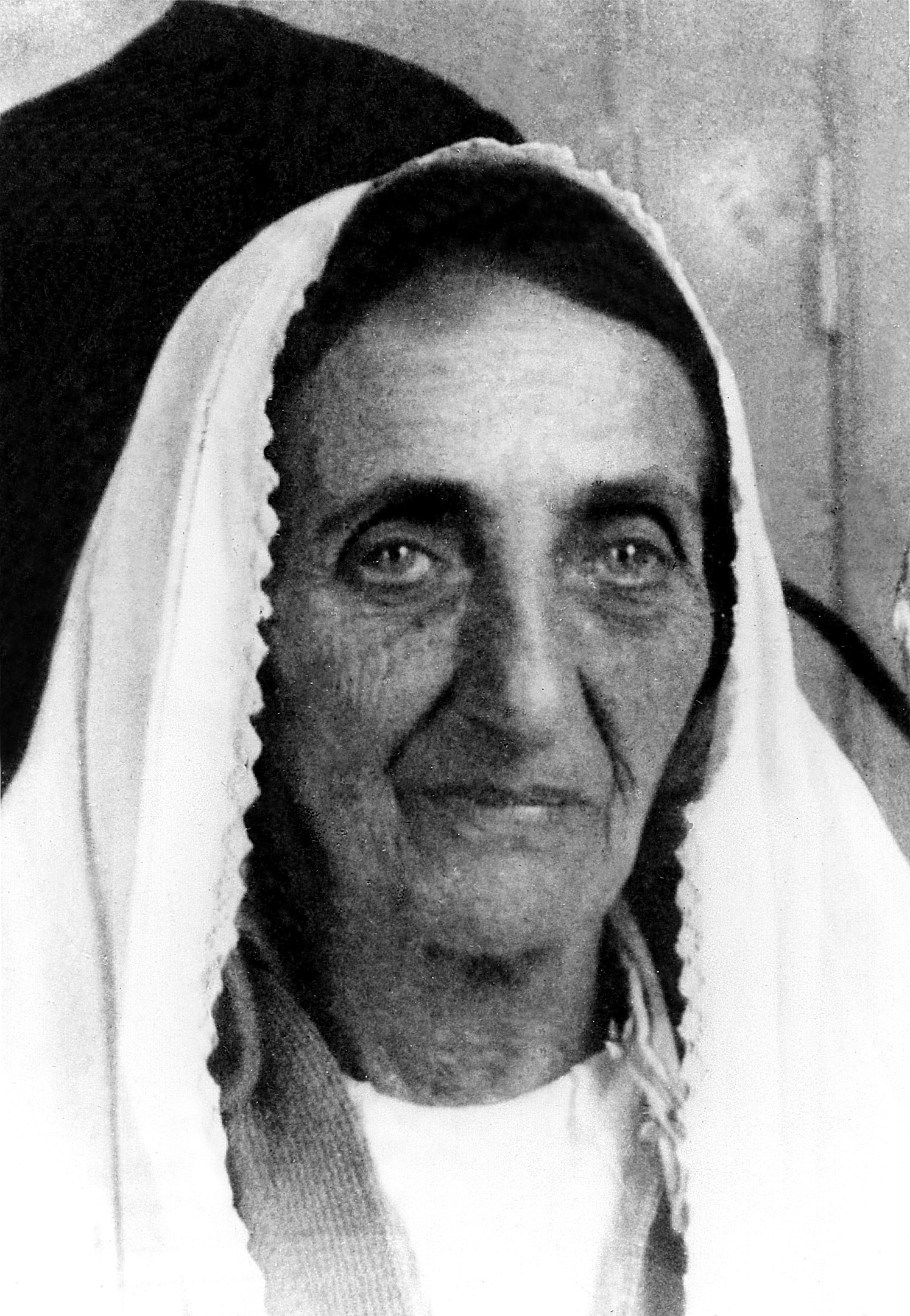
Greatest Holy Leaf, Bahíyyih Khánum—daughter of Bahá'u'lláh and Ásíyih Khánum and sister of 'Abdu'l-Bahá—close to the end of her life. Source: Bahá'í Media Bank, © Bahá'í International Community 2023.
After the passing of 'Abdu'l-Bahá, Shoghi Effendi became the very center of the Greatest Holy Leaf’s life and in the first ten years of his Guardianship, she was with him every step of the way.
Shoghi Effendi had an intimate bond of communion closeness with the Greatest Holy Leaf and in the first two years of his ministry, Shoghi Effendi didn’t close his letters and cables the way we are familiar with—Your true brother—but rather he often included Bahíyyih Khánum with phrases like these:
In this fervent plea joins me the Greatest Holy Leaf…
the Greatest Holy Leaf and I…
The numerous communications which your distinguished Secretary has lately addressed on your behalf to the Greatest Holy Leaf and myself…
The Greatest Holy Leaf desires me to convey in her name to the esteemed members of the Green Acre Fellowship the expression of her cordial thanks…
The Greatest Holy Leaf joins me in requesting delegates assembled under Mashriqu’l-Adhkár’s sacred dome convey all American believers expression our heartfelt congratulations…
Greatest Holy Leaf joins me...expression our heartfelt congratulations boundless joy profound gratitude practical completion superstructure glorious edifice…
In 1931, Shoghi Effendi sent a cable and signed it:
Bahíyyih Shoghi
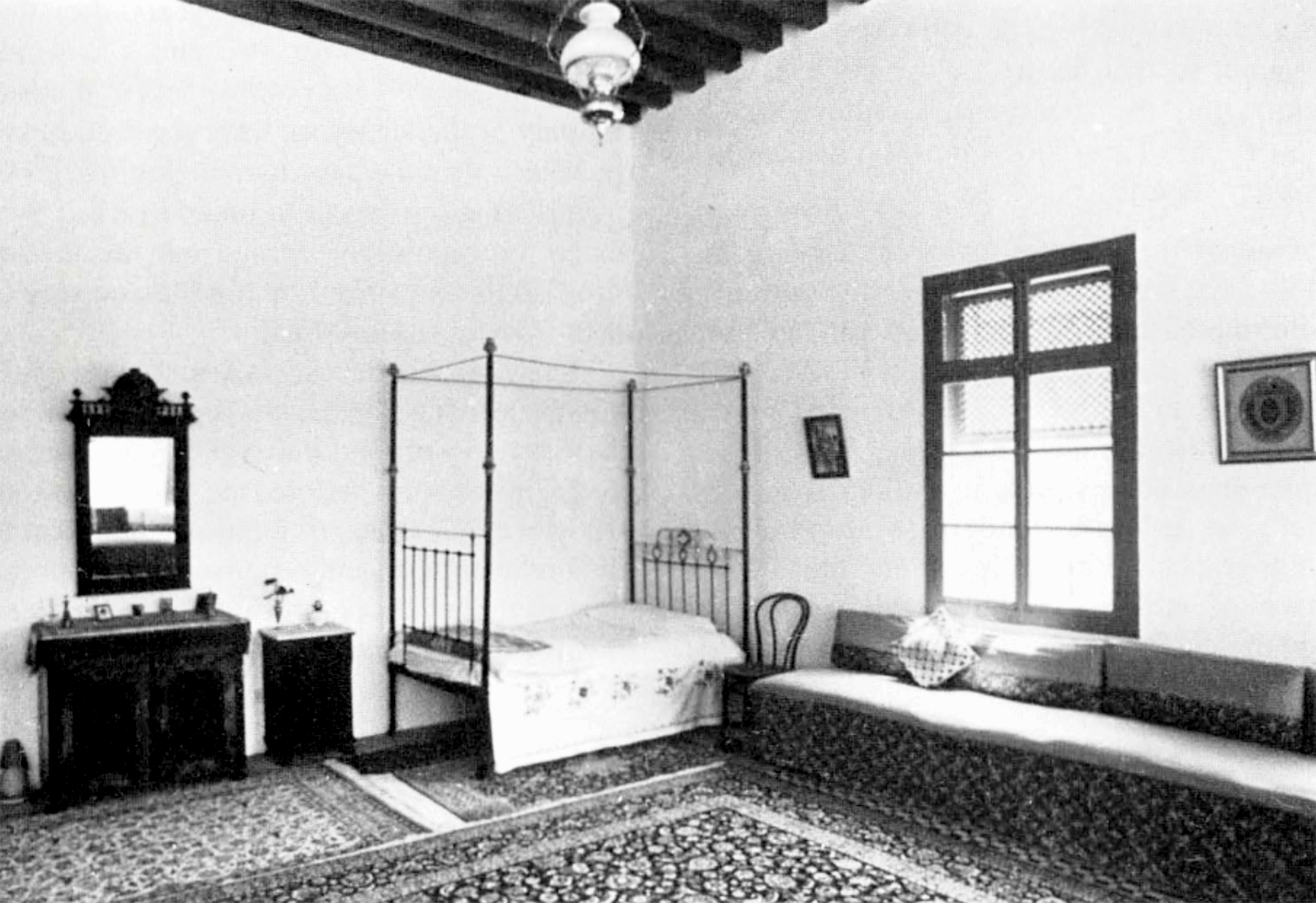
The room of Bahíyyih Khánum in the House of 'Abdu'lláh Pashá, in which the remains of the Báb were stored prior to being moved to Haifa. Originally published in The Bahá'í World Volume 18 [age 74. Source: Bahaimedia.
The Greatest Holy Leaf was a stable, spiritual presence, a refuge of safety and a tower of strength for Shoghi Effendi from the time he was born. When. Shoghi Effendi returned to the Holy Land, after several weeks he moved into the house of 'Abdu'l-Bahá with the Greatest Holy Leaf. The Greatest Holy Leaf lived on the second floor, and Shoghi Effendi lived on the third floor.
Shoghi Effendi only ever ate one meal a day, and until he left Haifa in mid-May 1932, Shoghi Effendi ate that single daily meal on a small table in the Greatest Holy Leaf’s bedroom, alone with his beloved great-aunt. The Greatest Holy Leaf’s handmaid would knock on Shoghi Effendi’s door and tell him dinner was ready, then Shoghi Effendi would sit facing the Greatest Holy Leaf and first serve her plate before helping himself.
The Greatest Holy Leaf adored Shoghi Effendi and was devoted to her Guardian. She made every effort to bring everyone into the Covenant and advocated for him ceaselessly. She also worried about Shoghi Effendi. That he didn’t sleep enough, that he worked too much, that he was too sensitive, she worried about his health, and about him eating food when he was upset about something. She told him that eating when you are upset was bad for your health.
Whenever she heard his footsteps, the Greatest Holy Leaf would come out of his room, take Shoghi Effendi’s hand and bring him into her room. She would give him whatever she had to eat, and ask him to rest for a few minutes. The Greatest Holy Leaf loved Shoghi Effendi so much she enjoyed the little things: watching him eat, watching him walk.
When he was ready to leave for his visit to the Shrine of the Báb, the Greatest Holy Leaf accompanied him to the door, her eyes following him, saying:
O ‘Abdu’l-Bahá! What a Guardian you have left behind! He has illumined the world and will continue to shed lustre upon it.
The Greatest Holy Leaf paced at the top of the stairs until the beloved Guardian returned from Mount Carmel, and as soon as she saw him, she would say:
He is coming. He is coming.
The Greatest Holy Leaf invited Shoghi Effendi to her room and would lock the door from the inside so they could speak privately.
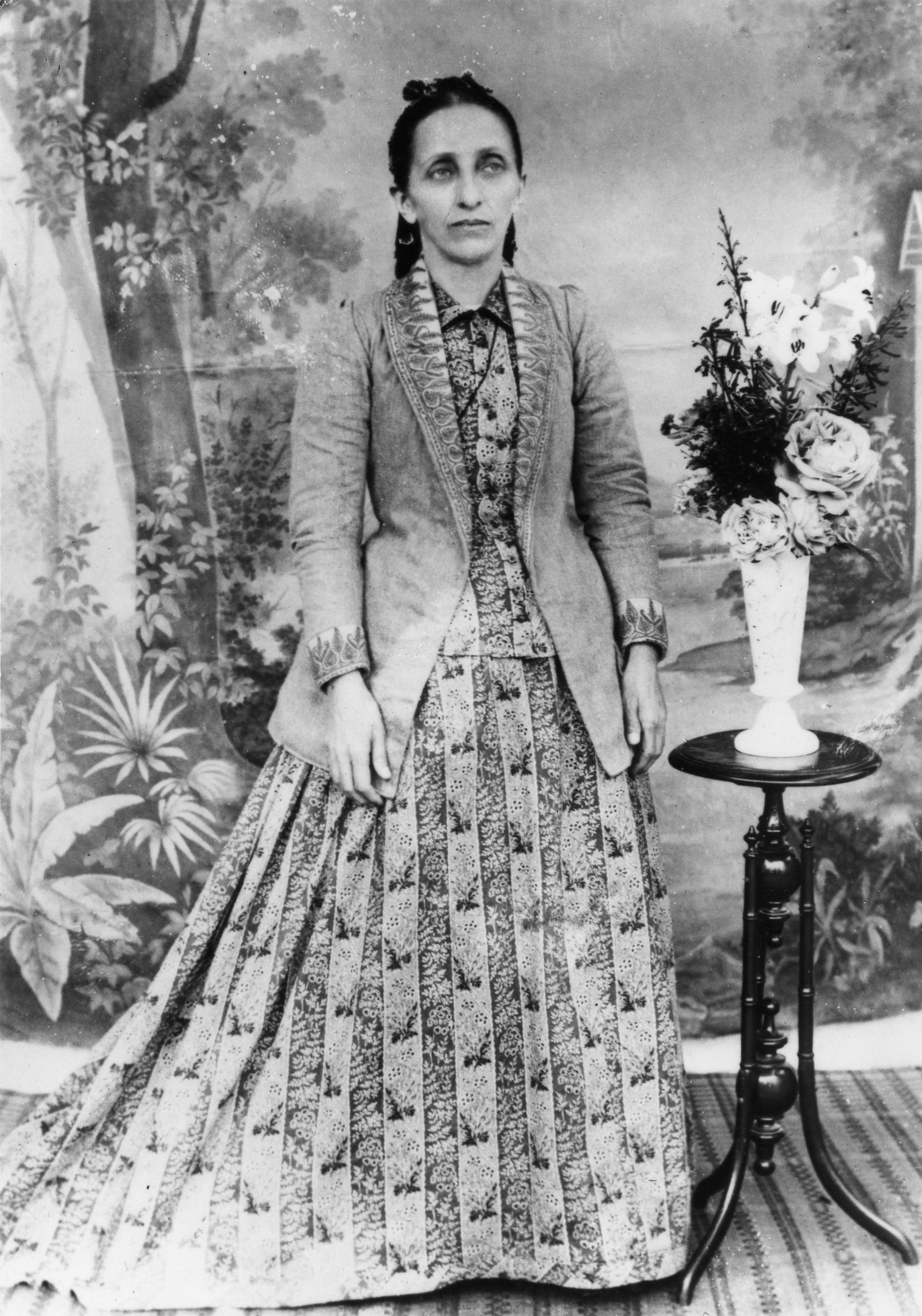
The Greatest Holy Leaf around 1895. Source: Bahá'í Media Bank, © Bahá'í International Community 2023.
In 1892 and 1921, when the Greatest Holy Leaf experienced the two most devastating losses of her life—her Father, Bahá'u'lláh, and her beloved Brother, 'Abdu'l-Bahá—she was there to support 'Abdu'l-Bahá and Shoghi Effendi as they respectively assumed the mantle of Center of the Covenant and Guardian of the Faith of Bahá'u'lláh, in the midst of their astounding grief.
Bahíyyih Khánum was there to stay behind in 'Akká and Haifa when 'Abdu'l-Bahá and Shoghi Effendi had to seek refuge in solitude to come to terms with the end of their previous life, and the beginning of their new divinely-appointed mission as Head of the Faith.
Few people realize that, all told, the Greatest Holy Leaf single-handedly held the Bahá'í World Centre, managed the Bahá'í community in the Holy Land, the affairs of the worldwide Bahá'í community, Covenant-breakers, persecutions in Persia, and Bahá'í pilgrims from East and West during 'Abdu'l-Bahá’s and Shoghi Effendi’s absences for a period of at least 7.5 years.
The true figure is probably closer to 8.5 years.
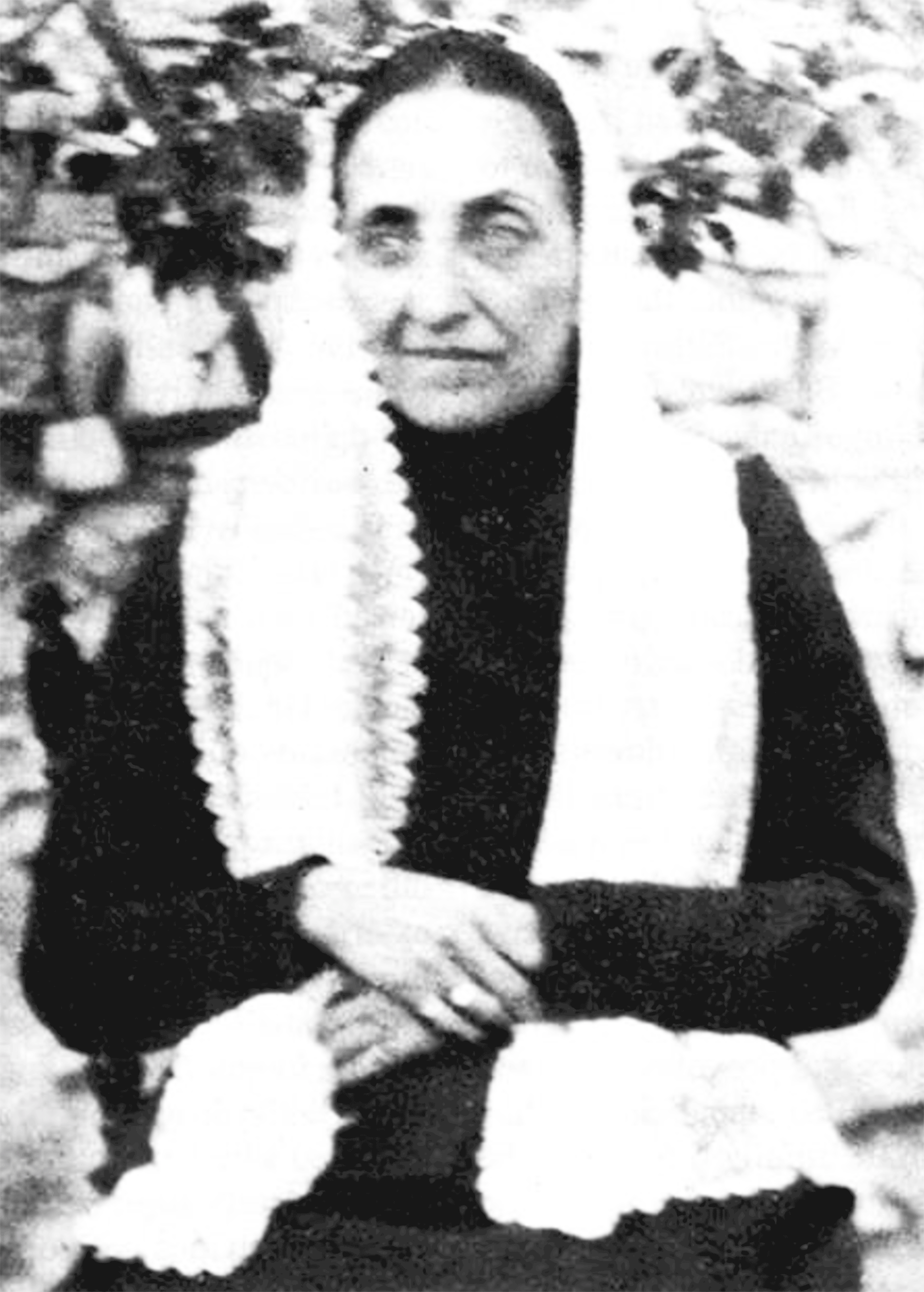
Bahíyyih Khánum, the Greatest Holy Leaf in middle age. Source: Bahá'í Biblio.
This figure may seem extraordinary, but it is based in historical, dated facts of the 8 known absences of 'Abdu'l-Bahá and the 9 known absences of Shoghi Effendi from the Holy Land:
- Summer 1892: Abdu’l-Bahá in the cave of Elijah on Mount Carmel after the Ascension of Bahá'u'lláh—1 month
- 1895 – 1896: ‘Abdu’l-Bahá in Tiberias—'Abdu'l-Bahá had left 'Akká before the summer of 1896, because He was not present at Shoghi Effendi’s parents’ wedding—we have no precise date for their wedding, but because Shoghi Effendi was born on 1 March 1897, it means his parents were married at least nine months prior, so either in early June or a few months before. 'Abdu'l-Bahá was back before the autumn 1896 when He rented the house of 'Abdu'lláh Pashá—beyond these vague indications, there is data on the length of 'Abdu'l-Bahá’s stay in Tiberias.
- 'Abdu'l-Bahá’s trip to Beirut: undated, no data
- August 1910 to December 1913: ‘Abdu’l-Bahá’s visit to the West—3 years and 4 months
- 1 May to 16 June 1914: 'Abdu'l-Bahá visits Tiberias and the hot springs—1.5 months
- Early 1916: 'Abdu'l-Bahá’s trip to Nazareth—no more than a few days
- 1916 – 1918: During the war, 'Abdu'l-Bahá visited Tiberias and Adasíyyih—Several months: unquantifiable data
- March - April 1921: Abdu'l-Bahá visited Tiberias—1 Month
- 29 November 1921 - 30 December 1921: Bahíyyih Khánum alone between the Ascension of 'Abdu'l-Bahá and Shoghi Effendi’s arrival in the Holy Land—1 month
- April to December 1922: Shoghi Effendi’s summer retreat to Switzerland after the Ascension of 'Abdu'l-Bahá—8 months
- June to November 1923: Shoghi Effendi’s summer retreat to Switzerland—5 months
- March to September 1924: Shoghi Effendi’s summer retreat to Switzerland—6 months
- May to October 1925: Shoghi Effendi’s summer retreat to Switzerland—5 months
- May to October 1926: Shoghi Effendi’s summer retreat to Switzerland—5 months
- June to November 1927: Shoghi Effendi’s summer retreat to Switzerland—5 months
- Summer - October 1929: Shoghi Effendi travels to Europe—likely Switzerland but there is no historical confirmation—to England, then by ship to Cape Town, and overland through Africa, including the Belgian Congo, to Cairo, Egypt, and back to Haifa—5 months
- May 1932 to July: Shoghi Effendi arrived in Switzerland for his summer retreat, and the Greatest Holy Leaf passed away while he was in Interlaken, on 15 July 1932—2 months
There are at least four reasons why the figure is closer to 8.5 years than it is to 7.5 years:
- In 1895 – 1896—when He was absent for the marriage of Shoghi Effendi’s parents—'Abdu'l-Bahá spent an unknown amount of time in Tiberias, which could range from weeks to months;
- 'Abdu'l-Bahá traveled to Beirut after the Ascension of Bahá'u'lláh and wrote Bahíyyih Khánum letters, but there is no indication of what year, or how long 'Abdu'l-Bahá was absent from the Holy Land;
- 'Abdu'l-Bahá spent several months in the Jordan and Yarmuk Valleys, the area around the Sea of Galilee, and in Tiberias during 1916 and 1918, but we do not know how many weeks or months exactly. This could add between 1 to 3 months to the initial figure;
- There is no data on Shoghi Effendi’s trips to Switzerland during the summers of 1928, 1930, and 1931, but that does not mean that Shoghi Effendi did not travel. Given the fact that the Guardian traveled to Switzerland in 1922, 1923, 1924, 1925, 1926, 1927, 1929, and 1932, and most of the summers of his ministry after the passing of the Greatest Holy Leaf—except for the years of World War II—it is likely he also traveled for those three summers—this would add between 12 and 15 months to the initial estimate.
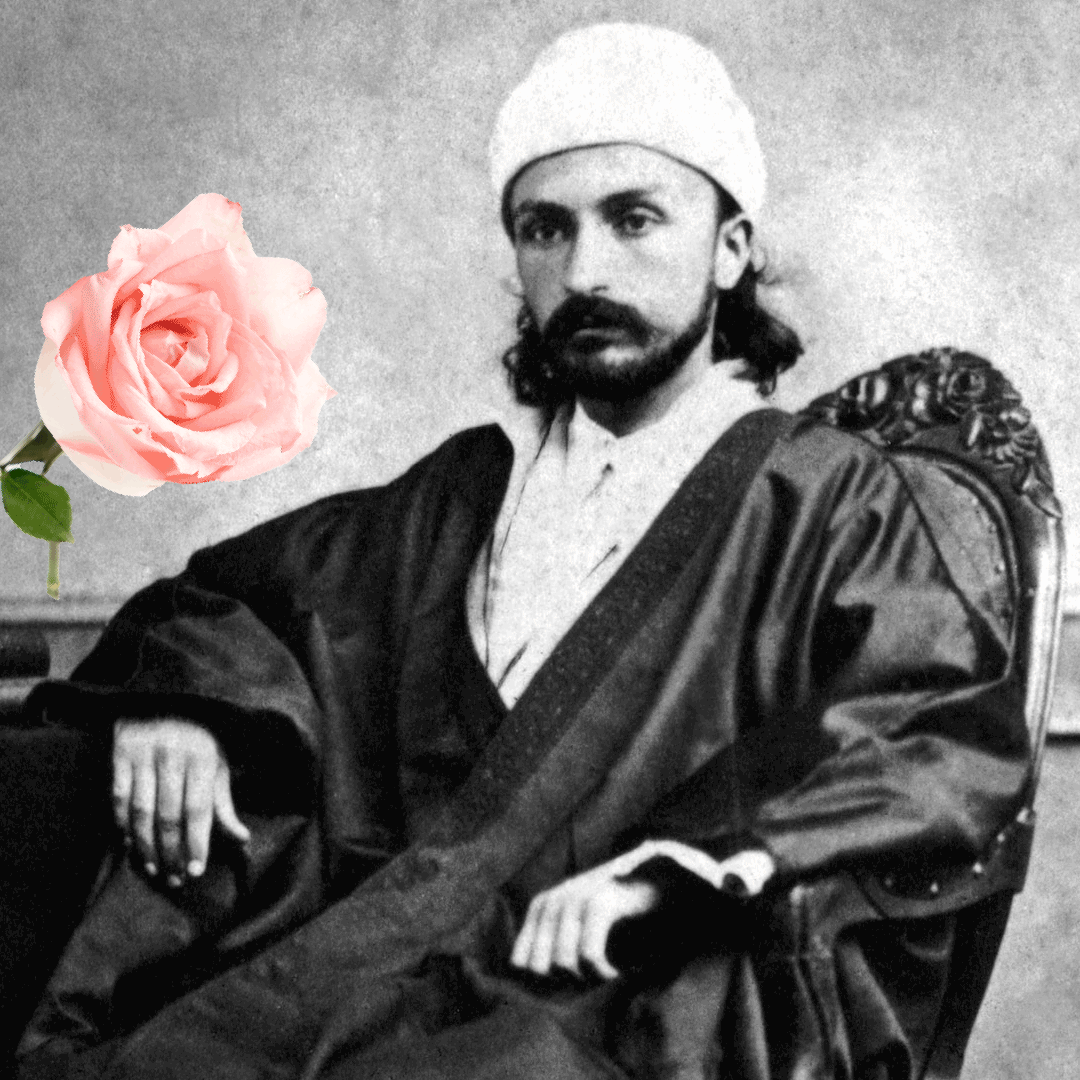
Photo of 'Abdu'l-Bahá in 1868 from Bahá'í Media Bank, © Bahá'í International Community 2023. Rose photograph by TopNTP26 on Freepik.
Bahíyyih Khánum was the only living member of Bahá’u’lláh’s immediate family who not only remained faithful to His Covenant, but also stood by ‘Abdu’l-Bahá through, firmly and steadfastly for the duration of his 29-year ministry.
It was only because He had the Greatest Holy Leaf, His deputy and vicegerent during His long absence from the Holy Land, that 'Abdu'l-Bahá was even able to contemplate leaving Haifa for such a long period of time.
‘Abdu’l-Bahá relied on Bahíyyih Khánum. Her sacrificial nature, her discretion as His confidant, His tireless helper, selfless support and utterly trustworthy ally, she became 'Abdu'l-Bahá’s right hand during His ministry.
She hosted increasing numbers of eastern and western pilgrims, and whenever they were separated, 'Abdu'l-Bahá always wrote expressing eagerness at seeing His sister again, always asking her to kiss Shoghi Effendi for Him.
She held firm in the face of increased Covenant-breaking activity during 'Abdu'l-Bahá’s Journeys to the West.
Shoghi Effendi described Bahíyyih Khánum, the Greatest Holy Leaf’s support to 'Abdu'l-Bahá, saying she was a “trusted supporter of the peerless Branch of Bahá’u’lláh, and a companion to Him beyond compare”, “His competent deputy”, “His representative and vicegerent, with none to equal her.”
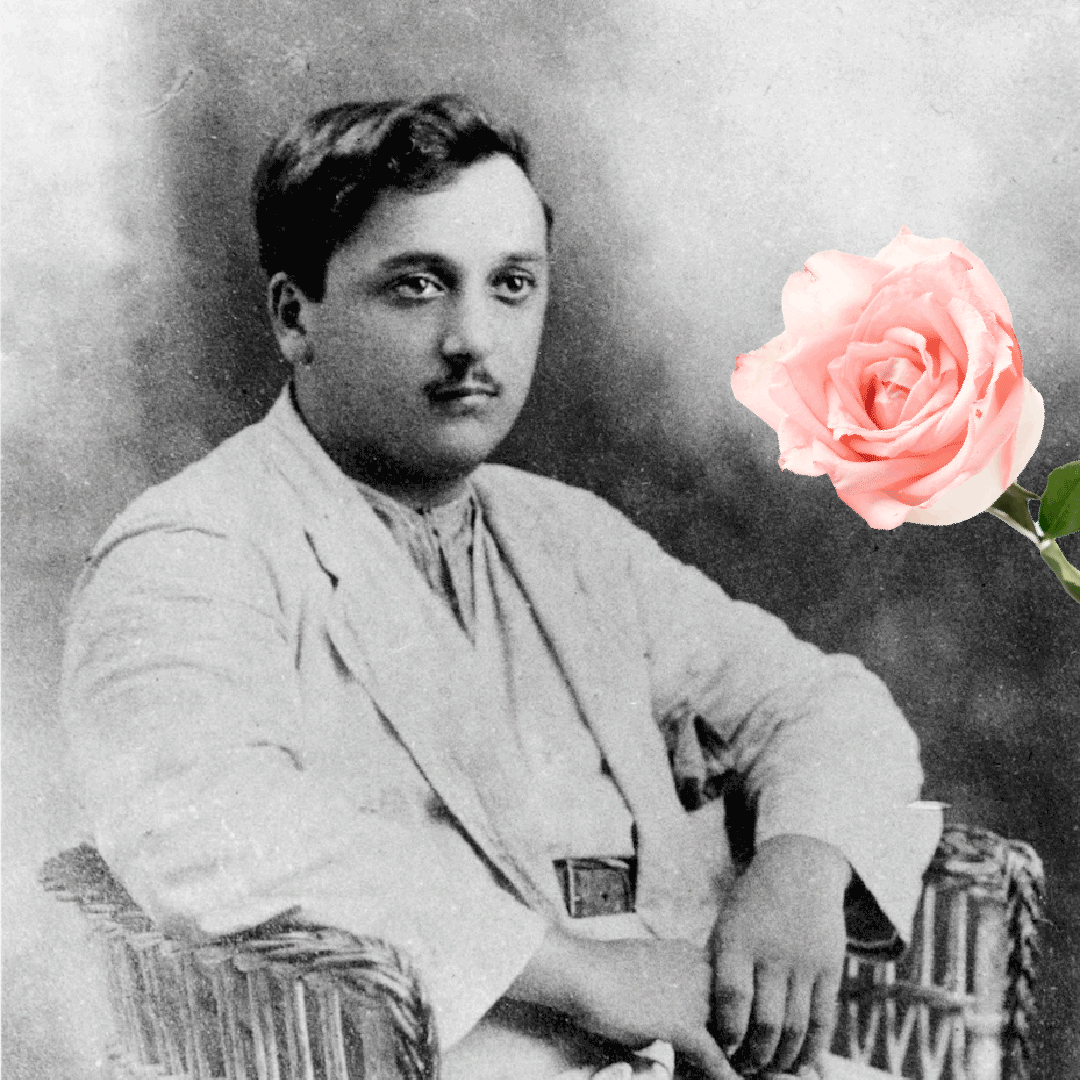
Photo of Shoghi Effendi in 1919 from Bahá'í Media Bank, © Bahá'í International Community 2023. Rose photograph by TopNTP26 on Freepik.
When 'Abdu'l-Bahá passed away, Bahíyyih Khánum was the only one who had the past experience, the pedigree, the authority to take up the reins and make decisions until Shoghi Effendi arrived, and was apprised of his station as Guardian. She organized the funeral, chose the tomb of 'Abdu'l-Bahá in consultation with eminent believers, comforted the local community, and sent messages to the worldwide Bahá'í community.
To Shoghi Effendi also, the Greatest Holy Leaf offered respite. She had lived through the three decades of 'Abdu'l-Bahá’s ministry from start to finish and she knew what the superhuman pressures it implied. When Shoghi Effendi needed to leave after the initial shock of 'Abdu'l-Bahá’s Ascension, the Greatest Holy Leaf stayed in Haifa and held the affairs of the Faith in her wise and capable hands.
Because the Greatest Holy Leaf was 'Abdu'l-Bahá’s beloved and faithful sister, his constant steward and sole supporter, she offered Shoghi Effendi that last link with his beloved Grandfather, torn away from him so suddenly. Shoghi Effendi even confirmed in several of his letters and cables the similarity between Bahíyyih Khánum’s and 'Abdu'l-Bahá’s spiritual qualities:
To me, standing in so dire a need of the vitalizing grace of God, she was the living symbol of many an attribute I had learned to admire in ‘Abdu'l-Bahá. She was to me a continual reminder of His inspiring personality, of His calm resignation, of His munificence and magnanimity. To me she was an incarnation of His winsome graciousness, of His all-encompassing tenderness and love.
The Greatest Holy Leaf acted as steward of the Faith during Shoghi Effendi’s absences every summer for the first ten years of his Guardianship—although we have no records of him leaving in the summers of 1928, 1930, and 1931.
Before Shoghi Effendi’s arrival on 29 December 1921, Bahíyyih Khánum had to ward off attempts by Covenant-breakers to curry favor with. 'Abdu'l-Bahá’s family and warned the American Bahá'ís of other Covenant-breaking plots.
During Shoghi Effendi’s first absence in the summer of 1922, the issue of the legal custodianship of the Shrine of Bahá'u'lláh wasn’t resolved and Shoghi Effendi sent an official letter to Governor Symes introducing him to Bahíyyih Khánum, as his authoritative representative. It was exceedingly rare in the 1920s for a woman to be in charge. Bahíyyih Khánum defended the worldwide Bahá'í community against the plottings of Covenant-breakers, and did her utmost to protect the vulnerable Bahá'ís in Persia from persecutions at the hands of fanatical elements.
What makes Greatest Holy Leaf so exceptional, is that both 'Abdu'l-Bahá and Shoghi Effendi knew how much they owed her, and they showered her with praise during her life. Shoghi Effendi referred to Bahíyyih Khánum as “my chief sustainer, my most affectionate comforter, the joy and inspiration of my life.”
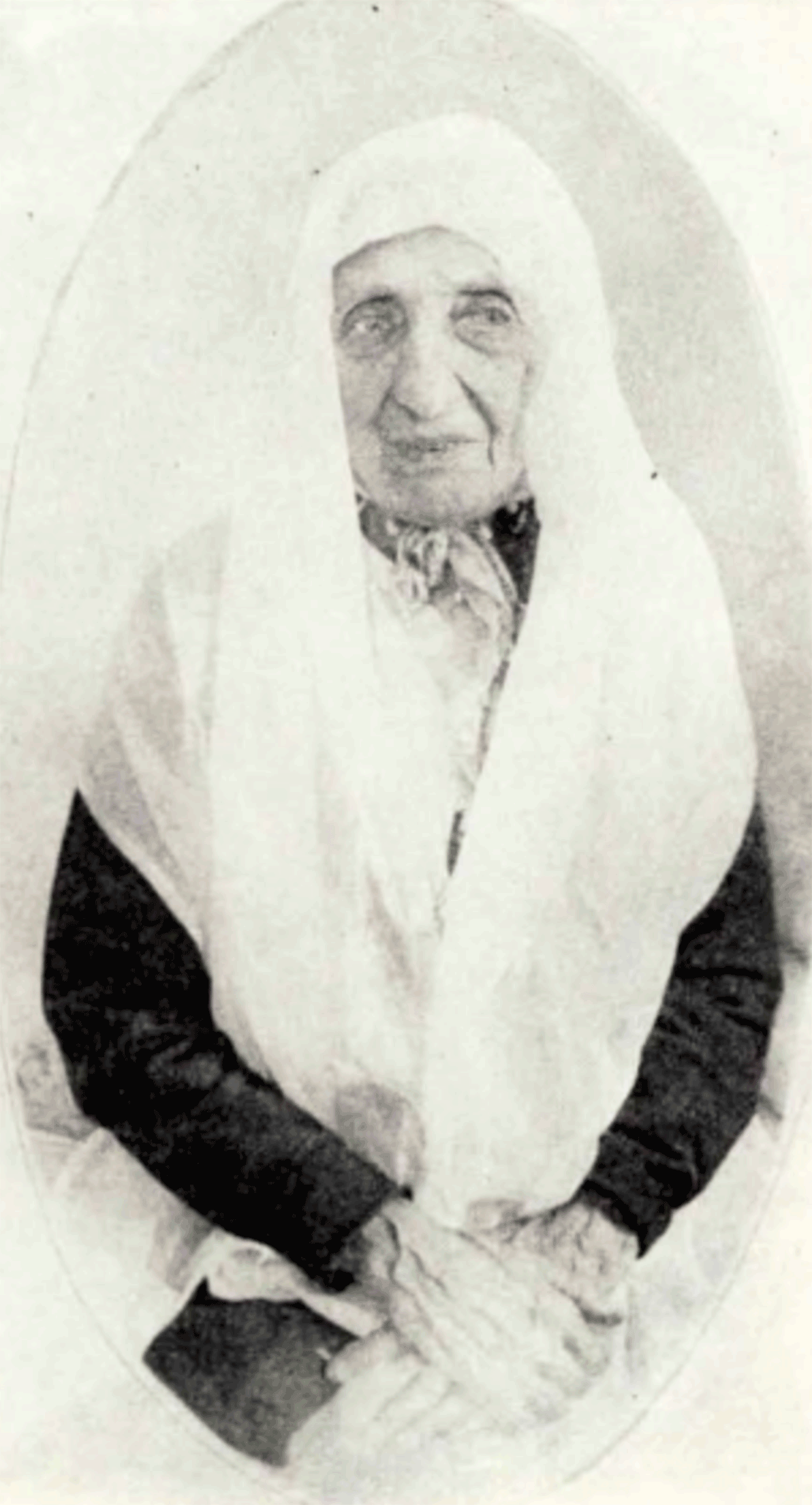
The Greatest Holy Leaf in 1931, one year prior to her passing. Source: Bahaimedia.
Shoghi Effendi was deeply aware that his pillar and sole support, his beloved great-aunt, the Greatest Holy Leaf was approaching the last years of her earthly life. Bahíyyih Khánum was 83 and frail, her eyesight was failing and her strength was declining.
The Guardian’s awareness of this is evident in two letters he sent to the Bahá'ís of the United States and Canada in 1929 and three years later, in 1932.
On 25 October 1929, the Guardian explained to the Bahá'ís of North America that one of the Greatest Holy Leaf’s last earthly wishes was the restarting of the work of the Mother Temple of the West:
Neither do I need to expatiate upon the hopes and fears of the Greatest Holy Leaf, now in the evening of her life, with deepening shadows caused by failing eye-sight and declining strength swiftly gathering about her, yearning to hear as the one remaining solace in her swiftly ebbing life the news of the resumption of work on an Edifice, the glories of which she has, from the lips of ‘Abdu’l Bahá, Himself, learned to admire.
The Guardian explained to the American Bahá'í community that seizing the last months left in 1929 to continue the work on the House of Worship should be done for three main reasons: the inspiration and comfort it would bring to the persecuted Bahá'ís in Persia, the undeniable proof of the status of the Bahá'í Faith in the eyes of the world, and last but not least, the realization of the Greatest Holy Leaf’s dearest wish.
Exactly two years, four months and 25 days later, the Guardian wrote The Golden Age of the Cause of Bahá'u'lláh, and directly conveyed the Greatest Holy Leaf’s plea, a call from the heart of the sister of 'Abdu'l-Bahá, just four months before her passing:
First, the Guardian begins:
And in this fervent plea, my voice is once more reinforced by the passionate, and perhaps, the last, entreaty, of the Greatest Holy Leaf, whose spirit, now hovering on the edge of the Great Beyond, longs to carry on its flight to the Abhá Kingdom, and into the presence of a Divine, an almighty Father, an assurance of the joyous consummation of an enterprise, the progress of which has so greatly brightened the closing days of her earthly life.
Although the Guardian was intellectually aware of the approaching end of Bahíyyih Khánum’s life, her death came to him as a severe blow.
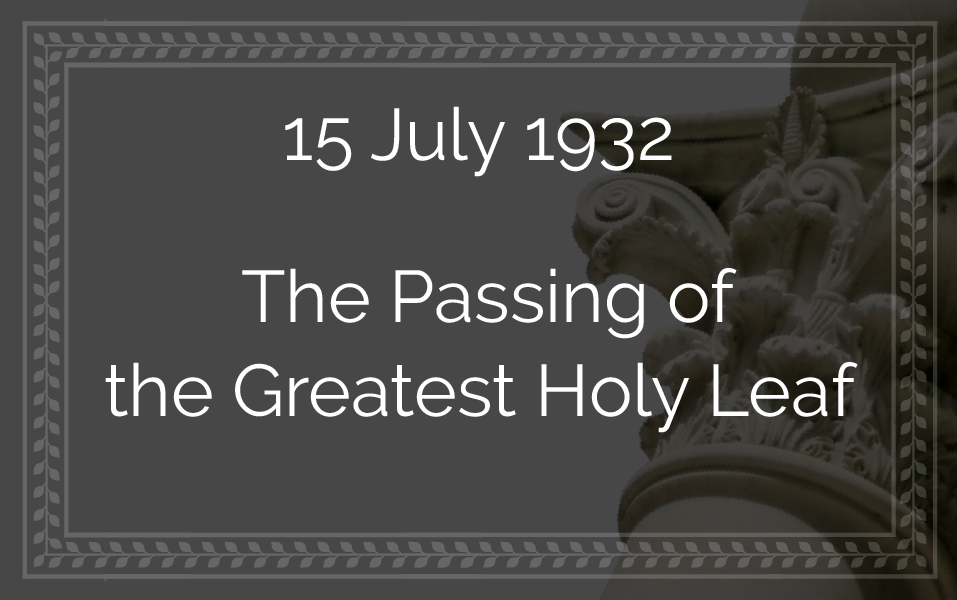
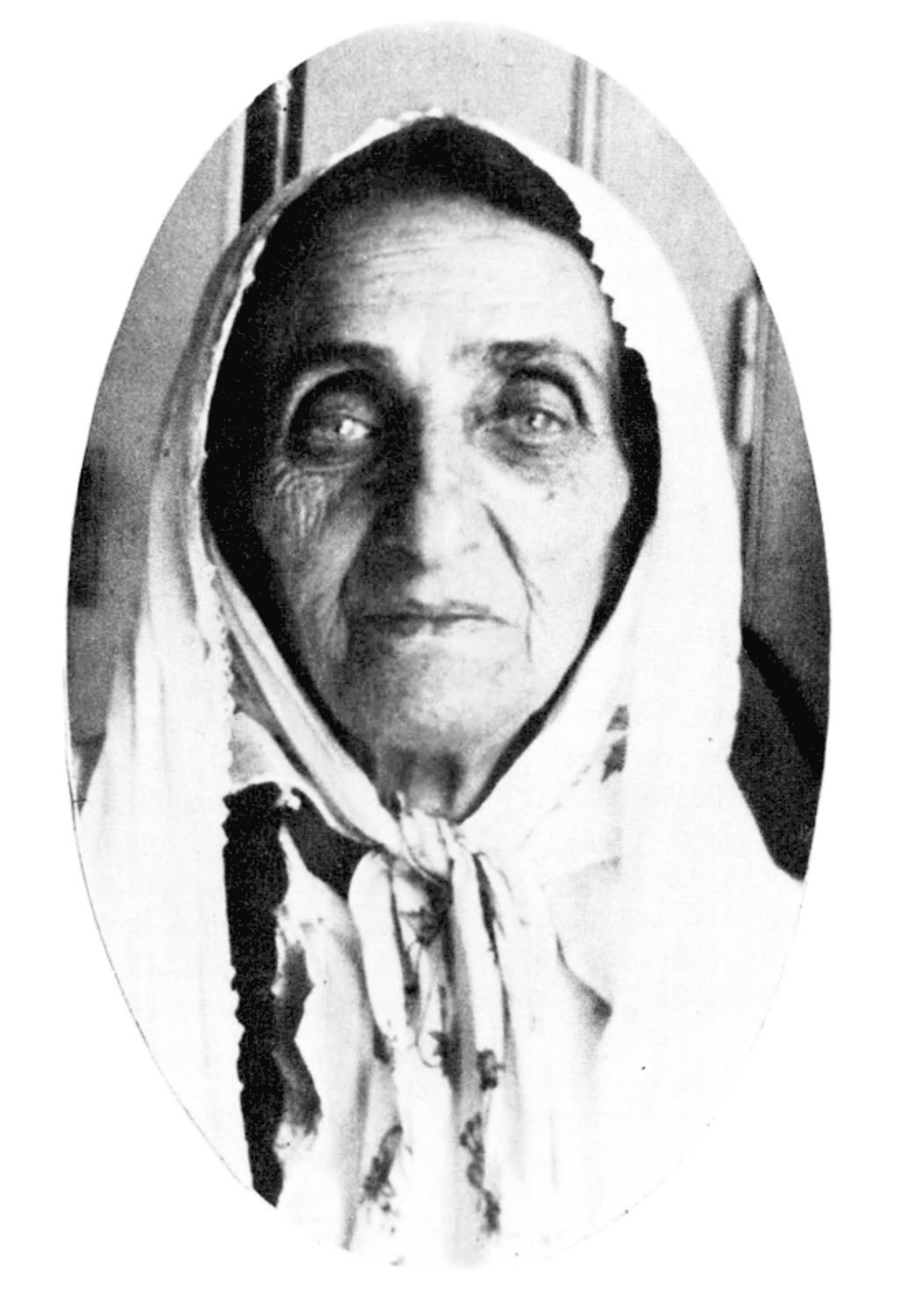
A portrait of the Greatest Holy Leaf taken around 1919. Source: Bahaimedia.
Shoghi Effendi had left the Holy Land sometime in May 1932 for his annual rest and recuperation in Interlaken, Switzerland. Before leaving, however, the Guardian had left instructions regarding the spot on Mount Carmel where Bahíyyih Khánum was to be buried if she died while he was away.
His instructions showed his infallibility.
It was there, two months after his arrival in the sheltering shadow of his beloved mountains, that he received the second most devastating news of his life, after the news of 'Abdu'l-Bahá’s Ascension.
On 15 July 1932, the Greatest Holy Leaf had passed away in Haifa, at one in the morning—the same time as 'Abdu'l-Bahá. She had contracted bronchitis at a time when she was extremely weak and frail, and all the women of the family, along with the mother of ‘Alí Nakhjávání had kept a 24-hour watch on her until she passed away.
The Greatest Holy Leaf had prepared her burial shroud, a pair of white socks, a white scarf, a white handkerchief and a white dress made of inexpensive material and wrapped everything in paper.
The Greatest Holy Leaf was buried later that day on Mount Carmel, in a spot that had been especially designated by the Guardian. By choosing to inter the Greatest Holy Leaf on the slopes of Mount Carmel and in such close proximity to the Shrine of the Báb, Shoghi Effendi took the first step in building the future Bahá'í World Center where the Seat of the Universal House of Justice would one day be built.
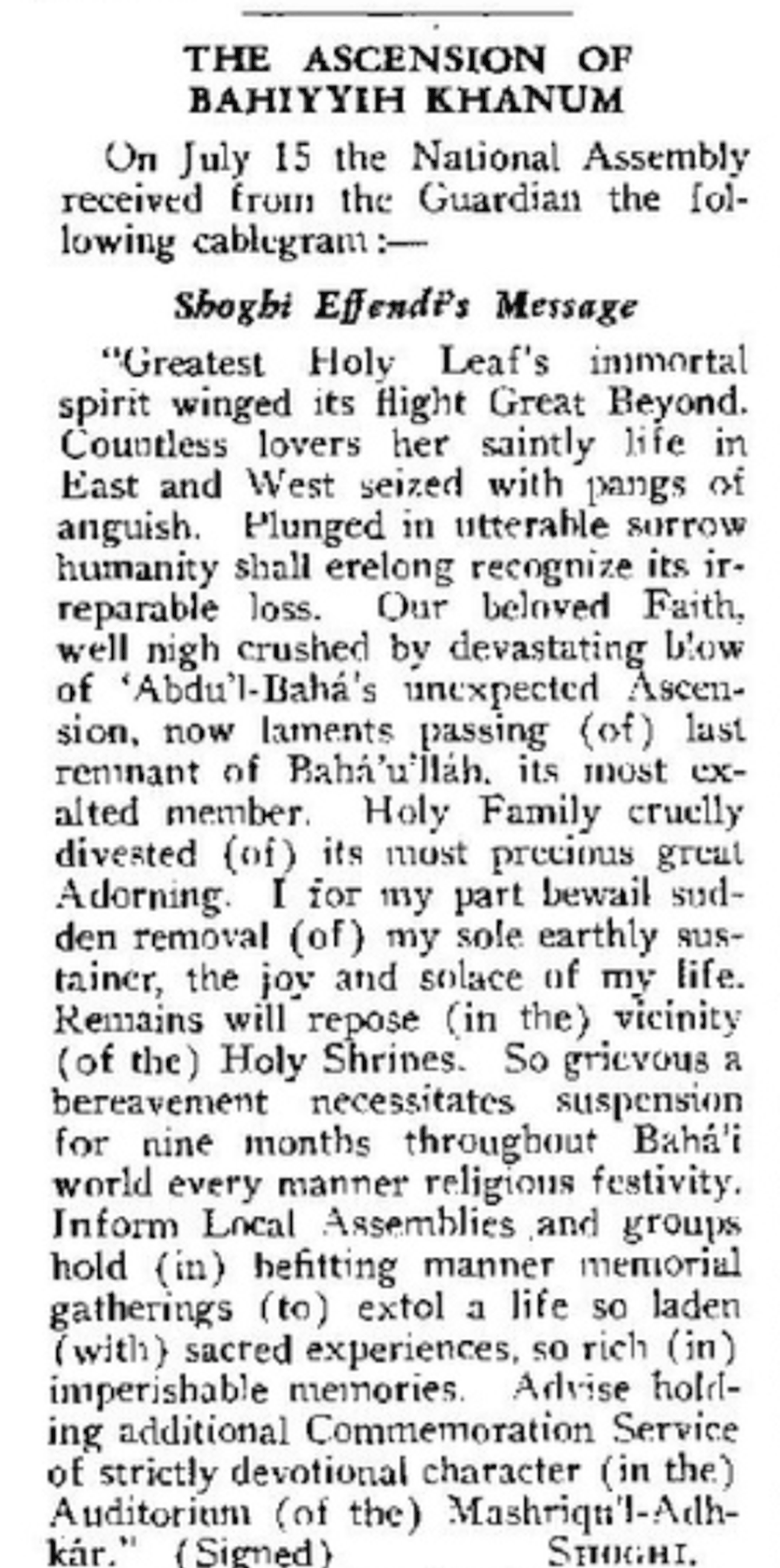
That same day, the Guardian cabled the National Spiritual Assembly of the United States and Canada:
Greatest Holy Leaf’s immortal spirit winged its flight great beyond countless lovers her saintly life in east and west seized with pangs of anguish, plunged in unutterable sorrow. Humanity shall ere long recognize its irreparable loss. Our beloved Faith, well-nigh crushed by devastating blow of ‘Abdu’l-Bahá unexpected Ascension, now laments passing last remnant of Bahá’u’lláh its most exalted member. Holy family cruelly divested its most precious most great adorning. I, for my part, bewail sudden removal my sole earthly sustainer the joy and solace of my life. Her sacred remains will repose vicinity holy shrines. So grievous a bereavement necessitates suspension for nine months throughout Bahá’í world every manner religious festivity. Inform local assemblies and groups hold befitting manner memorial gatherings extol a life so laden sacred experiences, so rich imperishable memories. Advise holding additional commemoration service of strictly devotional character auditorium Mashriqu’l-Adhkár.
The next step for Shoghi Effendi was to build a beautiful monument for the Greatest Holy Leaf. Immediately after sending the letters to the Bahá'í World and asking for nine months of mourning in memory of the Greatest Holy Leaf, he traveled from Switzerland to Italy to commission a befitting, magnificent, memorial Monument.
But it was on 17 July that he wrote to the American and Canadian believers a letter that provides a glimpse of what was passing in the surging sea of his heart and in which he eulogizes the life, station and deeds of ‘Abdu’l-Bahá sister, pouring forth his love in an unforgettable torrent of words.
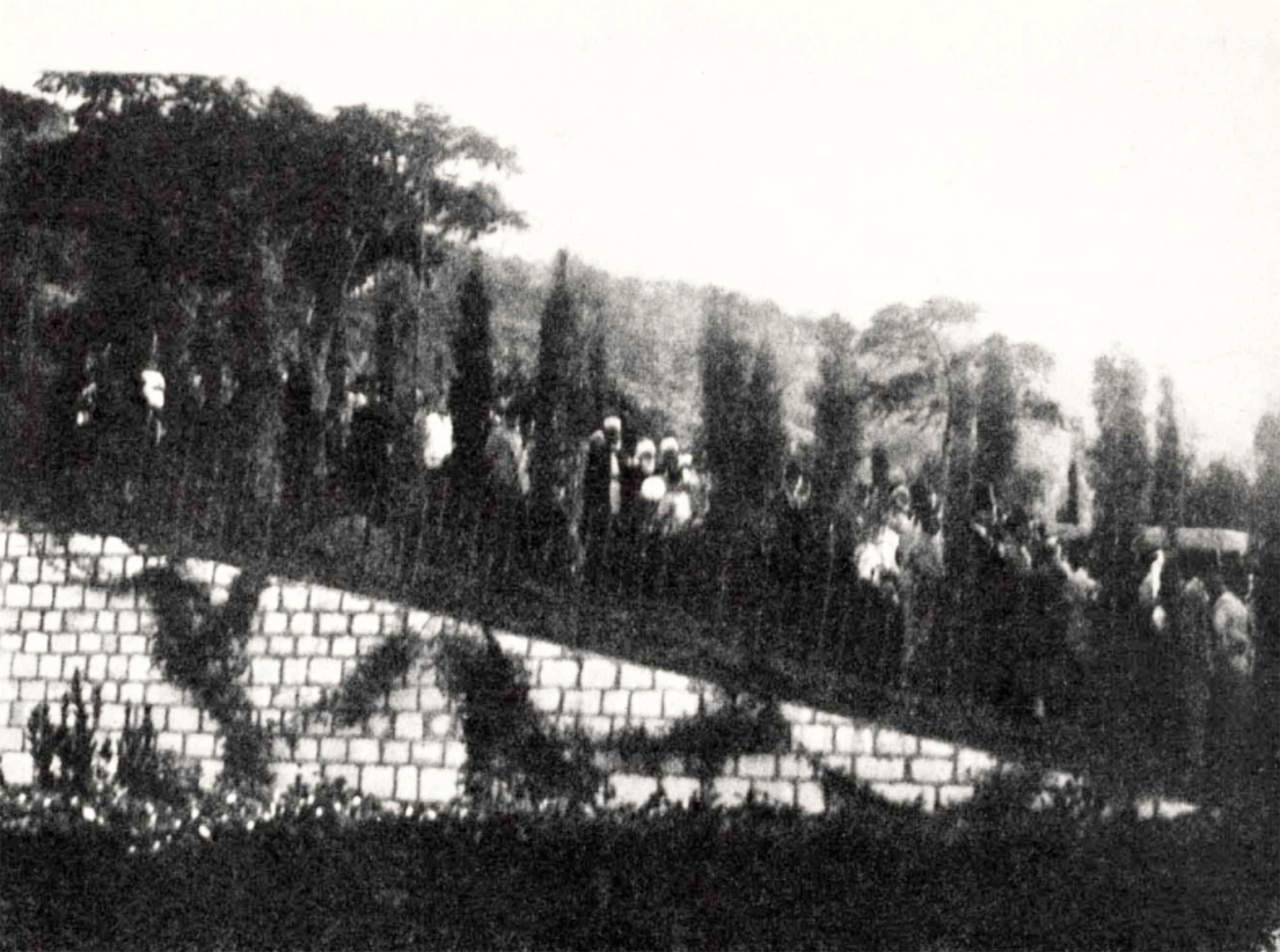
The funeral cortege of the Greatest Holy Leaf approaching the Shrine of the Báb. Source: Bahaimedia.
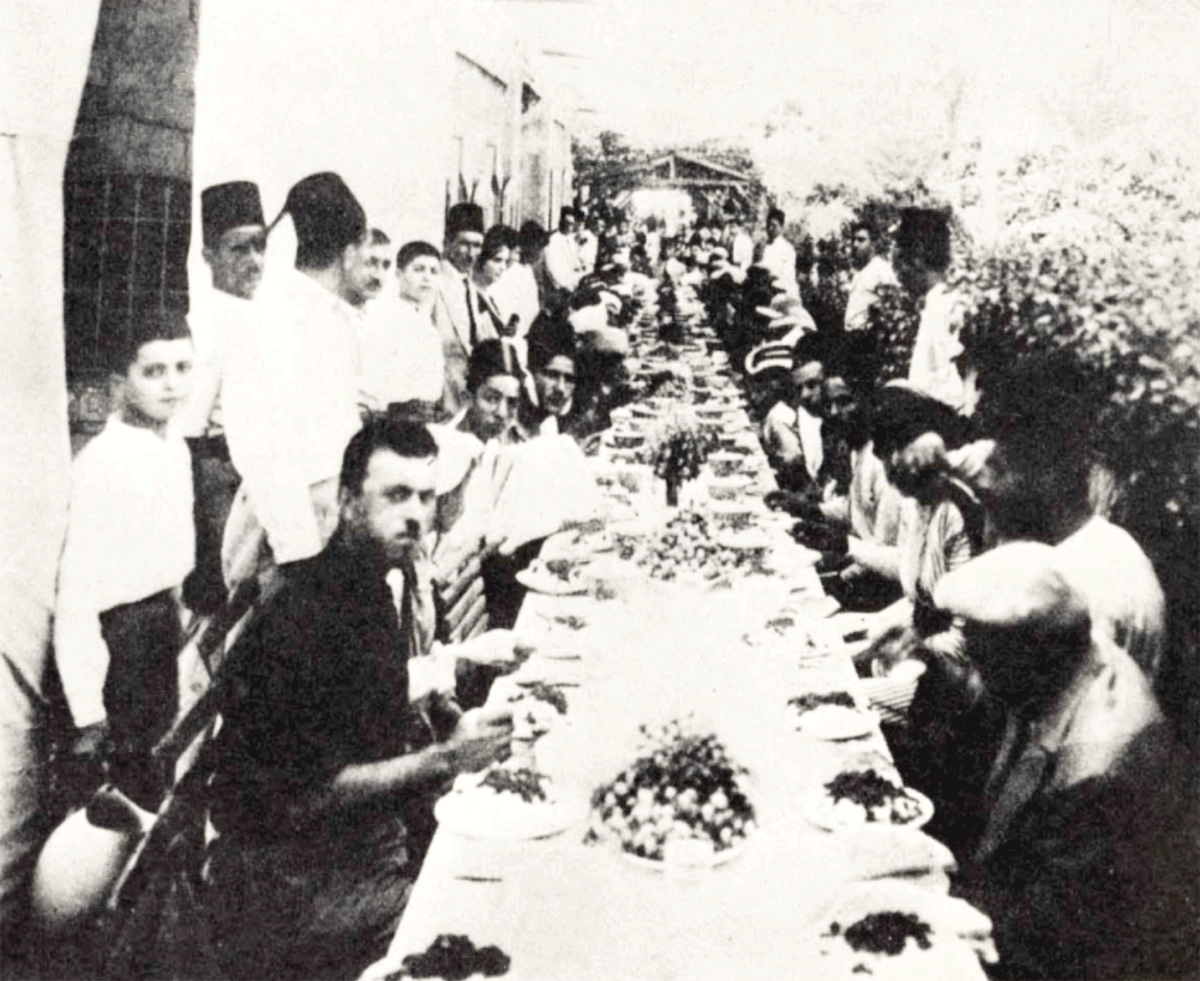
Feast given to the poor in Haifa in memory of the Greatest Holy Leaf first printed in The Bahá'í World Volume 5, page 183. Source: Bahaimedia.
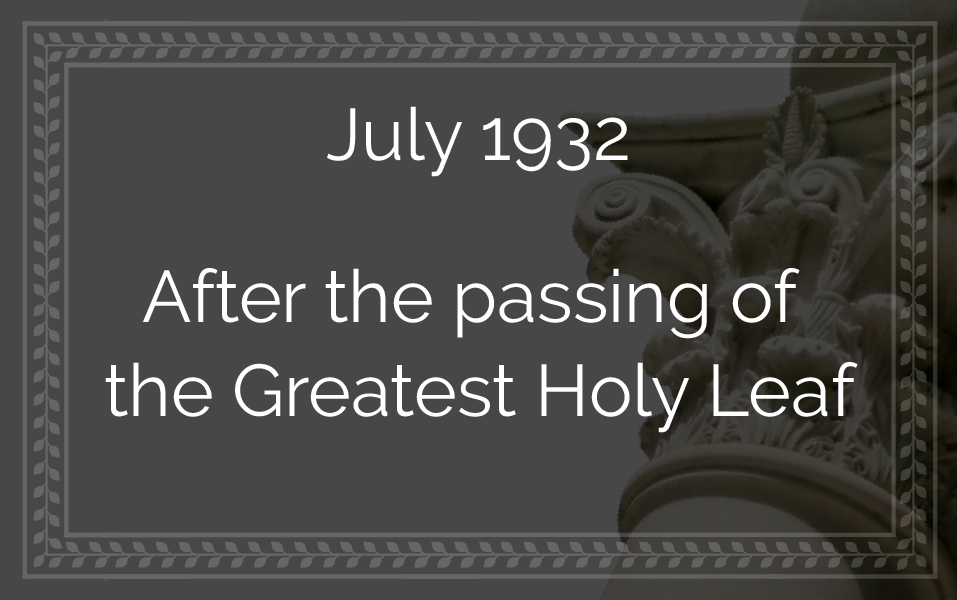
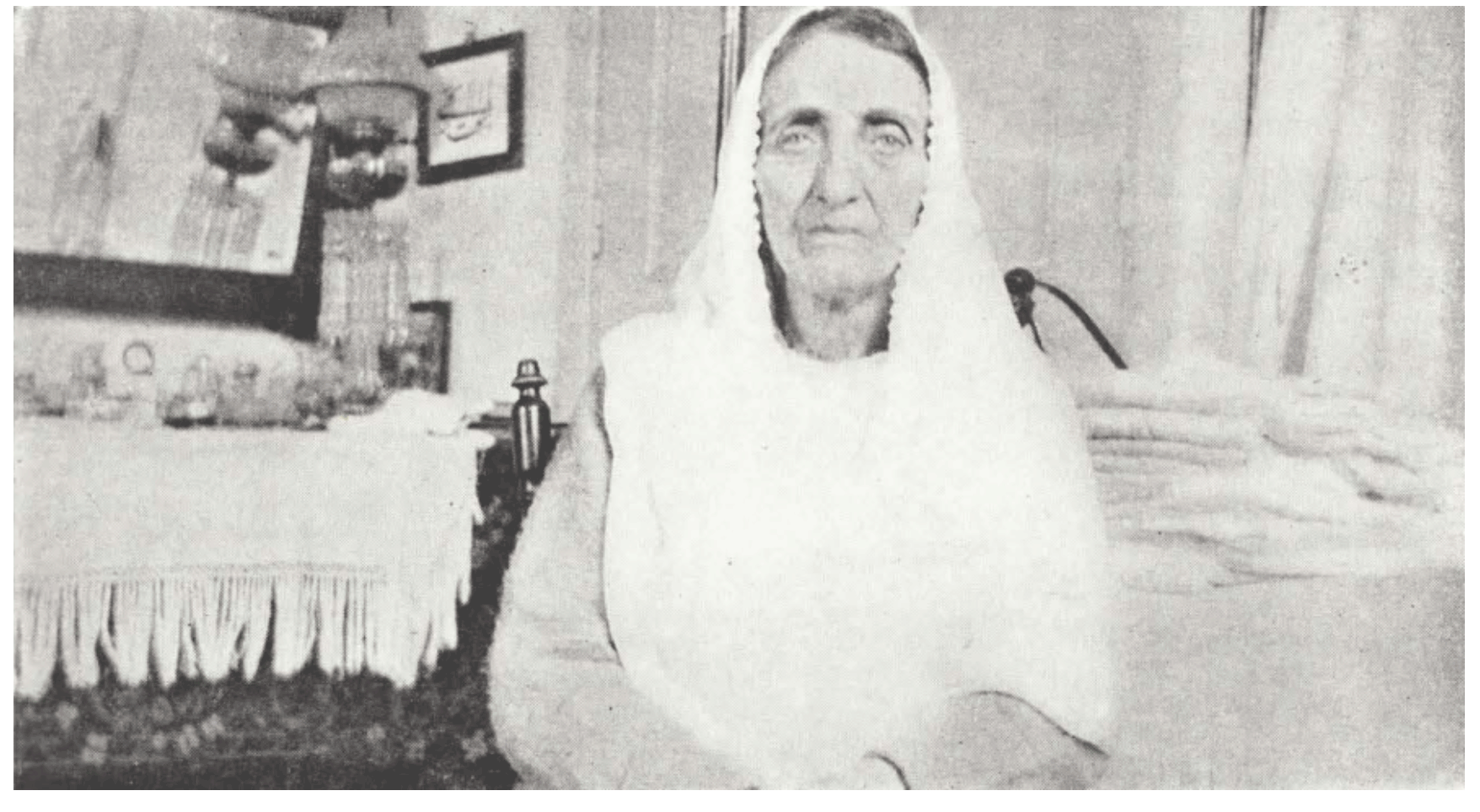
A portrait of the Greatest Holy Leaf from The Bahá'í World Volume 2 page 83. Source: Bahaimedia.
Shoghi Effendi was painfully aware of male historians’ tendency to leave out women in their narratives. He ensured this would never happen to Bahíyyih Khánum when he penned an extraordinary 8-page, 37-paragraph, 3,645-word eulogy for the Greatest Holy Leaf two days after her passing on 17 July 1932, as he was preparing to leave Switzerland.
This letter is so important—one of only five letters the Guardian sent simultaneously in English to the Bahá'ís of the West and in Persian to the Bahá'ís of the East—that it is it is presented in a thematical analysis and also reproduced below in its entirety.
In this eulogy, Shoghi Effendi addresses the following themes: the devastating grief and sorrow and grief of the Guardian and the Bahá'í community, Bahíyyih Khánum’s station in Bahá'í history and the story of her life and sufferings from Persia, to Iraq, Turkey, and the Holy Land, Her self-sacrificing nature and her noble spiritual qualities, Her role during the ministry of 'Abdu'l-Bahá—particularly during His Journeys to the West and during World War I—Her role immediately after the Ascension of 'Abdu'l-Bahá and the Tablets Bahá'u'lláh and 'Abdu'l-Bahá revealed regarding her station and character, a one-paragraph quote from a Tablet revealed by 'Abdu'l-Bahá to Munírih Khánum addressing the Greatest Holy Leaf as “my honored and distinguished sister.”
The last five paragraphs are written in traditional Persian fashion, where Shoghi Effendi addresses himself in the language of prayer to the Greatest Holy Leaf, gazing through tears at her blue, love-deep eyes, remembering her, cherishing her, asking her to convey a message to 'Abdu'l-Bahá, and begging prayers for the Guardian of the Faith of Bahá'u'lláh, and for the Bahá'ís. This poem-eulogy ends with a promise to the Greatest Holy Leaf that the Bahá'ís built in the innermost recesses of their heart a shining mansion untouched by the hand of time, an altar where the fire of her consuming love will burn forever.
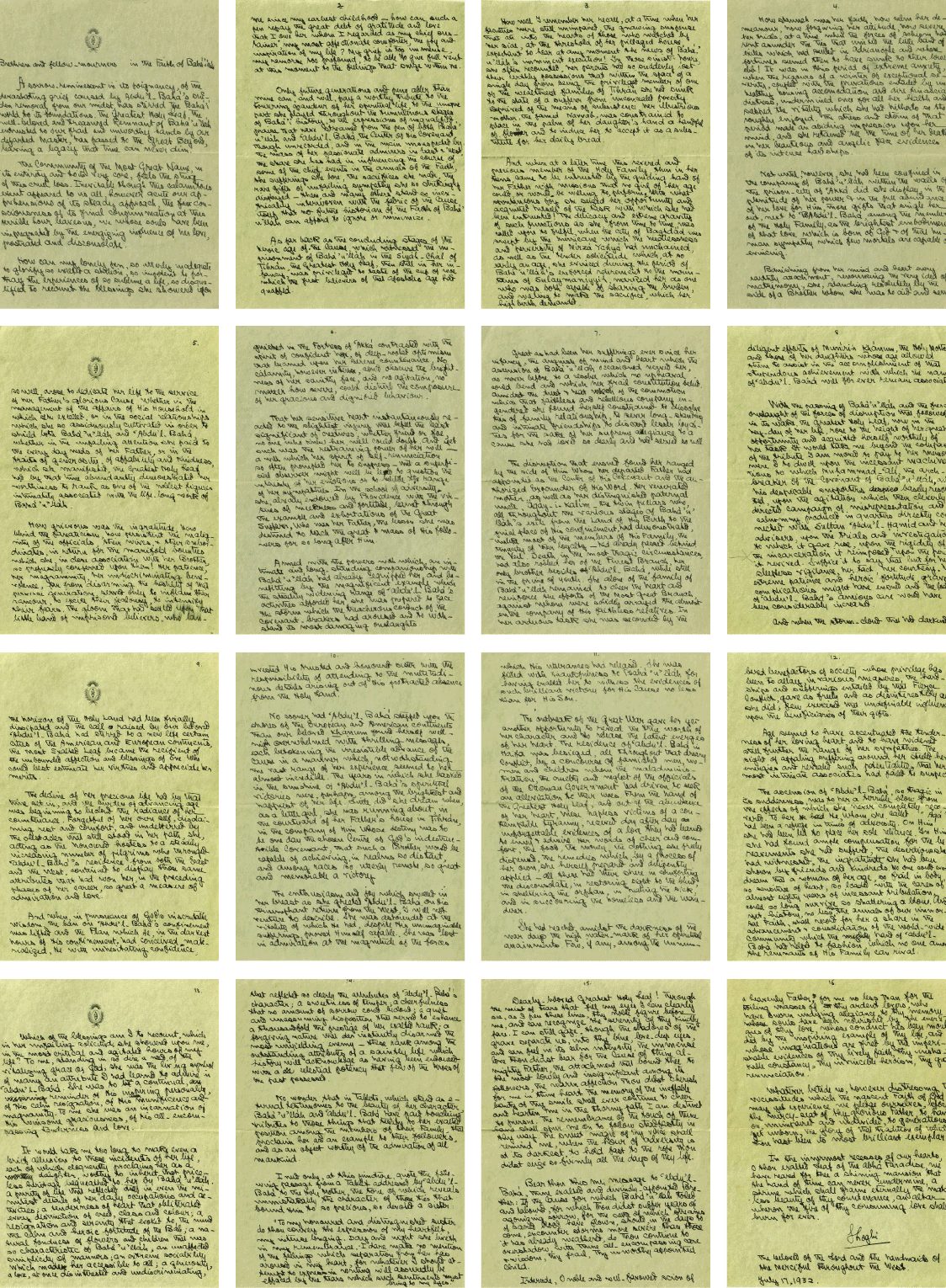
Source of the handwritten pages of Shoghi Effendi’s eulogy to the Greatest Holy Leaf: Bahá'í Library Online.
This is the Guardian’s full eulogy for the Greatest Holy Leaf, originally written on 16 pages in his own handwriting, and sent to the Bahá'í world on 17 July 1932, two days after her passing:
The beloved of God and the handmaids of the Merciful throughout the United States and Canada.
Brethren and fellow-mourners in the Faith of Bahá’u’lláh:
A sorrow, reminiscent in its poignancy, of the devastating grief caused by ‘Abdu’l‑Bahá’s sudden removal from our midst, has stirred the Bahá’í world to its foundations. The Greatest Holy Leaf, the well-beloved and treasured Remnant of Bahá’u’lláh entrusted to our frail and unworthy hands by our departed Master, has passed to the Great Beyond, leaving a legacy that time can never dim.
The community of the Most Great Name, in its entirety and to its very core, feels the sting of this cruel loss. Inevitable though this calamitous event appeared to us all, however acute our apprehensions of its steady approach, the consciousness of its final consummation at this terrible hour leaves us, we whose souls have been impregnated by the energizing influence of her love, prostrated and disconsolate.
How can my lonely pen, so utterly inadequate to glorify so exalted a station, so impotent to portray the experiences of so sublime a life, so disqualified to recount the blessings she showered upon me since my earliest childhood—how can such a pen repay the great debt of gratitude and love that I owe her whom I regarded as my chief sustainer, my most affectionate comforter, the joy and inspiration of my life? My grief is too immense, my remorse too profound, to be able to give full vent at this moment to the feelings that surge within me.
Only future generations and pens abler than mine can, and will, pay a worthy tribute to the towering grandeur of her spiritual life, to the unique part she played throughout the tumultuous stages of Bahá’í history, to the expressions of unqualified praise that have streamed from the pen of both Bahá’u’lláh and ‘Abdu’l‑Bahá, the Center of His covenant, though unrecorded, and in the main unsuspected by the mass of her admirers in East and West, the share she has had in influencing the course of some of the chief events in the annals of the Faith, the sufferings she bore, the sacrifices she made, the rare gifts of unfailing sympathy she so strikingly displayed—these, and many others stand so inextricably interwoven with the fabric of the Cause itself that no future historian of the Faith of Bahá’u’lláh can afford to ignore or minimize.
As far back as the concluding stages of the heroic age of the Cause, which witnessed the imprisonment of Bahá’u’lláh in the Síyáh-Chál of Ṭihrán, the Greatest Holy Leaf, then still in her infancy, was privileged to taste of the cup of woe which the first believers of that apostolic age had quaffed.
How well I remember her recall, at a time when her faculties were still unimpaired, the gnawing suspense that ate into the hearts of those who watched by her side, at the threshold of her pillaged house, expectant to hear at any moment the news of Bahá’u’lláh’s imminent execution! In those sinister hours, she often recounted, her parents had so suddenly lost their earthly possessions that within the space of a single day from being the privileged member of one of the wealthiest families of Ṭihrán she had sunk to the state of a sufferer from unconcealed poverty. Deprived of the means of subsistence, her illustrious mother, the famed Navváb, was constrained to place in the palm of her daughter’s hand a handful of flour and to induce her to accept it as a substitute for her daily bread.
And when at a later time this revered and precious member of the Holy Family, then in her teens, came to be entrusted by the guiding hand of her Father with missions that no girl of her age could, or would be willing to, perform, with what spontaneous joy she seized her opportunity and acquitted herself of the task with which she had been entrusted! The delicacy and extreme gravity of such functions as she, from time to time, was called upon to fulfill, when the city of Baghdád was swept by the hurricane which the heedlessness and perversity of Mírzá Yaḥyá had unchained, as well as the tender solicitude which, at so early an age, she evinced during the period of Bahá’u’lláh’s enforced retirement to the mountains of Sulaymáníyyih, marked her as one who was both capable of sharing the burden, and willing to make the sacrifice, which her high birth demanded.
How staunch was her faith, how calm her demeanor, how forgiving her attitude, how severe her trials, at a time when the forces of schism had rent asunder the ties that united the little band of exiles which had settled in Adrianople and whose fortunes seemed then to have sunk to their lowest ebb! It was in this period of extreme anxiety, when the rigors of a winter of exceptional severity, coupled with the privations entailed by unhealthy housing accommodations and dire financial distress, undermined once for all her health and sapped the vitality which she had hitherto so thoroughly enjoyed. The stress and storm of that period made an abiding impression upon her mind, and she retained till the time of her death on her beauteous and angelic face evidences of its intense hardships.
Not until, however, she had been confined in the company of Bahá’u’lláh within the walls of the prison-city of ‘Akká did she display, in the plenitude of her power and in the full abundance of her love for Him, more gifts that single her out, next to ‘Abdu’l‑Bahá, among the members of the Holy Family, as the brightest embodiment of that love which is born of God and of that human sympathy which few mortals are capable of evincing.
Banishing from her mind and heart every earthly attachment, renouncing the very idea of matrimony, she, standing resolutely by the side of a Brother whom she was to aid and serve so well, arose to dedicate her life to the service of her Father’s glorious Cause. Whether in the management of the affairs of His Household in which she excelled, or in the social relationships which she so assiduously cultivated in order to shield both Bahá’u’lláh and ‘Abdu’l‑Bahá, whether in the unfailing attention she paid to the everyday needs of her Father, or in the traits of generosity, of affability and kindness, which she manifested, the Greatest Holy Leaf had by that time abundantly demonstrated her worthiness to rank as one of the noblest figures intimately associated with the life-long work of Bahá’u’lláh.
How grievous was the ingratitude, how blind the fanaticism, how persistent the malignity of the officials, their wives, and their subordinates, in return for the manifold bounties which she, in close association with her Brother, so profusely conferred upon them! Her patience, her magnanimity, her indiscriminating benevolence, far from disarming the hostility of that perverse generation, served only to inflame their rancour, to excite their jealousy, to intensify their fears. The gloom that had settled upon that little band of imprisoned believers, who languished in the Fortress of ‘Akká, contrasted with the spirit of confident hope, of deep-rooted optimism that beamed upon her serene countenance. No calamity, however intense, could obscure the brightness of her saintly face, and no agitation, no matter how severe, could disturb the composure of her gracious and dignified behaviour.
That her sensitive heart instantaneously reacted to the slightest injury that befell the least significant of creatures, whether friend or foe, no one who knew her well could doubt. And yet such was the restraining power of her will—a will which her spirit of self-renunciation so often prompted her to suppress—that a superficial observer might well be led to question the intensity of her emotions or to belittle the range of her sympathies. In the school of adversity she, already endowed by Providence with the virtues of meekness and fortitude, learned through the example and exhortations of the Great Sufferer, who was her Father, the lesson she was destined to teach the great mass of His followers for so long after Him.
Armed with the powers with which an intimate and long-standing companionship with Bahá’u’lláh had already equipped her, and benefiting by the magnificent example which the steadily widening range of ‘Abdu’l‑Bahá’s activities afforded her, she was prepared to face the storm which the treacherous conduct of the Covenant-breakers had aroused and to withstand its most damaging onslaughts.
Great as had been her sufferings ever since her infancy, the anguish of mind and heart which the Ascension of Bahá’u’lláh occasioned, nerved her, as never before, to a resolve which no upheaval could bend and which her frail constitution belied. Amidst the dust and heat of the commotion which that faithless and rebellious company engendered she found herself constrained to dissolve ties of family relationship, to sever long-standing and intimate friendships, to discard lesser loyalties for the sake of her supreme allegiance to a Cause she had loved so dearly and had served so well.
The disruption that ensued found her ranged by the side of Him Whom her departed Father had appointed as the Center of His Covenant and the authorized Expounder of His Word. Her venerated mother, as well as her distinguished paternal uncle, Áqáy-i-Kalím—the twin pillars who, all throughout the various stages of Bahá’u’lláh’s exile from the Land of His Birth to the final place of His confinement, had demonstrated, unlike most of the members of His Family, the tenacity of their loyalty—had already passed behind the Veil. Death, in the most tragic circumstances, had also robbed her of the Purest Branch, her only brother besides ‘Abdu’l‑Bahá, while still in the prime of youth. She alone of the family of Bahá’u’lláh remained to cheer the heart and reinforce the efforts of the Most Great Branch, against whom were solidly arrayed the almost entire company of His faithless relatives. In her arduous task she was seconded by the diligent efforts of Munírih Khánum, the Holy Mother, and those of her daughters whose age allowed them to assist in the accomplishment of that stupendous achievement with which the name of ‘Abdu’l‑Bahá will forever remain associated.
With the passing of Bahá’u’lláh and the fierce onslaught of the forces of disruption that followed in its wake, the Greatest Holy Leaf, now in the hey-day of her life, rose to the height of her great opportunity and acquitted herself worthily of her task. It would take me beyond the compass of the tribute I am moved to pay to her memory were I to dwell upon the incessant machinations to which Muḥammad-‘Alí, the arch-breaker of the Covenant of Bahá’u’lláh, and his despicable supporters basely resorted, upon the agitation which their cleverly-directed campaign of misrepresentation and calumny produced in quarters directly connected with Sulṭán ‘Abdu’l-Ḥamíd and his advisers, upon the trials and investigations to which it gave rise, upon the rigidity of the incarceration it reimposed, and upon the perils it revived. Suffice it to say that but for her sleepless vigilance, her tact, her courtesy, her extreme patience and heroic fortitude, grave complications might have ensued and the load of ‘Abdu’l‑Bahá’s anxious care would have been considerably increased.
And when the storm-cloud that had darkened the horizon of the Holy Land had been finally dissipated and the call raised by our beloved ‘Abdu’l‑Bahá had stirred to a new life certain cities of the American and European continents, the Most Exalted Leaf became the recipient of the unbounded affection and blessings of One Who could best estimate her virtues and appreciate her merits.
The decline of her precious life had by that time set in, and the burden of advancing age was beginning to becloud the radiance of her countenance. Forgetful of her own self, disdaining rest and comfort, and undeterred by the obstacles that still stood in her path, she, acting as the honoured hostess to a steadily increasing number of pilgrims who thronged ‘Abdu’l‑Bahá’s residence from both the East and the West, continued to display those same attributes that had won her, in the preceding phases of her career, so great a measure of admiration and love.
And when, in pursuance of God’s inscrutable Wisdom, the ban on ‘Abdu’l‑Bahá’s confinement was lifted and the Plan which He, in the darkest hours of His confinement, had conceived materialized, He with unhesitating confidence, invested His trusted and honoured sister with the responsibility of attending to the multitudinous details arising out of His protracted absence from the Holy Land.
No sooner had ‘Abdu’l‑Bahá stepped upon the shores of the European and American continents than our beloved Khánum found herself well-nigh overwhelmed with thrilling messages, each betokening the irresistible advance of the Cause in a manner which, notwithstanding the vast range of her experience, seemed to her almost incredible. The years in which she basked in the sunshine of ‘Abdu’l‑Bahá’s spiritual victories were, perhaps, among the brightest and happiest of her life. Little did she dream when, as a little girl, she was running about, in the courtyard of her Father’s house in Ṭihrán, in the company of Him Whose destiny was to be one day the chosen Center of God’s indestructible Covenant, that such a Brother would be capable of achieving, in realms so distant, and among races so utterly remote, so great and memorable a victory.
The enthusiasm and joy which swelled in her breast as she greeted ‘Abdu’l‑Bahá on His triumphant return from the West, I will not venture to describe. She was astounded at the vitality of which He had, despite His unimaginable sufferings, proved Himself capable. She was lost in admiration at the magnitude of the forces which His utterances had released. She was filled with thankfulness to Bahá’u’lláh for having enabled her to witness the evidences of such brilliant victory for His Cause no less than for His Son.
The outbreak of the Great War gave her yet another opportunity to reveal the true worth of her character and to release the latent energies of her heart. The residence of ‘Abdu’l‑Bahá in Haifa was besieged, all throughout that dreary conflict, by a concourse of famished men, women and children whom the maladministration, the cruelty and neglect of the officials of the Ottoman Government had driven to seek an alleviation to their woes. From the hand of the Greatest Holy Leaf, and out of the abundance of her heart, these hapless victims of a contemptible tyranny, received day after day unforgettable evidences of a love they had learned to envy and admire. Her words of cheer and comfort, the food, the money, the clothing she freely dispensed, the remedies which, by a process of her own, she herself prepared and diligently applied—all these had their share in comforting the disconsolate, in restoring sight to the blind, in sheltering the orphan, in healing the sick, and in succoring the homeless and the wanderer.
She had reached, amidst the darkness of the war days, the high water-mark of her spiritual attainments. Few, if any, among the unnumbered benefactors of society whose privilege has been to allay, in various measures, the hardships and sufferings entailed by that Fierce Conflict, gave as freely and as disinterestedly as she did; few exercised that undefinable influence upon the beneficiaries of their gifts.
Age seemed to have accentuated the tenderness of her loving heart, and to have widened still further the range of her sympathies. The sight of appalling suffering around her steeled her energies and revealed such potentialities that her most intimate associates had failed to suspect.
The ascension of ‘Abdu’l‑Bahá, so tragic in its suddenness, was to her a terrific blow, from the effects of which she never completely recovered. To her He, whom she called “Áqá,” had been a refuge in times of adversity. On Him she had been led to place her sole reliance. In Him she had found ample compensation for the bereavements she had suffered, the desertions she had witnessed, the ingratitude she had been shown by friends and kindreds. No one could ever dream that a woman of her age, so frail in body, so sensitive of heart, so loaded with the cares of almost eighty years of incessant tribulation, could so long survive so shattering a blow. And yet history, no less than the annals of our immortal Faith, shall record for her a share in the advancement and consolidation of the world-wide community which the hand of ‘Abdu’l‑Bahá had helped to fashion, which no one among the remnants of His Family can rival.
Which of the blessings am I to recount, which in her unfailing solicitude she showered upon me, in the most critical and agitated hours of my life? To me, standing in so dire a need of the vitalizing grace of God, she was the living symbol of many an attribute I had learned to admire in ‘Abdu’l‑Bahá. She was to me a continual reminder of His inspiring personality, of His calm resignation, of His munificence and magnanimity. To me she was an incarnation of His winsome graciousness, of His all-encompassing tenderness and love.
It would take me too long to make even a brief allusion to those incidents of her life, each of which eloquently proclaims her as a daughter, worthy to inherit that priceless heritage bequeathed to her by Bahá’u’lláh. A purity of life that reflected itself in even the minutest details of her daily occupations and activities; a tenderness of heart that obliterated every distinction of creed, class and color; a resignation and serenity that evoked to the mind the calm and heroic fortitude of the Báb; a natural fondness of flowers and children that was so characteristic of Bahá’u’lláh; an unaffected simplicity of manners; an extreme sociability which made her accessible to all; a generosity, a love, at once disinterested and indiscriminating, that reflected so clearly the attributes of ‘Abdu’l‑Bahá’s character; a sweetness of temper; a cheerfulness that no amount of sorrow could becloud; a quiet and unassuming disposition that served to enhance a thousandfold the prestige of her exalted rank; a forgiving nature that instantly disarmed the most unyielding enemy—these rank among the outstanding attributes of a saintly life which history will acknowledge as having been endowed with a celestial potency that few of the heroes of the past possessed.
No wonder that in Tablets, which stand as eternal testimonies to the beauty of her character, Bahá’u’lláh and ‘Abdu’l‑Bahá have paid touching tributes to those things that testify to her exalted position among the members of their Family, that proclaim her as an example to their followers, and as an object worthy of the admiration of all mankind.
I need only, at this juncture, quote the following passage from a Tablet addressed by ‘Abdu’l‑Bahá to the Holy Mother, the tone of which reveals unmistakably the character of those ties that bound Him to so precious, so devoted a sister:
“To my honored and distinguished sister do thou convey the expression of my heartfelt, my intense longing. Day and night she liveth in my remembrance. I dare make no mention of the feelings which separation from her has aroused in my heart, for whatever I should attempt to express in writing will assuredly be effaced by the tears which such sentiments must bring to my eyes.”
Dearly-beloved Greatest Holy Leaf! Through the mist of tears that fill my eyes I can clearly see, as I pen these lines, thy noble figure before me, and can recognize the serenity of thy kindly face. I can still gaze, though the shadow of the grave separate us, into thy blue, love-deep eyes, and can feel, in its calm intensity, the immense love thou didst bear for the Cause of thine Almighty Father, the attachment that bound thee to the most lowly and insignificant among its followers, the warm affection thou didst cherish for me in thine heart. The memory of the ineffable beauty of thy smile shall ever continue to cheer and hearten me in the thorny path I am destined to pursue. The remembrance of the touch of thine hand shall spur me on to follow steadfastly in thy way. The sweet magic of thy voice shall remind me, when the hour of adversity is at its darkest, to hold fast to the rope thou didst seize so firmly all the days of thy life.
Bear thou this my message to ‘Abdu’l‑Bahá, thine exalted and divinely-appointed Brother: If the Cause for which Bahá’u’lláh toiled and labored, for which Thou didst suffer years of agonizing sorrow, for the sake of which streams of sacred blood have flowed, should, in the days to come, encounter storms more severe than those it has already weathered, do Thou continue to overshadow, with Thine all-encompassing care and wisdom, Thy frail, Thy unworthy appointed child.
Intercede, O noble and well-favoured scion of a heavenly Father, for me no less than for the toiling masses of Thy ardent lovers, who have sworn undying allegiance to Thy memory, whose souls have been nourished by the energies of Thy love, whose conduct has been moulded by the inspiring example of Thy life, and whose imaginations are fired by the imperishable evidences of Thy lively faith, Thy unshakable constancy, Thy invincible heroism, Thy great renunciation.
Whatever betide us, however distressing the vicissitudes which the nascent Faith of God may yet experience, we pledge ourselves, before the mercy-seat of thy glorious Father, to hand on, unimpaired and undivided, to generations yet unborn, the glory of that tradition of which thou hast been its most brilliant exemplar.
In the innermost recesses of our hearts, O thou exalted Leaf of the Abhá Paradise, we have reared for thee a shining mansion that the hand of time can never undermine, a shrine which shall frame eternally the matchless beauty of thy countenance, an altar whereon the fire of thy consuming love shall burn forever.
Shoghi.
Haifa, Palestine.
July 17, 1932.
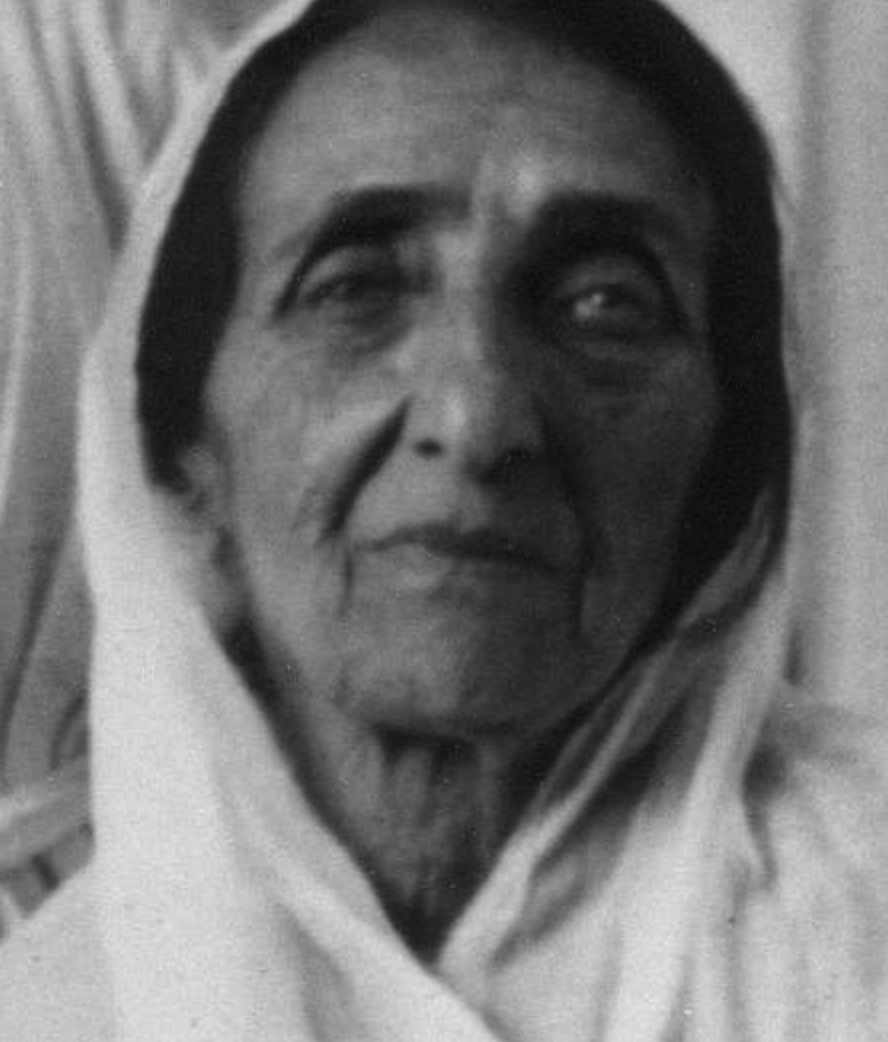
A portrait of the Greatest Holy Leaf. Source: Bahá'í Biblio.
In God Passes By, Shoghi Effendi states in no uncertain terms that the station of the Greatest Holy Leaf is comparable to Sarah in the Old Testament, to the Virgin Mary, mother of Jesus Christ, to Fáṭimih, the holy daughter of the Prophet Muḥammad, and to Ṭáhirih, the only woman among the Báb’s 18 Letters of the Living. These women, one and all outshone the other women of the Mosaic, Christian, Islamic, and Bábí Dispensation.
Bahíyyih Khánum, the Greatest Holy Leaf was the Outstanding Heroine of the Bahá'í Dispensation.
After the Greatest Holy Leaf’s passing, Shoghi Effendi endeavored, until the very end of his life to make her station understandable to Bahá'ís. In a letter dated 14 January 1933 to the Bahá'ís of the United States and Canada, Shoghi Effendi stated that Bahíyyih Khánum personified the attributes of Bahá'u'lláh:
To this bear witness the Company on High, and beyond them God Himself, the Supreme Lord of all the heavens and the earths: that during all thy days, from thine earliest years until the close of thy life, thou didst personify the attributes of thy Father, the Matchless, the Mighty. Thou wert the fruit of His Tree, thou wert the lamp of His love, thou wert the symbol of His serenity, and of His meekness, the pathway of His guidance, the channel of His blessings, the sweet scent of His robe, the refuge of His loved ones and His handmaidens, the mantle of His generosity and grace.
Shoghi Effendi referred to the Greatest Holy Leaf as the "well-beloved" sister of `Abdu'l-Bahá, the "Leaf that hath sprung" from the "Pre-existent Root," and the "fragrance" of Bahá'u'lláh's "shining robe," elevated by Bahá'u'lláh to a "station such as none other woman hath surpassed," and in a Persian letter dated 15 July 1932 to the Bahá'ís of the East, he penned a stunning portrait of the Greatest Holy Leaf:
In the heaven of severance, she shone like the Morning Star, fair and bright, and through her character and all her ways, she shed upon kin and stranger, upon the learned, and the lowly, the radiance of Bahá’u’lláh’s surpassing perfection…With the waters of her countless mercies, she brought thorny hearts to a blossoming of love from the All-Glorious, and with the influence of her pure loving-kindness, transformed the implacable, the unyielding, into impassioned lovers of the celestial Beauty’s peerless Cause.
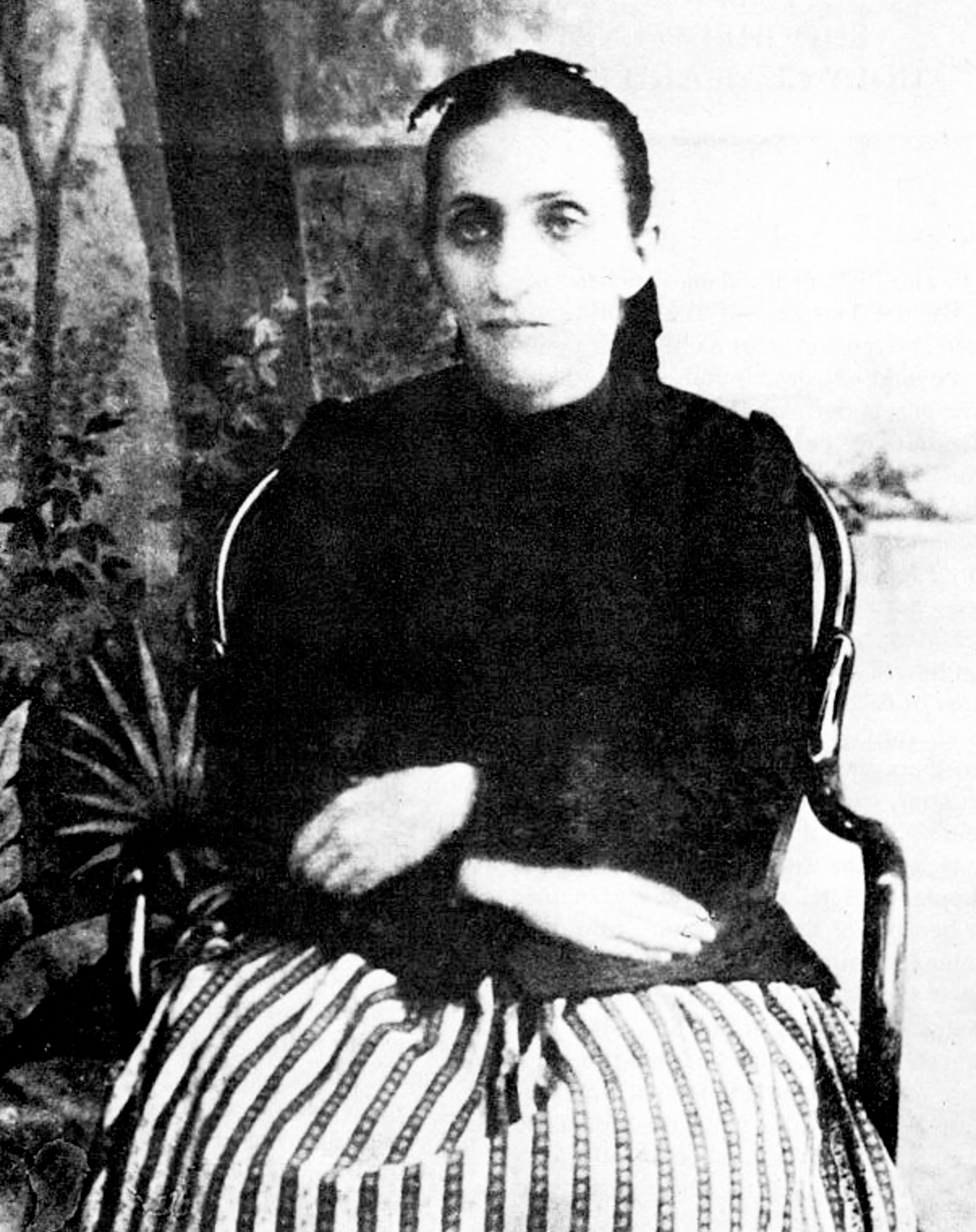
The Greatest Holy Leaf in 1890. This photograph was taken while Bahíyyih Khánum’s Father, Bahá'u'lláh, was still alive. Source: Bahaimedia.
When Bahíyyih Khánum came of age, she was left free to decide what her life was going to be, whether she would be a wife or a mother, or choose another path for herself. She chose to devote her entire life to Bahá'u'lláh and 'Abdu'l-Bahá—and in the end, to Shoghi Effendi—and remain single, unfettered by family responsibilities. She boldly chose her destiny.
For 86 years, Bahíyyih Khánum quietly but passionately served Bahá'u'lláh, 'Abdu'l-Bahá, and Shoghi Effendi. The Supreme Manifestation for this Age, the Center of His Covenant, and the Guardian of His Faith.
And no one really knew her. She had a very quiet, reserved character, and did not speak excessively, so it was easy for the thousands of pilgrims who came to the Holy Land not to really understand her extraordinary role in the Faith from the beginning of the Bábí Dispensation.
Shoghi Effendi, from the moment of her passing to the time of his death, worked very diligently to change this. He published tributes, mentioned her constantly, included her even in The Dawn-Breakers when Nabíl himself had forgotten to mention her, he published tributes, articles, mentioned her in God Passes By.
His tributes review the events of her life, her contributions to Faith in the ministries of Bahá'u'lláh, 'Abdu'l-Bahá, and let her personality shine through the many decades of selfless service that she rendered.
The Guardian highlights the Greatest Holy Leaf’s unique place in Bahá'í history, the fact that she played a role in influencing the course of major events in the history of the Heroic Age of the Faith. He lays out the immense sacrifices she made, her extraordinary sufferings, her excessively rare virtues of loyalty, dedication, unfailing sympathy, and states that one day, one day in the future, humanity would “recognize its irreparable loss.”
Bahíyyih Khánum so utterly devoted her life, consecrated her heart, mind, and soul, and her frail body to the protection and promulgation of Bahá'u'lláh’s Faith that He, in turn consecrated her.
Bahá'u'lláh bestowed on the Greatest Holy Leaf the name Bahíyyih—the feminine form of His own appellation Bahá, meaning Glory, which He confirmed in a Tablet He revealed in her honor in which He states “She hath revealed herself in My name and tasted of the sweet savours of My holy, My wondrous pleasure.”
Bahá'u'lláh further consecrated the Greatest Holy Leaf by bestowing on her a station unsurpassed by any other woman, in this powerful Tablet He revealed in her honor, a verse of which Shoghi Effendi had engraved around the dome of her resting place in the Monument Gardens:
This is My testimony for her who hath heard My voice and drawn nigh unto Me. Verily, she is a leaf that hath sprung from this pre-existant Root. She hath revealed herself in My name and tasted of the sweet savors of My holy, My wondrous pleasure. At one time We gave her to drink from My honeyed Month, at another caused her to partake of My mighty, My luminous Kawthar. Upon her rest the glory of My name and the fragrance of My shining robe.
Verily, We have elevated thee to the rank of one of the most distinguished among thy sex, and granted thee, in My court, a station such as none other woman hath surpassed. Thus have We preferred thee and raised thee above the rest, as a sign of grace from Him Who is the Lord of the throne on high and earth below. We have created thine eyes to behold the light of My countenance, thine ears to hearken unto the melody of My words, thy body to pay homage before My throne. Do thou render thanks unto God, thy Lord, the Lord of all the world.
How high is the testimony of the Sadratu’l-Muntahá for its leaf; how exalted the witness of the Tree of Life unto its fruit! Through My remembrance of her a fragrance laden with the perfume of musk hath been diffused; well is it with him that hath inhaled it…
According to Bahá'í historian Baharieh Rouhani Ma’ani, the Greatest Holy Leaf lived a pure and sanctified, holy and immaculate life, and served with an ardor, a high resolve and a selflessness that only ‘Abdu’l-Bahá excelled in the Bahá'í Dispensation.
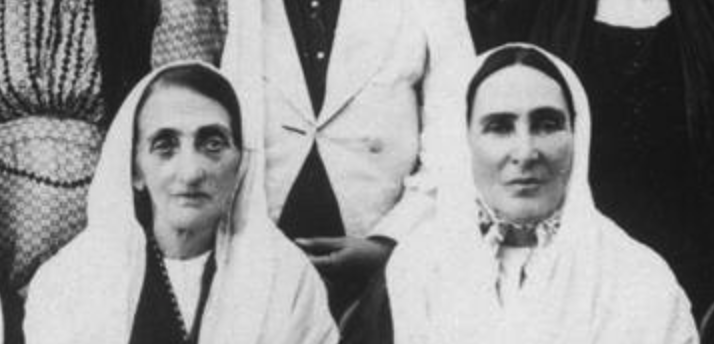
Bahíyyih Khánum and Munírih Khánum, the sister and the wife of 'Abdu'l-Bahá. Source: Bahá'í Biblio.
Shoghi Effendi loved the Greatest Holy Leaf with a burning passion and he also lent his formidable pen to give her title after title in his own writings, here are just a few, to show his love for Bahíyyih Khánum, the only person apart from 'Abdu'l-Bahá who molded his outlook, his passion, his service, and the only person apart from his Grandfather in his lifetime that he looked up to as an example:
The Most Exalted
The pure
The holy
The immaculate
The brightly shining Leaf
The Remnant of Bahá
His trust
The eternal fruit
The one last remembrance of the Holy Tree
That rich mine of faithfulness
That Orb of the heaven of eternal glory
Torch of tender love
Source of grace and mercy
Symbol of bounty and generosity
Day-spring of detachment in this world of being
Trust left by Bahá among His people
Remnant left by Him among His servants
Sweet scent of His garment
That quintessence of love and purity within the towering pavilions of eternity
This heavenly being
Never-failing spring of grace
Essence of loving-kindness
That Leaf of the eternal Lote-Tree
That rare treasure of the Lord
A trusted supporter of the peerless Branch of Bahá’u’lláh, and a companion to Him beyond compare
His competent deputy
His representative and vicegerent, with none to equal her
That most resplendent Leaf
That archetype of the people of Bahá
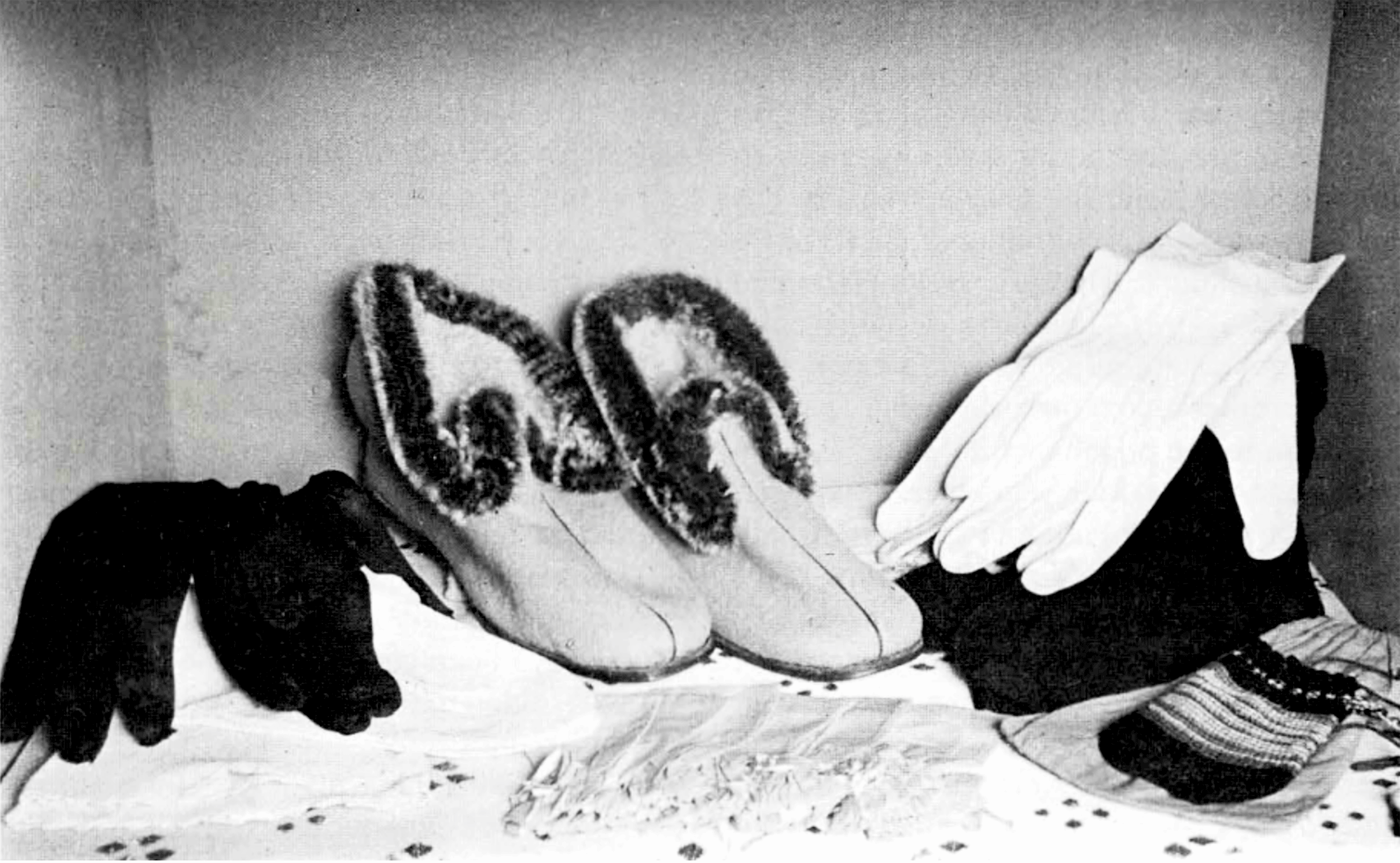
Some relics of items having belonged to the Greatest Holy Leaf and preserved in the International Bahá'í Archives. Originally published in The Bahá'í World Volume 18 page 52. Source: Bahaimedia.
In 1937, when they were on pilgrimage, Shoghi Effendi told May and Mary Maxwell that Greatest Holy Leaf was not, in fact, the most accurate translation for the title Bahá'u'lláh bestowed on His saintly daughter. He told them that the correct rendition of the Arabic “varaqiy-i-‘ulyá” was “The Most Exalted Leaf," and that the word “Holy” was not present in the Arabic.
Once the Greatest Holy Leaf had passed away, Shoghi Effendi kept mementos of her, surrounding his life with her presence.
He moved the armchair that he used to sit in when he visited his great-aunt his room and continued to use it until the end of his life.
He filled his bedroom with photographs of her from her youth to her old age, as well as beautiful photos of her Monument.
Her memory to him, became "ennobling influence...amid the wreckage of a sadly shaken world." She was his refuge in death as she had been in life.
He decorated the International Bahá'í Archives with illuminated Tablets revealed by Bahá'u'lláh in her honor, also including photographs of her and her Monument, as well as relics from her life and other mementos.
Every single great achievement he accomplished in the rest of his Guardianship, he associated with her.
In 1939, when he re-interred the remains of Ásíyih Khánum and Mírzá Mihdí, her mother and martyred young brother on Mount Carmel, very close to her resting place, he thought of her, cabling “cherished wish Greatest Holy Leaf fulfilled.”
Shoghi Effendi never forgot that the Greatest Holy Leaf had often said during her lifetime that she wanted to be buried near her beloved mother and brother.
He marked this momentous occasion by pledging £1,000 as his contribution to the Bahíyyih Khánum Fund, the last fund drive connected with the completion of the interior ornamentation of the Mother Temple of North America.
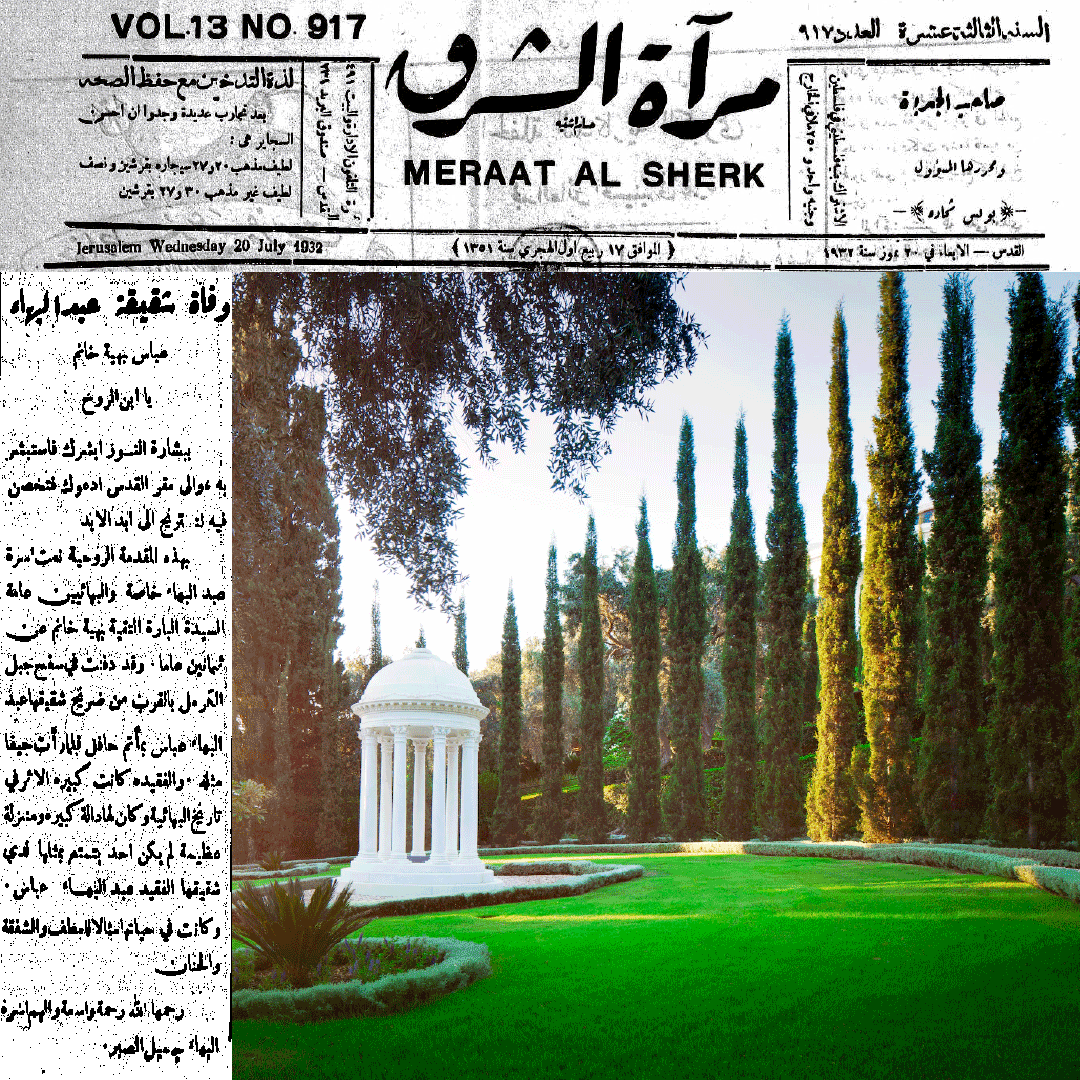
Article on the Greatest Holy Leaf's passing dated 20 July 1932 from the Jerusalem newspaper Mir’át ash-Sharq ("The Mirror of the East"). Article courtesy of Dr. Necati Alkan. Background image: A modern view of the monument for the resting place of the Greatest Holy Leaf. Source: Bahá'í Media Bank, © Bahá'í International Community 2023.
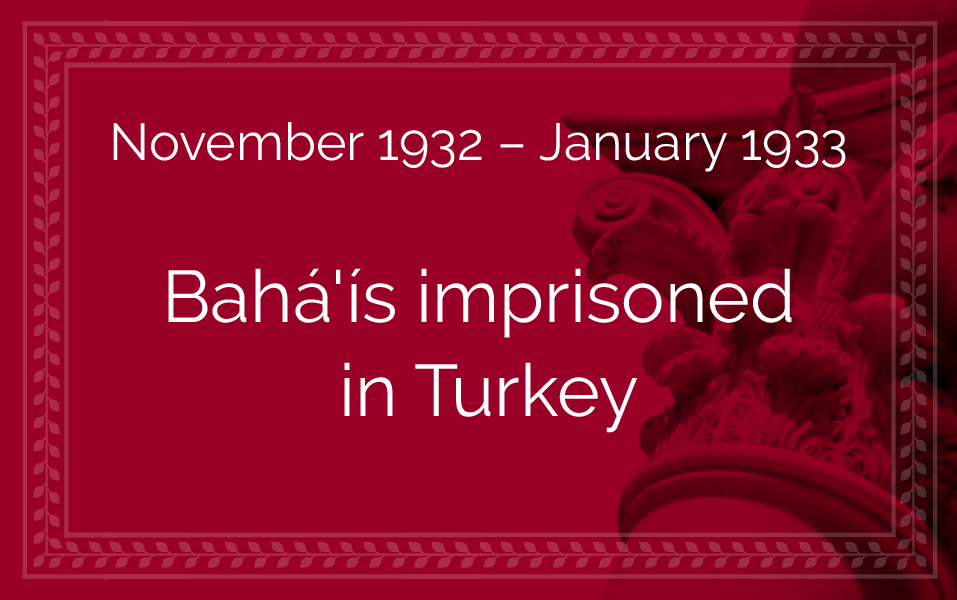
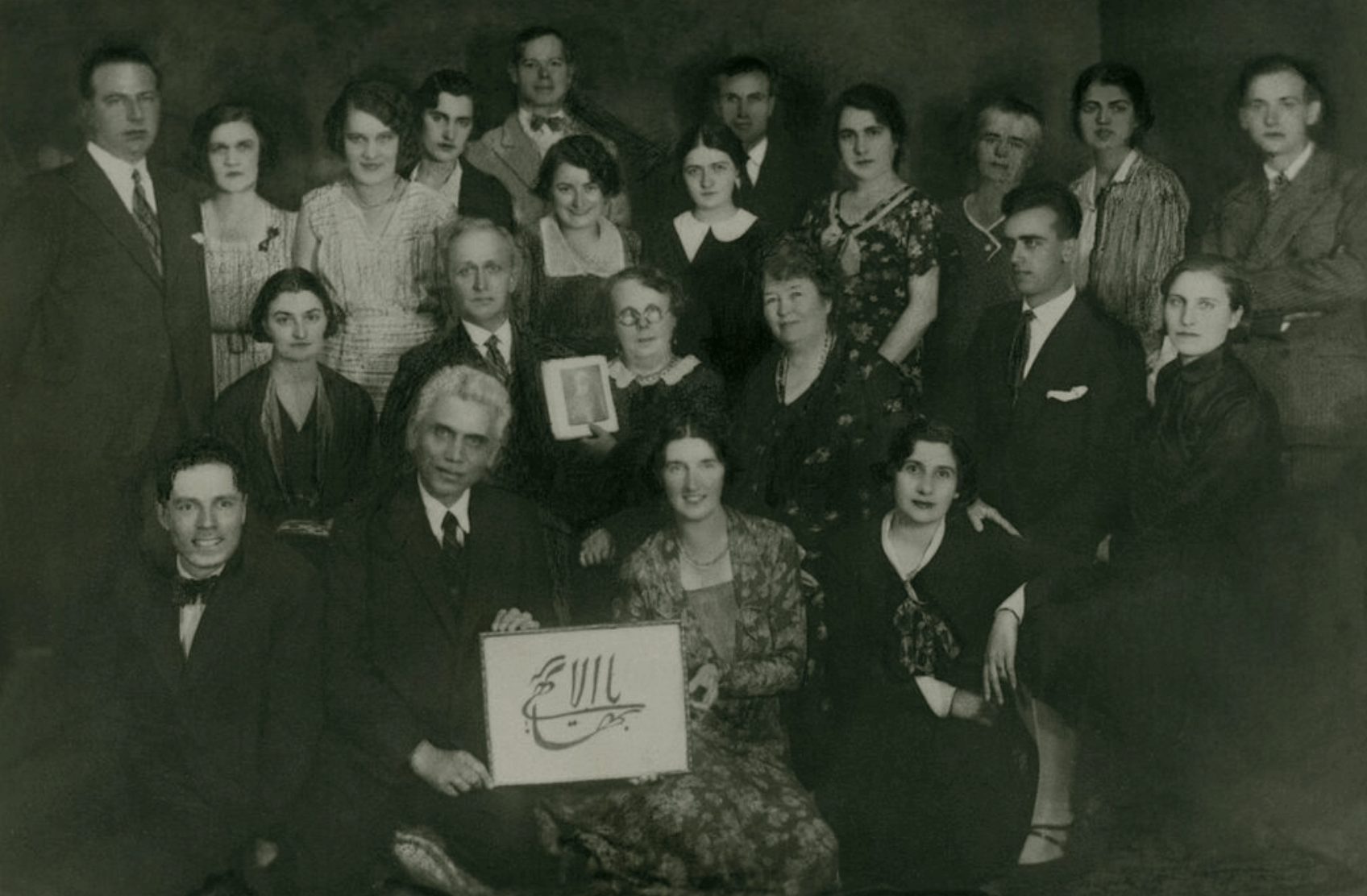
The Bahá'ís of Sofia, Bulgaria in 1932. George Adam Benke and his wife Lina are holding the portrait of 'Abdu'l-Bahá together. Marion Jack is seated next to Lina Benke. Source: Bahaimedia.
George Adam Benke was born in a Crimean German family on a flourishing and prosperous farm in Rosdil, Ukraine in 1878. He had a very difficult childhood, filled with disease, poverty, and famine, but through sheer force of will and his brilliant mind, he became a linguist and married Lina Wolf in 1901. In 1920, they met an eminent German Bahá'í, Alma Knobloch, who introduced them to Harlan and Grace Ober, two American Bahá'ís who taught them the Faith, and both George Adam and Lina became Bahá'ís.
Benke was overjoyed when he found the Orientalist journal at the University Library of Leipzig, in which the Will and Testament of Bahá'u'lláh, and the poems of Andalíb had been published in Russian in 1893.
In June 1931, George Adam Benke, was called upon to help Marion Jack, who was by this point, was the only Bahá'í pioneer left in Sofia, Bulgaria. George Benke visited Vienna on the way and stayed in Bulgaria for three months, and, because he was a linguist, he quickly began learning Bulgarian. He already spoke several languages current in Bulgaria, like Russian, and this would have been a great help to Marion Jack, who was never able to learn Bulgarian and had to content herself with communicating in French and English, as best she could.
George Adam Benke attended an Esperanto Congress at Stara Zagora—230 kilometers east of Sofia—serving as the honorary vice-president of the meeting. The next year, in 1932, at the Guardian’s request, George Benke returned to Sofia, and served in the same capacity at the same Esperanto Congress in Stara Zagora.
During his second visit, he also visited Varna, 440 kilometers east of Sofia—the third-largest city in Bulgaria and the largest one on the Black Sea Coast of Bulgaria. On his return journey to Sofia, he again stopped over in Stara Zagora to renew his acquaintance with his Esperanto friends and refresh their knowledge of the teachings of the Faith, and reconnected with his old friend Dr. Tchervenkof in Plovdiv and teach the Faith in that city.
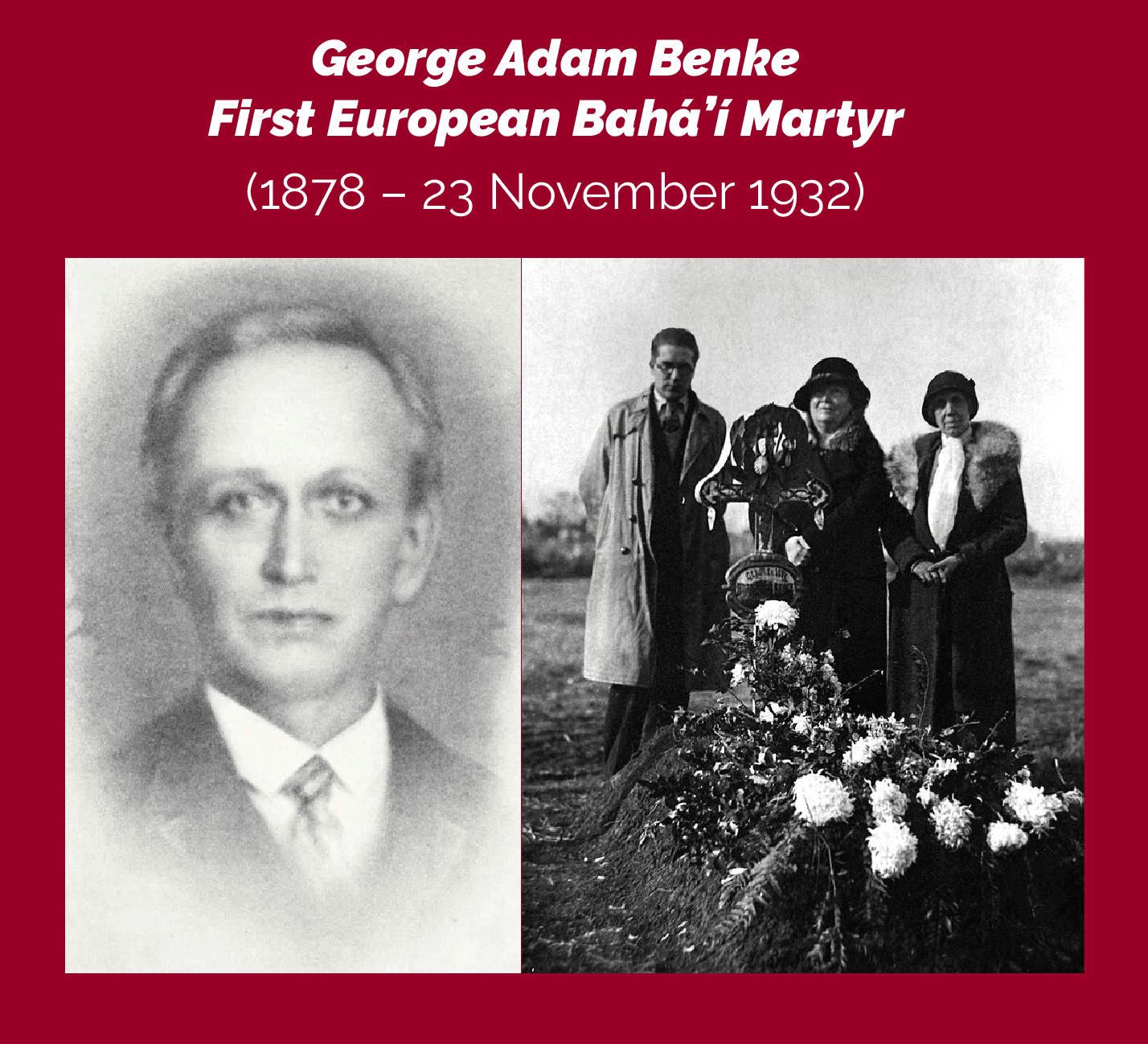
George Adam Benke: First European Bahá'í Martyr. Portrait of Adam Benke. Source: Bahaimedia. At the grave of George Adam Benke: from left to right, the two women standing are future Hands of the Cause Martha Root and Marion Jack. Source: Bahaimedia.
George had a wonderful time in Bulgaria, and was constantly talking to people in his wonderful potpourri of languages, working night and day. Nothing could distract him from his teaching work, and when he was not teaching, he was busy perfecting his Bulgarian, English, and Esperanto.
His only ambition was to become an efficient teacher of the Faith, and a servant of whom his beloved Guardian could be proud. His devotion to Shoghi Effendi was deeply touching, he wanted to obey Shoghi Effendi to the letter, but also in spirit, and studied every single letter the Guardian sent with great earnestness, in order to learn how to be absolutely efficient and above reproach. His longing that all believers should be firm in the Covenant was deeply intense.
Then, on the night of 23 November 1932, George was suddenly struck down by an unexpected heart attack. In the hospital, he taught the Faith to a Russian woman, and until past midnight, he was giving advice and counsels to a young Bulgarian man. After a short half-hour of discomfort, George Adam Benke turned to Bahá'u'lláh in prayer, sweetly reciting the Báb’s invocation “The Remover of difficulties,” and, with the Báb’s invocation on his lips, he passed away. George was laid to rest in the Sofia cemetery, and all those who had come in contact with him testified to the beauty of his life and the purity of his character. His example in living the life spoke even more loudly than his eloquent words.
On 21 June 1956 in a letter to the National Spiritual Assembly of Germany, The Guardian elevated him to the rank of Martyr:
He hopes that the German Bahá'í Community will make every effort to send forth a greater number of pioneers to the countries which have been made their particular responsibility under the World Crusade, and also to reinforce the work in Austria. They must never forget that one of the first "pioneers", before the days when that term was even in use, was dear Mr. Benke, who sacrificed his life in the service of the Faith with such an exemplary spirit of devotion that the Guardian felt impelled to call him the first European martyr for the Faith. This was a great distinction and blessing conferred on the German Bahá'ís, and should stimulate many others to follow in his footsteps.
George Adam Benke received the everlasting honor of being the first European Bahá'í Martyr, one year before Keith Ransom-Kehler became the first American Bahá'í Martyr in 1933.
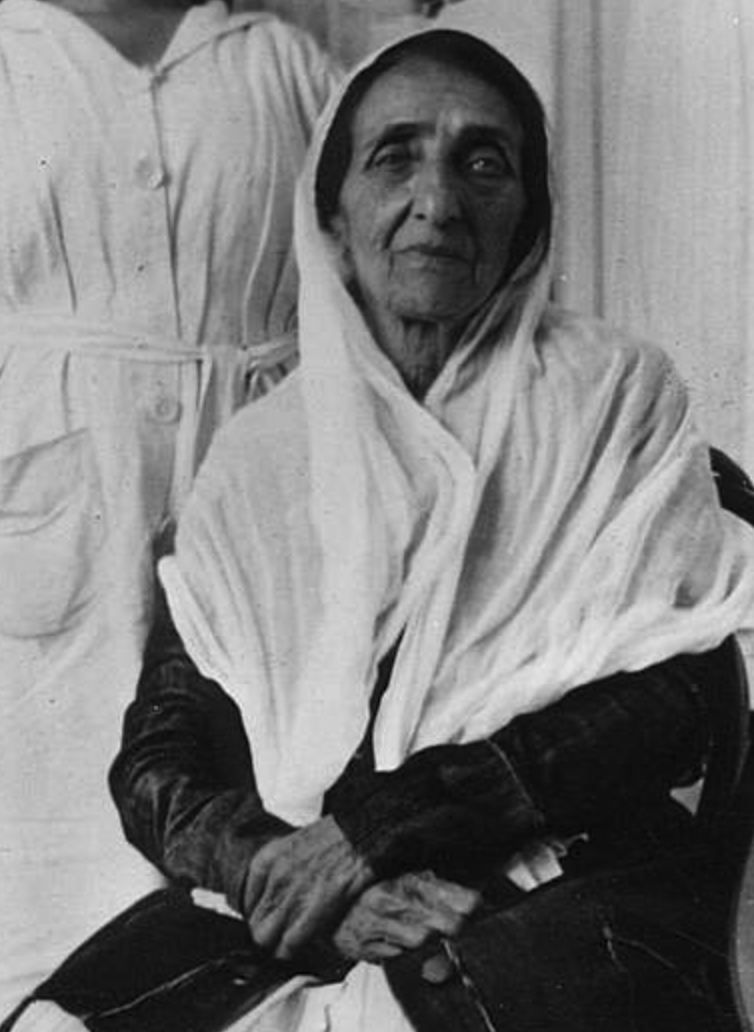
A photograph of the Greatest Holy Leaf. seated. Source: Bahá'í Biblio.
On 14 January 1933, six months after the Greatest Holy Leaf’s passing, Shoghi Effendi sent a photograph of the Greatest Holy Leaf and the most significant Tablets Bahá'u'lláh and 'Abdu'l-Bahá ever revealed regarding her station to the National Spiritual Assembly of the United States and Canada, asking them to create pamphlets using the enclosed materials and distribute them to the Bahá'ís of the United States and Canada, and the believers in Europe.
In his cover letter, Shoghi Effendi stated that these passages disclosed “the nature of that mystic bond which on one hand, united her with the Spirit of her Almighty Father and, on the other hand, linked her so closely with her glorious Brother, the perfect Exemplar of that Spirit.”
And he spoke of the Greatest Holy Leaf as “a pattern of goodness, of a pure and holy life, who was the embodiment of such heavenly virtues as only the priviliged inmates of the uppermost chambers in the 'Abhá Paradise can fully appreciate, will long live enshrined in these immortal words—a memory the ennobling influence of which will remain an inspiration and a solace amid the wreckage of a sadly shaken world.”
The Guardian included several excerpts from Tablets revealed by Bahá'u'lláh and 'Abdu'l-Bahá which not only testify to the peerless rank of the Greatest Holy Leaf but shed light on Bahá'u'lláh’s love for His saintly daughter, 'Abdu'l-Bahá’s love for His perfect sister, and Shoghi Effendi’s love for his Great-Aunt.
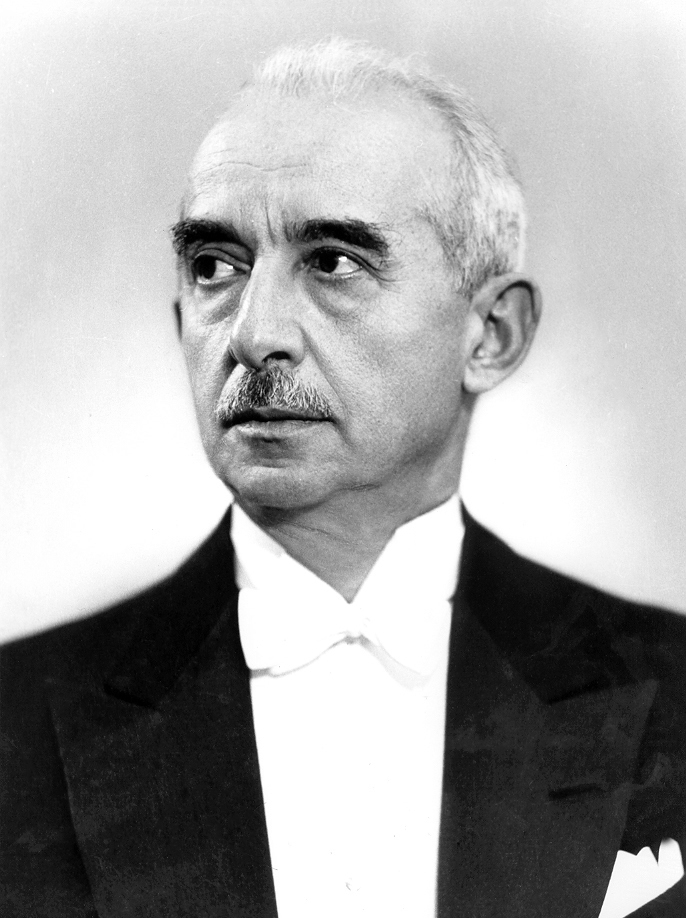
Prime Minister of Turkey İsmet İnönü (also known as Ismet Pashá). Source: Wikimedia Commons.
In late January 1933, the Turkish Bahá'ís were once again imprisoned. The attention of the Guardian was on every part of the globe at once, dealing with every crisis simultaneously.
The Turkish Government had already come down and exonerated the Turkish Bahá'í community in 1928, paranoid about religious organizations harboring political agitators in their secular state, and five years later, the same suspicions resurfaced.
On 27 January 1933, the Guardian cabled the National Spiritual Assembly of the United States and Canada while simultaneously cabling the Persian National Spiritual Assembly a similar, less detailed message:
Bahá'ís Constantinople and Adana numbering about forty imprisoned charged subversive motives. Urge induce Turkish Minister Washington make immediate representations his government release law abiding followers non-political Faith. Advise also National Assembly cable authorities Angora and approach State Department.
On 28 January 1933, the Guardian cabled His Excellency Ismet Pasha, the Prime Minister of Turkey in Ankara:
As Head of Bahá'í Faith learned with amazement and grief imprisonment followers of Bahá'u'lláh in Stamboul and Adana. Respectfully appeal your Excellency's intervention on behalf followers of a Faith pledged loyalty to your government for whose epochal reforms its adherents world over cherish abiding admiration.
The worldwide Bahá'í community appealed to Turkish authorities, reminding them of the verdict of innocence returned in 1928, many months after the first roundup and trial.
On 5 March the Guardian informed the American Assembly:
Istanbul friends acquitted 53 still imprisoned Adana urge renew energetically representations immediate release.
On 2 April 1933 the Guardian had wonderful news:
Adana friends released. Advise convey appreciation Turkish Ambassador.
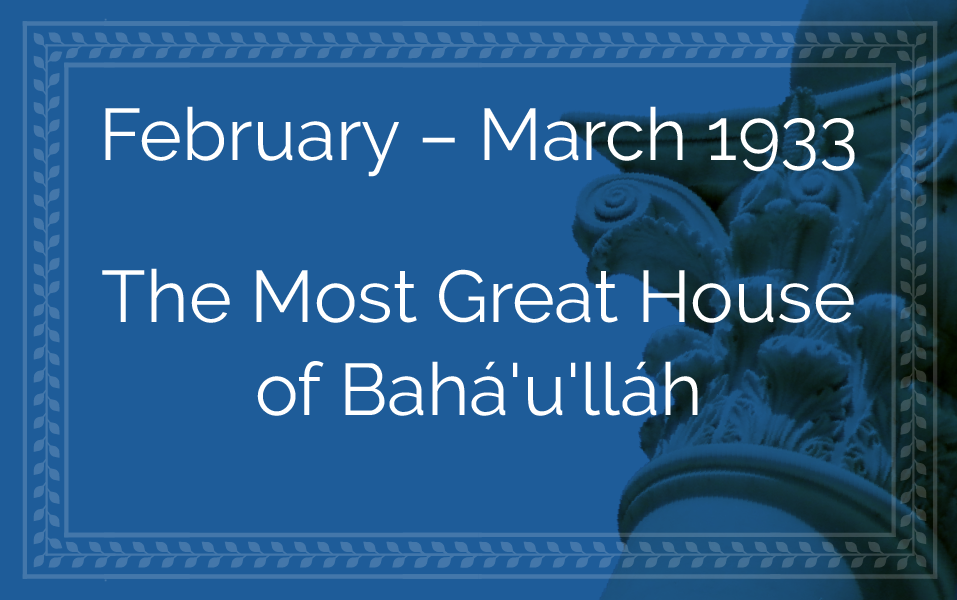
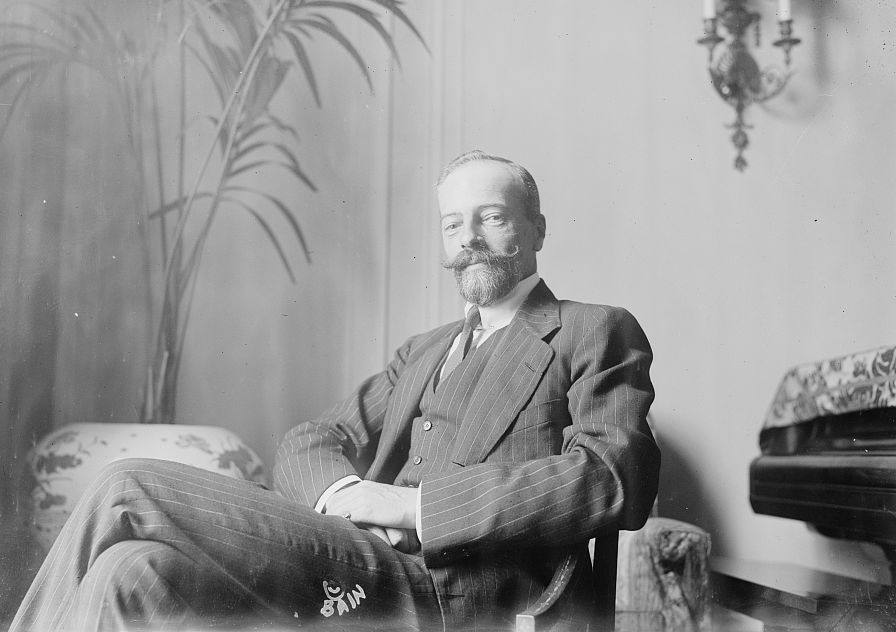
Grand Duke Alexander Mikhailovich of Russia. Source: Wikimedia Commons.
In the first ten years of his ministry, Shoghi Effendi carried on a lengthy correspondence with Grand Duke Alexander Mikhailovich of Russia.
From the tone of Shoghi Effendi’s letters it was clear he liked the Grand Duke a great deal, addressing him as "My true brother in the service of God!" and "My dear brother in the love of God!"
Grand Duke Alexander was very interested in a movement called the "Unity of Souls" and Shoghi Effendi encouraged him:
I am more and more impressed by the striking similarity to out aims and principles and I beseech the Almighty to bless His servants in their service to the cause of suffering humanity.
In a letter to Shoghi Effendi, Grand Duke Alexander wrote:
I must confess to you, my dear brother and fellow worker, that in my modest work occasionally I feel discouraged…the power of evil forces under the influence of which the majority of humanity is living, is appalling.
Shoghi Effendi’s response to his friend’s anxiety about the dark forces at work in the world was beautiful and kind, filled with empathy:
I assure my dear fellow-worker in the service of God, that I too feel oftentimes overwhelmed by the rising wave of selfish, gross materialism that threatens to engulf the world, and I feel that however arduous be our common task we must persevere to the very end and pray continually and ardently that the ever-living spirit of God may so fill the souls of men as to cause them to arise with new vision for the service and salvation of humanity. Prayer and individual persistent effort, I feel, must be given greater and wider prominence in these days of stress and gloom…
Grand Duke Alexander Mikhailovich of Russia passed away on 26 February 1933.
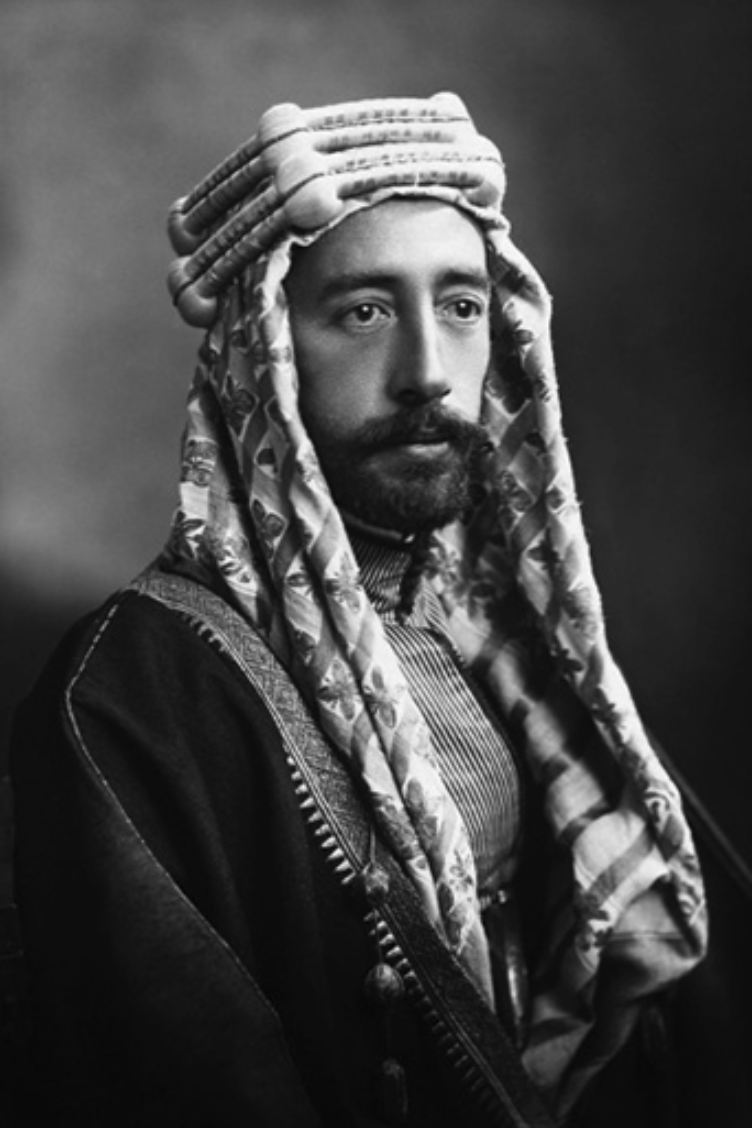
King Faisal I of Iraq. Source: Wikimedia Commons.
Martha Root met with King Faisal on 2 January 1930, and the King stalled, saying he had done his duty in order to maintain justice, then stated:
Justice will always be followed. We have formed a committee to study the whole problem and settle it in such a way as to satisfy all groups interested in this matter.
It was obvious King Faisal was not acting in the interest of impartial justice, and only maintaining balance with the Shí’ah in order to stay in power. He did not mean what he said.
The Guardian’s request to avoid widespread publicity was prescient. The memorandum of the British Government had absolutely no effect on the Iraqi Government.
The Bahá’ís rightful claim to ownership of the Most Great House had the backing and support of both the League of Nations and the British Government, but the Iraqi Government was dealing with a situation of an entirely different order: they were trying to keep the peace, as a Sunní government, with Shí’ah elements threatening revolt if they gave ownership of the Most Great House to their enemies, the Bahá'ís.
It was an unwinnable battle, on the one hand law and order, on the other, blind religious hatred.
This was reflected in the minutes of the twenty-first session of the Permanent Mandates Commission of the League of Nations, dated 13 November 1931, which stated:
It should not be forgotten, however, that the ‘Iráqí courts had created that situation by their partiality and the ‘Iráqí Government by its weakness…Religious passion was at the bottom of this injustice and it was clear that the delays in righting the wrong were due to the same cause; the ‘Iráqí Government was not strong enough to make a majority respect the right of a minority
In 1932 a compromise was offered, to turn the house into a school, dispensary, or public gardens. The Bahá’ís were willing to agree to this, but the Shí’ah refused.
The Bahá'ís pleaded their case once again at the meeting of the twenty-second session of the Permanent Mandates Commission of the League of Nations in Geneva.
On 18 March 1933, after five years of deliberations and intervention from the League of Nations and the British Government, constant attention and pleas on behalf of Shoghi Effendi the international Bahá'í community, the Iraqi government decided to protect the Most Great House as part of an urban improvement plan, after initially planning to destroy it.
The Bahá'ís tried to plead their case at the twenty-third and twenty-fourth sessions of the Permanent Mandates Commission of the League of Nations, to no avail.
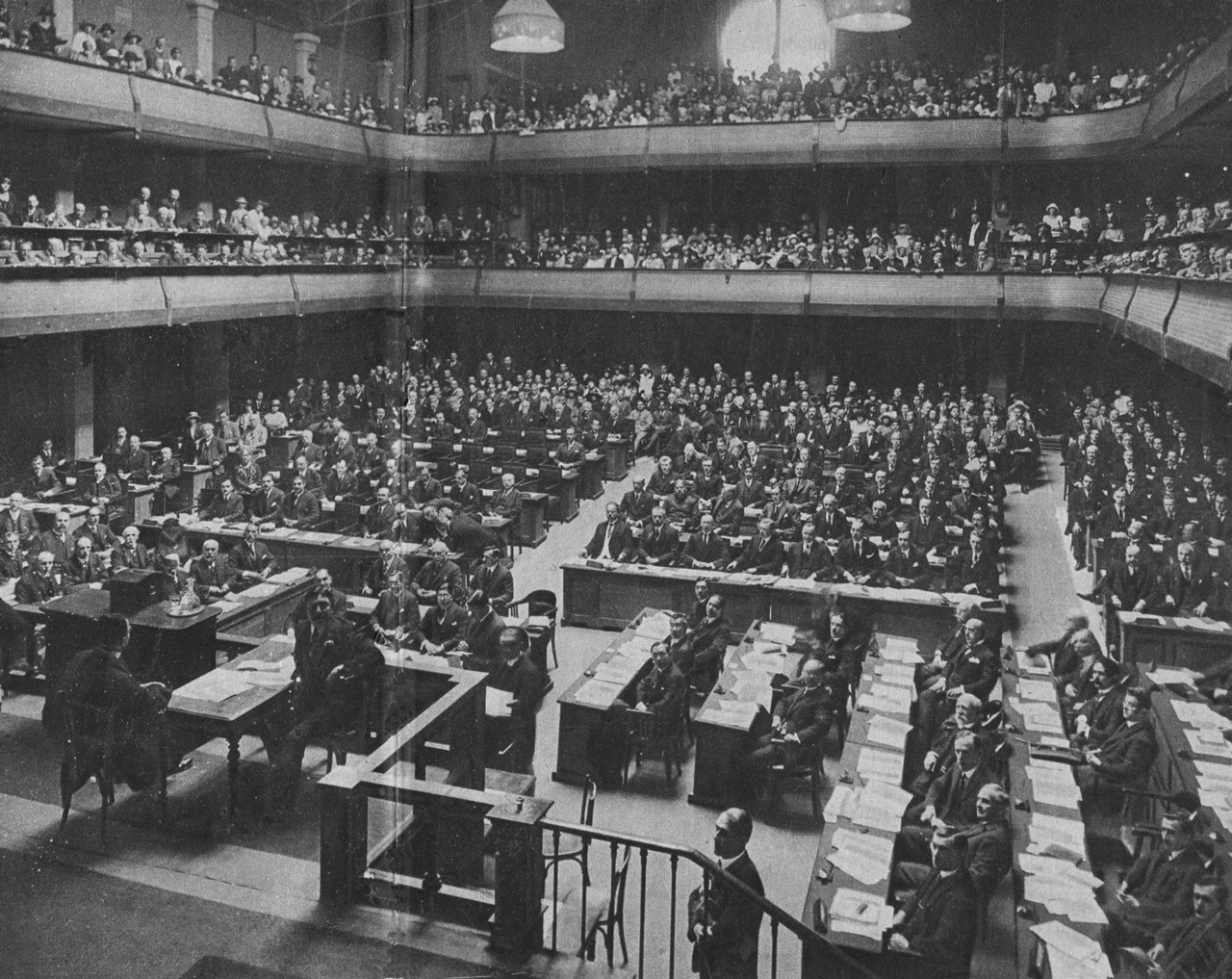
The official opening of the fourth Assembly of the League of Nations in Geneve 1923. Source: Wikimedia Commons.
Shoghi Effendi had tried everything for ten solid years. A decade of trying his utmost to get justice for the Bahá'í community and regain ownership of the Most Great House lawfully, for five years, he had pleaded with the highest court of international justice that existed at time at the League of Nations.
Ultimately, there were no instruments to enforce justice. During the years the case was being heard, there were many disruptions: the Iraqi Prime Minister Abdu’l-Muhsin Al-Saadoun died in office in 1929, King Faisal, died of a heart attack in September 1933. the British High Commissioner, Britain was no longer the Mandatory Power in Iraq in 1933, their mandate had ended on 3 October 1932.
No one, not the League of Nations, and certainly no longer the British Government, could convince the Government of Iraq to do anything. Iraq had its own agenda: maintaining the balance of power between Sunní and Shí’ah, which meant keeping the Shí’ah happy, which implied never, ever giving the Bahá'ís anything they wanted, especially not what they wanted more than anything, which they had proved over the last ten years, with their constant appeals, was the Most Great House.
In God Passes By, Shoghi Effendi summarizes what happened with the Most Great House in Baghdád:
These are the Guardian’s final words about an episode, which he did not consider a loss for the Bahá'í community, even if they did not get custody of the Holy Place in the end:
Suffice it to say that, despite these interminable delays, protests and evasions, and the manifest failure of the Authorities concerned to implement the recommendations made by both the Council of the League and the Permanent Mandates Commission, the publicity achieved for the Faith by this memorable litigation, and the defense of its cause—the cause of truth and justice—by the world’s highest tribunal, have been such as to excite the wonder of its friends and to fill with consternation its enemies. Few episodes, if any, since the birth of the Formative Age of the Faith of Bahá’u’lláh, have given rise to repercussions in high places comparable to the effect produced on governments and chancelleries by this violent and unprovoked assault directed by its inveterate enemies against one of its holiest sanctuaries.
What a casual or inattentive observer might consider a loss for Bahá'ís, the Guardian of the Faith, with his infallible perspective, calls a win, as he had understood that “any publicity is good publicity.”
From the Guardian’s perspective, the decade-long battle to obtain custody of the Most Great House had resulted in putting the worldwide Bahá'í community on the map because of the immense publicity generated, the fact the case had gone five times before the League of Nations, the world’s highest tribunal, it had amazed the friends of the Faith and thoroughly dismayed its enemies, the Bahá'ís had won countless times in tribunals had been well and truly seen as the legal and rightful owners of the Most Great House, before they were thwarted in Baghdád by the Iraqi Government, and the Bahá'ís, and lastly, the governments who had been made aware of this miscarriage of justice would not forget it.
This was not a failure for the Guardian.
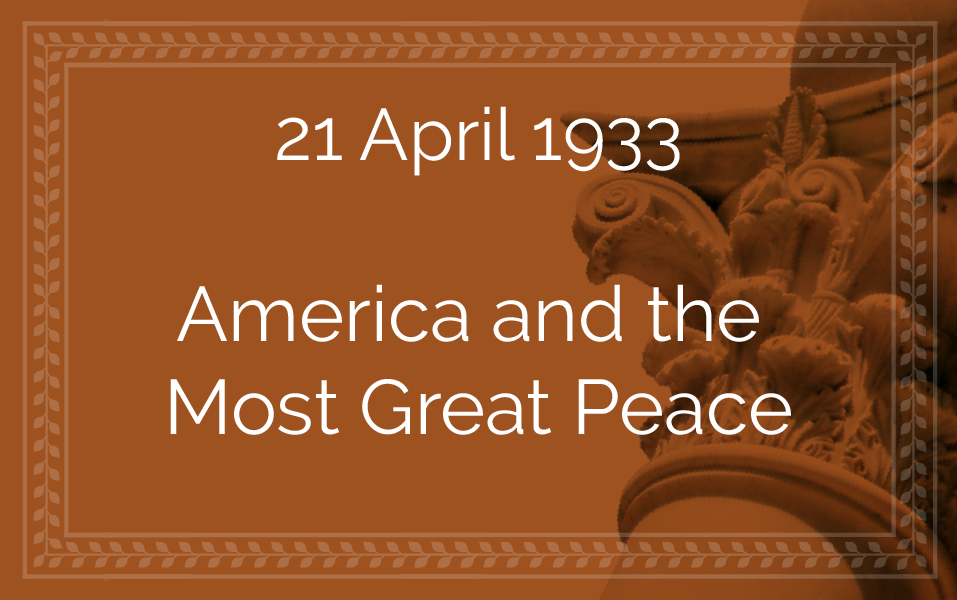
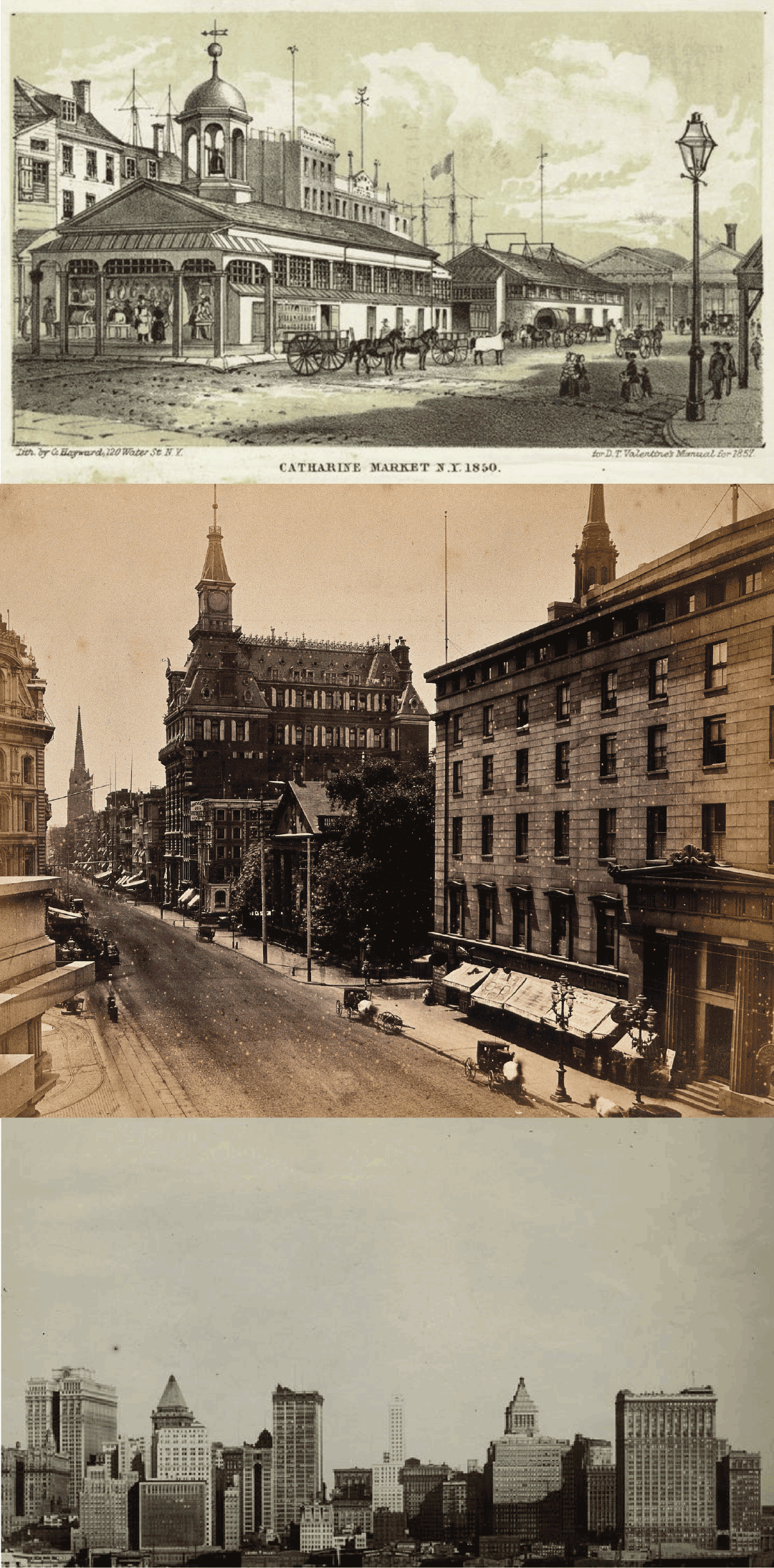
Three illustrations of New York in the time of the Báb, Bahá'u'lláh, and 'Abdu'l-Bahá. Top: New. York at the end of the Báb’s ministry in 1850, showing Catharine Market. Source: The New York Public Library Digital Collections. Middle: New York city during Bahá'u'lláh’s ministry: Broadway, New York City, seen from the Post Office in 1880. Source: Wellcome Collection. Bottom: A photograph of the New York City skyline in 1912, the year 'Abdu'l-Bahá traveled through North America. Source: The New York Public Library Digital Collections.
America holds a special place in the Bahá'í Dispensation.
The Báb, in the Qayyúmu'l-Asmá', called upon the people of the West to leave their cities and ensure the triumph of His Cause.
Bahá'u'lláh, in the Kitáb-i-Aqdas, addressed the rulers of the American continent and called upon them to arise and respond to His Call, and in the Lawḥ-i-Aqdas, Bahá'u'lláh stated:
Say: In the East the light of His Revelation hath broken; in the West have appeared the signs of His dominion.
'Abdu'l-Bahá’s Tablets of the Divine Plan were a direct result of not only Bahá'u'lláh’s words in the Kitáb-i-Aqdas, but of His own direct contact with the American believers during His journey to North America in 1912.
'Abdu'l-Bahá confirmed that statement of Bahá'u'lláh and expounded on it:
From the beginning of time until the present day, the light of Divine Revelation hath risen in the East and shed its radiance upon the West. The illumination thus shed hath, however, acquired in the West an extraordinary brilliancy.
It was in 1893, at the World Parliament of Religions in Chicago, that Bahá'u'lláh’s name was first spoken aloud in the West, one year after His Ascension.
It was in Chicago, in 1894, that Thornton Chase, the very first American—and western—Bahá'í had declared his faith in Bahá'u'lláh.
'Abdu'l-Bahá conferred on the American people the title of "Apostles of Bahá'u'lláh."
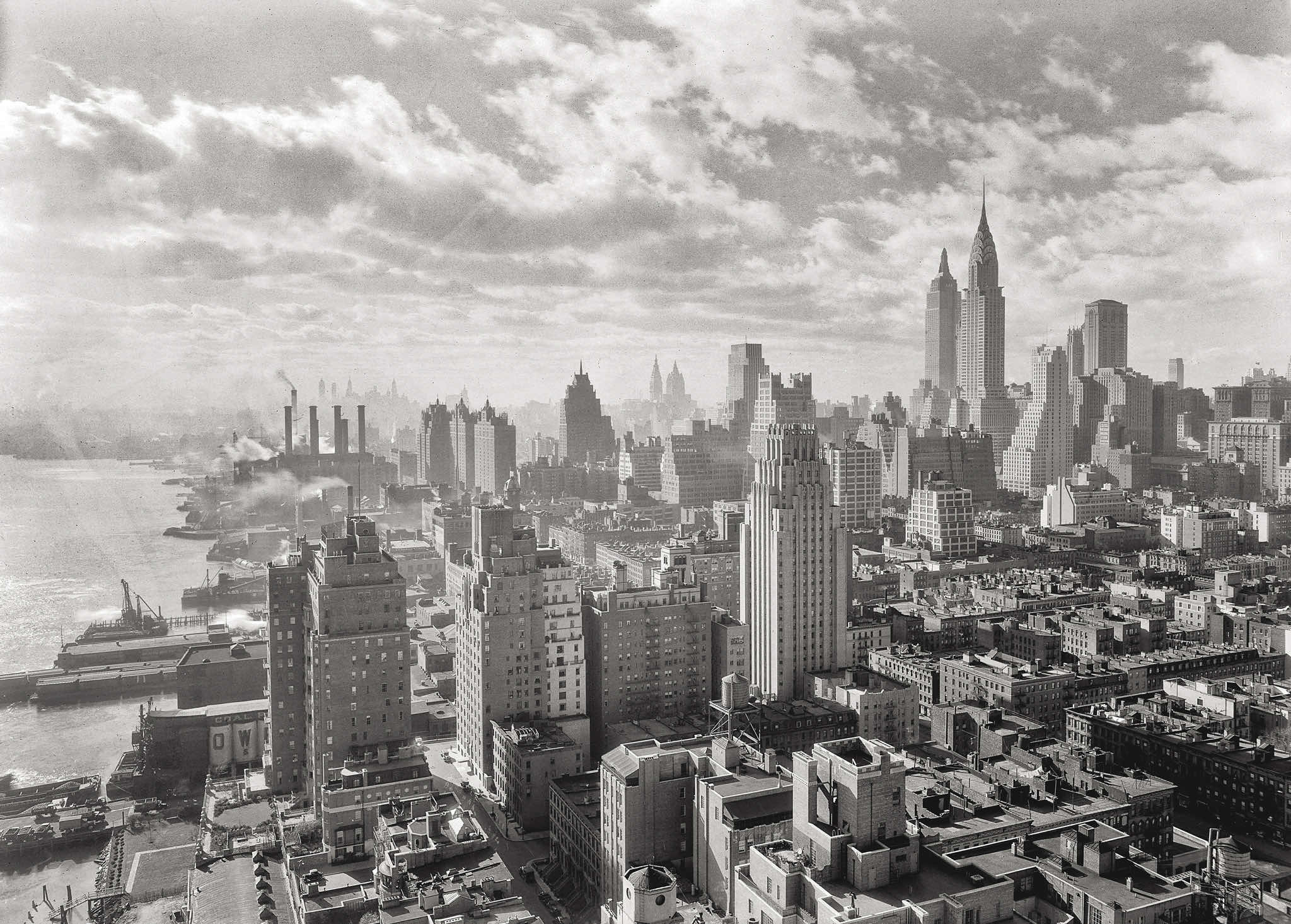
New York City photographed during the ministry of the Guardian: Midtown Manhattan from the twenty-seventh floor of River House, at Fifty-second Street and the East River in December 1931. Source: Library of Congress / Samuel H. Gottscho via 239 Days.
Shoghi Effendi wrote that the American people became the object of “'Abdu'l-Bahá's tender solicitude...the centre of His hopes, the recipient of His promises and the beneficiary of His blessings".
In that same tradition of love and encouragement exemplified by 'Abdu'l-Bahá, Shoghi Effendi spent his ministry showering his affection and encouragement on the American Bahá'ís, who made him proud with their vitality, their energy, their enthusiasm, their courage and their heroism, in prosecuting his plans, and in winning extraordinary victories for the love of Bahá'u'lláh and 'Abdu'l-Bahá.
The Guardian described them as "the children of 'Abdu'l-Bahá," the "indefatigable, irresistibly advancing, majestically unfolding American Bahá'í Community", the "cradle and stronghold" of the Administrative Order, "singled out by the Almighty for such a unique measure of favour".
He called t hem his "most prized and best-beloved brethren", so "dearly-loved, richly-endowed, unflinchingly resolute".
The believers in America, said the Guardian, had been invested with "spiritual primacy" by 'Abdu'l-Bahá, and were "the appointed, the chief trustees" of the "divinely conceived, world-encompassing" Divine Plan which conferred on them a world mission which was the "sacred birthright of the American followers of Bahá'u'lláh".
They were the "Executors of 'Abdu'l-Bahá's Will," the "champion builders of Bahá'u'lláh's embryonic Order" and the "torch bearers of a world civilization of the Faith of Bahá'u'lláh" itself.
The Guardian considered the growth of the American Bahá'í Community as one of the noblest episodes in the first century of the Faith because its development was directly due to the operation of the Will of 'Abdu'l-Bahá, and His having blessed the North American continent with His footsteps, His presence, and His love over the course of 239 historic days. This growth of the American community was only made possible by the Guardian’s implementation of the directives of 'Abdu'l-Bahá.
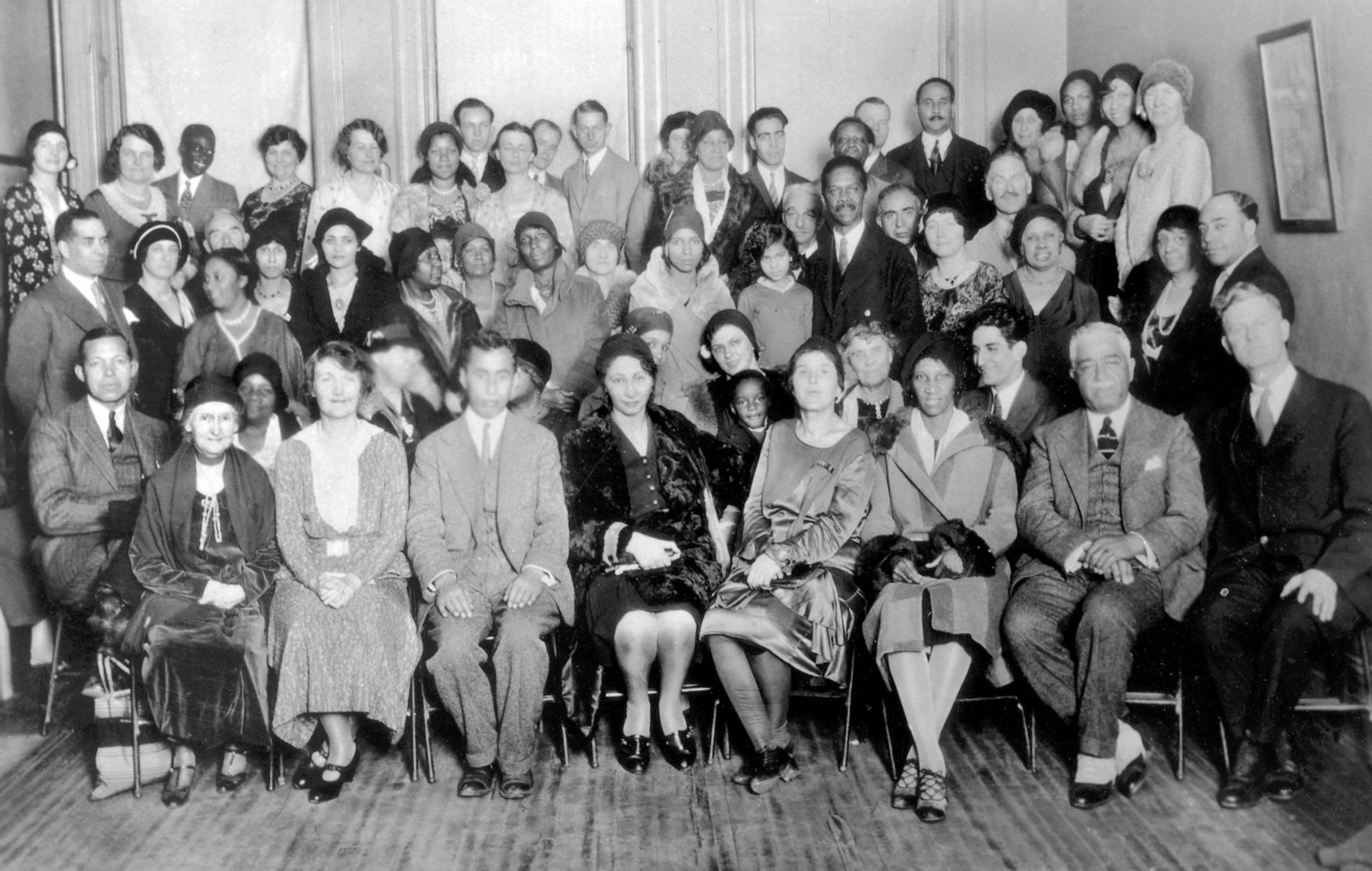
One of the many activities of the North American Bahá'í Community: In the 1920s and 1930s, the Bahá’í community of the United States sponsored a series of race amity conferences and meetings, like this one held by the New York Bahá’í Assembly and the New York Urban League in New York City in 1930. Source: Bahá'í Media Bank, © Bahá'í International Community 2023.
The Guardian’s attitude towards the American Bahá'í community was already obvious in a letter he wrote in 1923 to the Local Spiritual Assembly of New York, an attitude that never changed in the 36 years of his Guardianship:
Conscious of the clear and emphatic predictions of our beloved Master as to the predominant part of the West is destined to play during the early stages in the universal triumph of the Movement, I have, ever since His departure, turned my eyes in hopeful expectation to the distant shores of that continent...
On 26 November 1923, the Guardian wrote to the Bahá'í Temple Unity—the precursor of the National Spiritual Assembly of the United States and Canada—expressing his wish—which would never come true—to visit their shores:
How often I have wished and yearned to be nearer to the field of your activities and thus be able to keep in more constant and closer touch with every detail of the manifold and all-important services you render.
The Bahá'í Temple Unity of the United States and Canada learned that Shoghi Effendi had been appointed the Guardian of the Faith on 7 January 1922, and 13 days later they cabled him their loving response:
America rejoices appointment offers you its devoted services co-operation.
The Administrative Order in the United States and Canada was young, and so was the Guardian, just 24 years old. Over the course of Shoghi Effendi’s Guardianship, as Rúḥíyyih Khánum says, “there is something about the way they grew up together, in his ministry, that is deeply moving.”
An aspect about the Administrative Order in North America, inherent in the destiny of the Bahá'í Faith, that must be mentioned, and that all of us must always bear in mind is that the Guardian’s early partnership with America led to the establishment and growth of the Administrative Order all over the Bahá'í world.
After 'Abdu'l-Bahá’s Ascension, the North American Bahá'ís were battling a Covenant-breaking crisis of their own. His passing was a blow to them, and agony and despair swept over the community, an intense suffering that was only soothed once they fixed their eyes firmly on the Guardian.
Shoghi Effendi began to actively guide America, and found the community eager, joyful and responsive from the outset of his Guardianship. This was the Guardian’s message to the 1923 National Convention in America:
That this year's Convention may...inaugurate an unexampled campaign of teaching is indeed my ardent prayer. Let this be Riḍván's Message: unite, deepen, arise."
As Rúḥíyyih Khánum says: “The captain had placed his hand on the helm.”
Shoghi Effendi never ceased to admonish, hearten, educate, encourage the North American Bahá'í Community. Through war and peace, in his youth, middle age, and at the end of his life, he loved and guided this "preeminent community of the Bahá'í World", a Community which had been, as he once wrote, "singled out by the Almighty for such a unique measure of favour, ...distinguished from its sister communities through the revelation of a Plan emanating directly from the mind and pen of its Founder", "recognized as the impregnable Citadel of the Faith of God, and the Cradle of the rising institutions of its World Order", "whose elevation to the throne of everlasting dominion the Centre of the Covenant confidently anticipated."
With few exceptions, for 36 years, the great directives, the world-shaping concepts and teaching plans conveyed in the general letters of the Guardian were addressed to, published by or relayed through the American Bahá'í community.
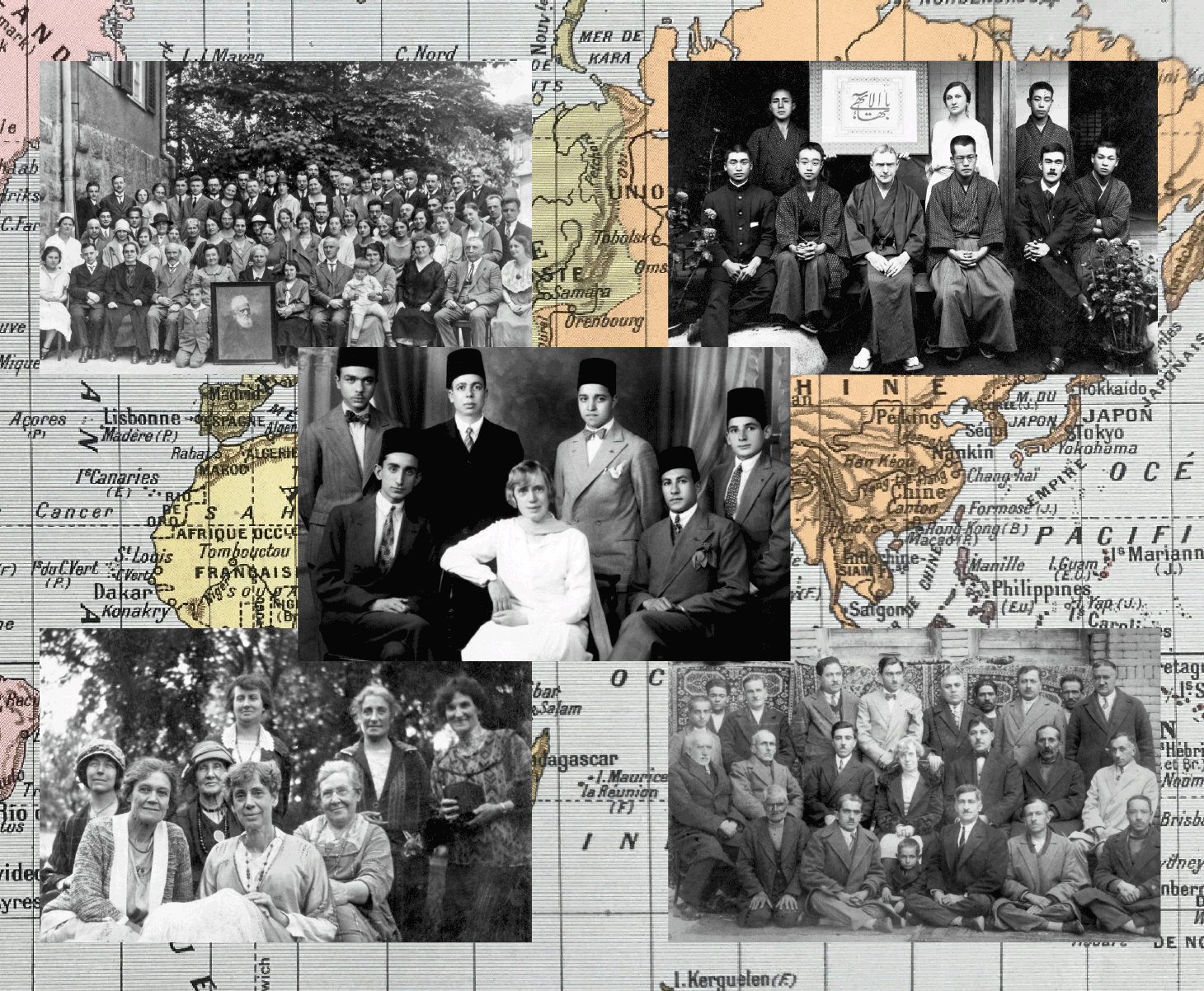
Bahá'ís of the world during the ministry of the Guardian: Top left: Group of Bahá’ís, including Hands of the Cause Hermann Grossmann and Adelbert Mühlschlegel in Esslingen, Germany, 24 May 1926. Top right: Hand of the Cause Agnes Alexander with a group of Bahá’ís in Tokyo, Japan, August 1916. Bottom left: Hand of the Cause Martha Root with a group of women in Melbourne, Australia, c. 1924. Bottom right: Hand of the Cause Martha Root with a group of Bahá’í in Hamadan, Iran, c. 1930. Center photo: Aziz Yazdi (seated left) with Hand of the Cause Martha Root (center) and Esperanto students, Cairo, Egypt. Source: All photos from Bahá'í Media Bank gallery: Early Bahá’ís and Pioneers © Bahá'í International Community 2023.
But this section should not make anyone believe that the Guardian ignored Persia, and the worldwide Bahá'í community, from Australia and New Zealand, to Japan, India, Burma, all the communities in Europe, the four regional National Spiritual Assemblies in Africa, all the countries in Central and South America received his individual attention and messages. The Guardian had an independent, intensely personal and loving relationship to each and every one of them, formed, with the older communities, at the same time as that with America, which grew in scope and intensity with the passage of time.
Shoghi Effendi was always everyone's Guardian.

A stunning photograph of the Statue of Liberty, the symbol of America by Luke Stackpoole on Unsplash.
On the first day of Riḍván, 21 April 1933, Shoghi Effendi wrote another major letter to the Bahá'ís of North America. Its title was America and the Most Great Peace and it commemorated the 40th anniversary of the first public mention of the name of Bahá'u'lláh at the World Parliament of Religions in Chicago in 1893.
In this 23-page letter, Shoghi Effendi outlines the American Bahá'í communities prodigious achievements in service to the Faith, a community he states has attained “an undisputed leadership among its sister communities of East and West.”
In America and the Most Great Peace, the Guardian addresses the divinely-ordained destiny of America, the part it has been called to play in world history, and recalls 'Abdu'l-Bahá’s heroic journeys to the West, 21 years ago, as well as the many historic spiritual victories won by the Bahá'ís of the United States and Canada.
Shoghi Effendi recounts the vain and repeated attacks on the Báb, Bahá'u'lláh, and 'Abdu'l-Bahá and the resilience of God’s Covenant, stating that—just as Christianity was born in the Middle East and flourished in Europe—the Bahá'í Faith was destined, though born in Persia, to develop “on the shores of the American continent.”
Shoghi Effendi casts a panoramic glance the first 40 years of the Bahá'í Faith in America, since the declaration of the first American Bahá'í, Thornton Chase in 1894. He speaks about the first western pilgrims—most of them American—who arrived in the winter of 1898 to seek out 'Abdu'l-Bahá.
He then warmly and lavishly praises recent victories won by the American Bahá'í community: newly-acquired endowments, their legal help to Bahá'ís in Egypt, their assistance to Bahá'ís in the Soviet Union, the efforts of Mountford Mills in fighting for the Bahá'ís’ ownership rights of Bahá'u'lláh’s’ Most Great House in Baghdad, Martha Root’s extraordinary teaching and proclamation victories, including Queen Marie of Romania’s repeated personal testimonies in praise of the Faith, the efforts of Keith Ransom-Kehler to come to the aid of the Persian Bahá'ís, and win them greater religious freedom, as well as the fearless band of American women who pioneered, scattering far and wide throughout the planet.
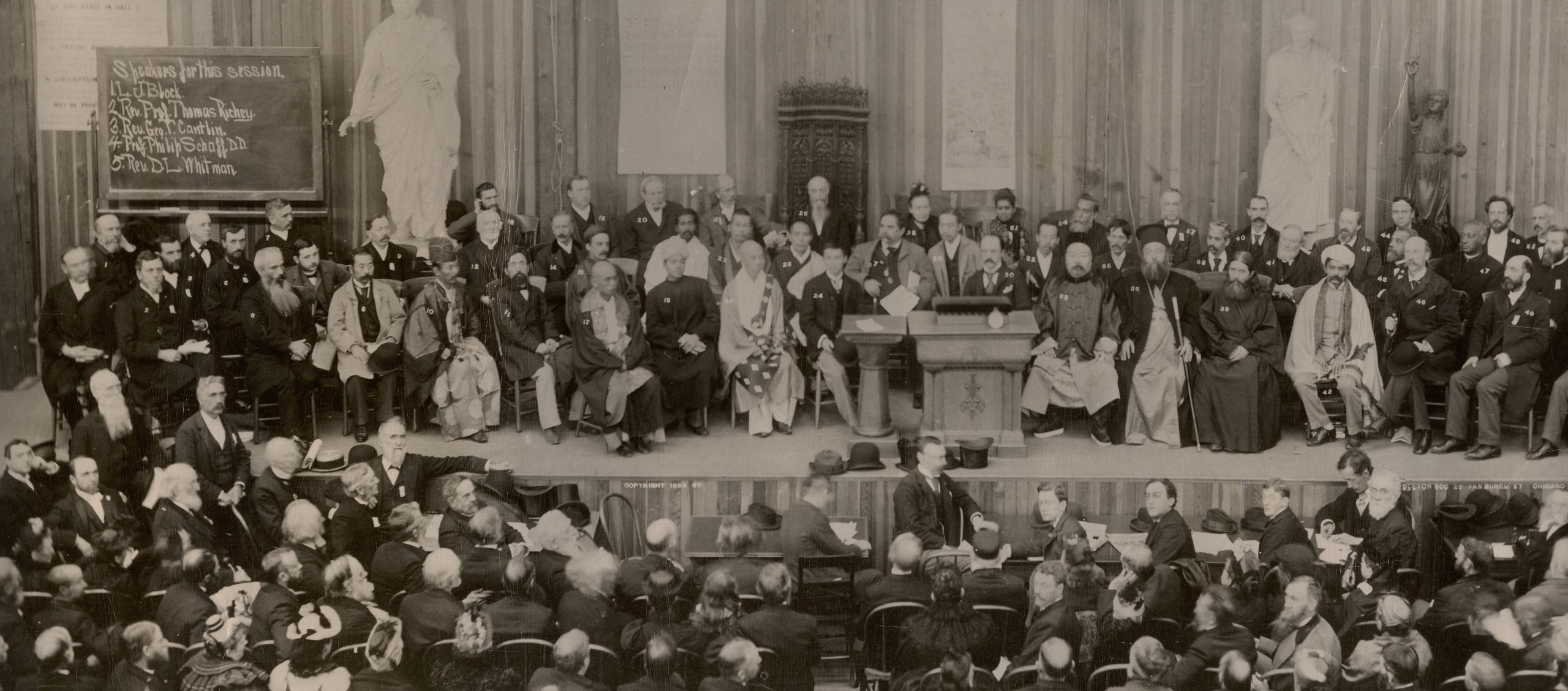
The 1893 Parliament of the World’s Religions, where Bahá'u'lláh was spoken out loud in the west for the first time in history. Source: Wikimedia Commons.
In this excerpt from America and the Most Great Peace, Shoghi Effendi outlines the four distinct periods in its Bahá'í history since the year when Bahá'u'lláh’s name was first spoken out loud at the Parliament of the World’s Religions in Chicago in 1893:
Most prized and best-beloved brethren! As we look back upon the forty years which have passed since the auspicious rays of the Bahá’í Revelation first warmed and illuminated the American continent we find that they may well fall into four distinct periods, each culminating in an event of such significance as to constitute a milestone along the road leading the American believers towards their promised victory. The first of these four decades (1893–1903), characterized by a process of slow and steady fermentation, may be said to have culminated in the historic pilgrimages undertaken by ‘Abdu’l‑Bahá’s American disciples to the shrine of Bahá’u’lláh. The ten years which followed (1903–1913), so full of the tests and trials which agitated, cleansed and energized the body of the earliest pioneers of the Faith in that land, had as their happy climax ‘Abdu’l‑Bahá’s memorable visit to America. The third period (1913–1923), a period of quiet and uninterrupted consolidation, had as its inevitable result the birth of that divinely-appointed Administration, the foundations of which the Will of a departed Master had unmistakably established. The remaining ten years (1923–1933), distinguished throughout by further internal development, as well as by a notable expansion of the international activities of a growing community, witnessed the completion of the superstructure of the Mashriqu’l-Adhkár—the Administration’s mighty bulwark, the symbol of its strength and the sign of its future glory.
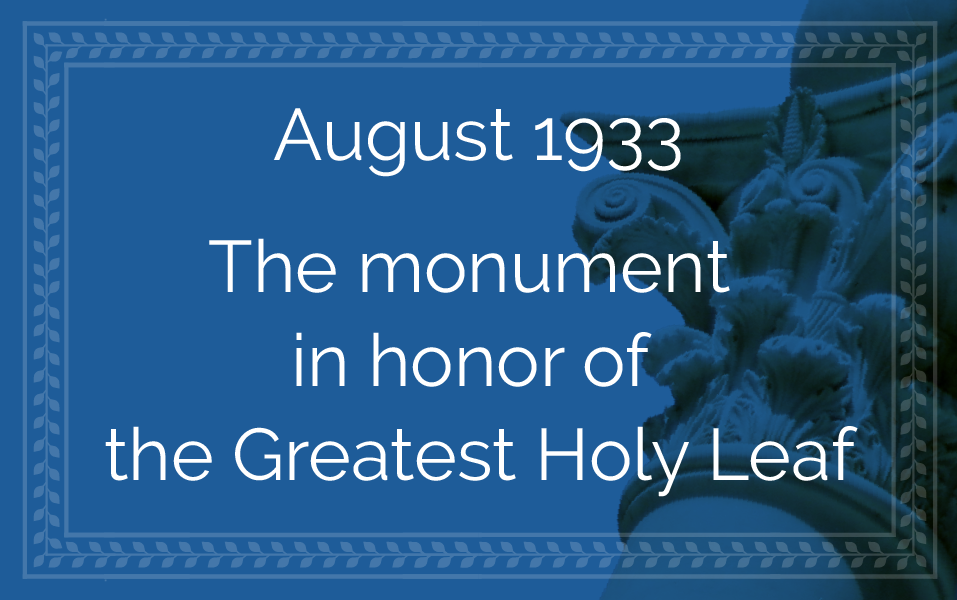
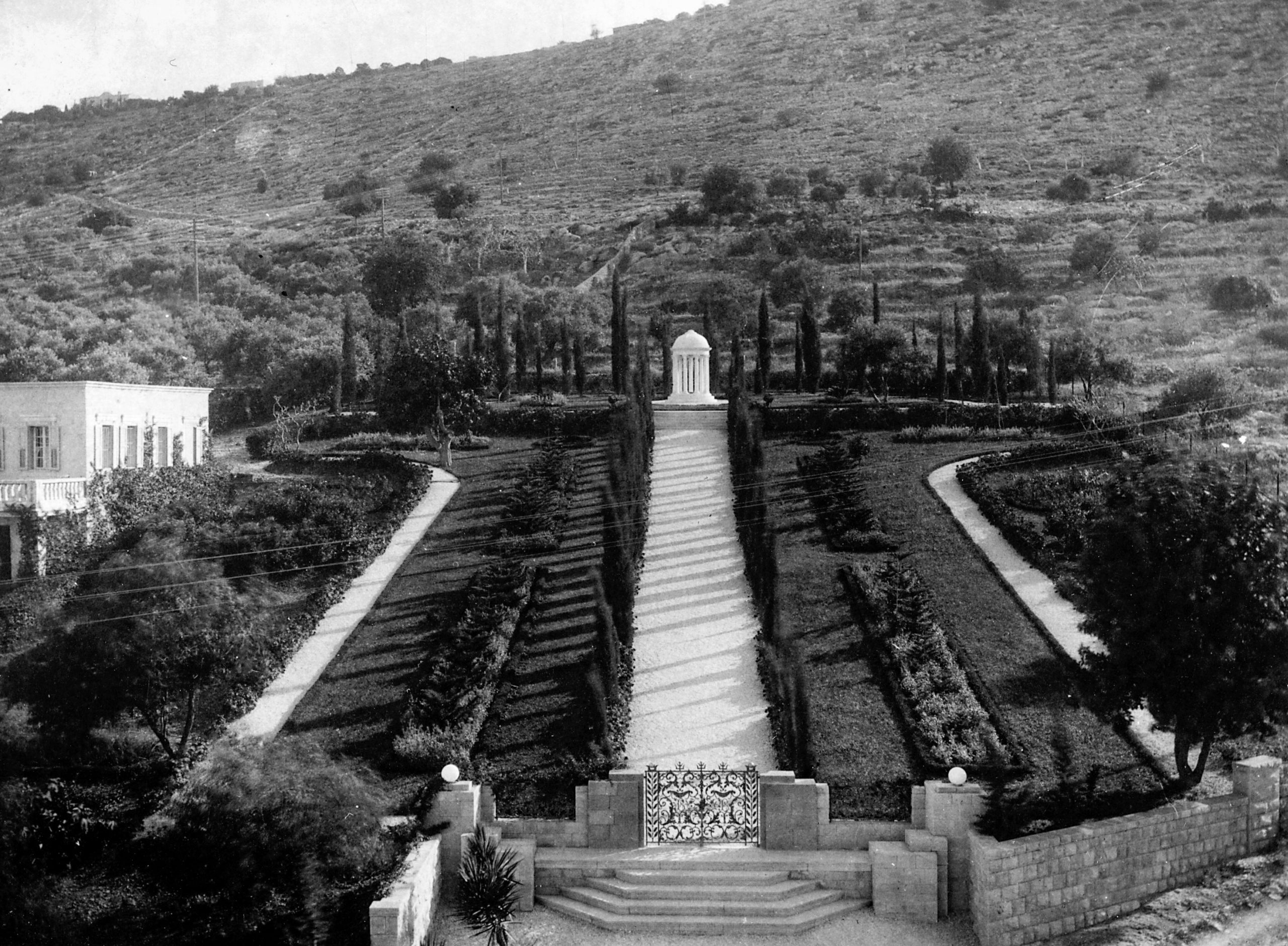
The resting place of the Greatest Holy Leaf, (Bahiyyih Khánum), the daughter of Bahá’u’lláh, in the Monument Gardens, in the 1930s, shortly after it was completed. Source: Bahá'í Media Bank, © Bahá'í International Community 2023.
By August 1933, the Guardian had completed the Greatest Holy Leaf’s monument on Mount Carmel, the first memorial in the Monument Gardens, destined become the heart of the Bahá'í World Centre’s Administrative buildings built around them in an arc.
Rúḥíyyih Khánum described the Monument for the Greatest Holy Leaf as a “love temple, the embodiment of Shoghi Effendi’s love” for Bahíyyih Khánum.
The monument, which Shoghi Effendi had commissioned in person in Italy immediately after learning of the Greatest Holy Leaf’s passing, was built of shining white Carrara marble.
Carrara marble has long been considered the best marble in the world. It has been quarried since Roman times in the mountains outside the city of Carrara, in Tuscany, in the north of Italy. More marble has been quarried around Carrara than from any other place on earth. The pure white statuario marble is the best marble that exists on earth.
Shoghi Effendi’s design inspiration for the columned Monument for Bahíyyih Khánum undoubtedly finds its roots in Antiquity, but he reinterpreted a classical feature—columns surmounted by a dome—into a meaningful spiritual homage to the Bahá'í Administrative Order.
The monument was composed of three distinct parts: three circular steps leading to a base, pillars resting around the perimeter of the base, and a round dome crowning the monument.
The Guardian would always compare the Administrative Order to the Greatest Holy Leaf’s monument: the first step was the election of delegates to National Convention, the second step was the election of the National Spiritual Assemblies, the third step was the election of the Universal House of Justice by the National Spiritual Assemblies. The pillars symbolized National Spiritual Assemblies, and the dome symbolized the Universal House of Justice.
No element of the monument—or the Administrative Order, for that matter—could be firmly established if the previous level of wasn’t firmly in place. No dome without pillars, no pillars without base.
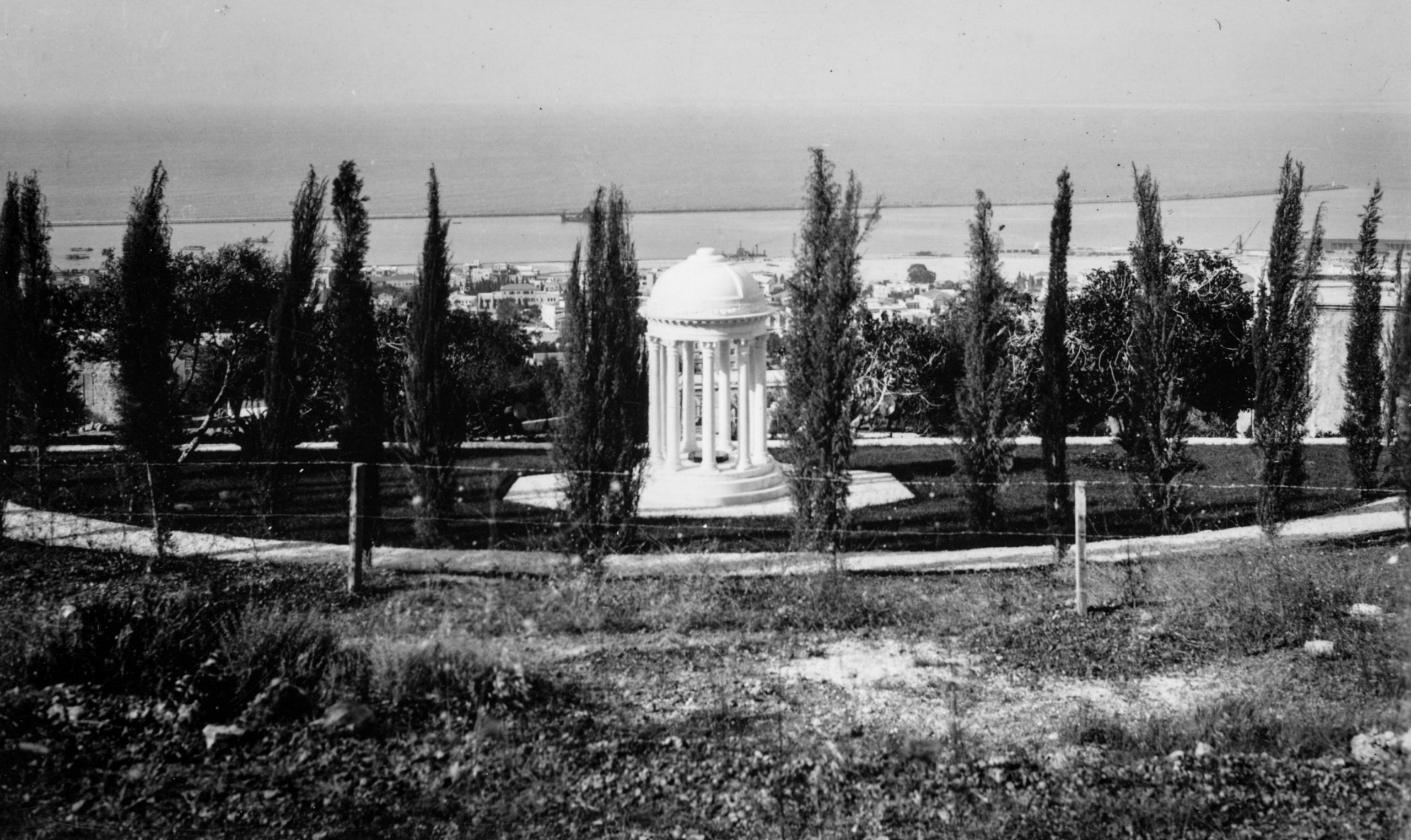
The resting place of the Greatest Holy Leaf in the Monument Gardens seen from above in the 1930s, shortly after it was completed. Source: Bahá'í Media Bank, © Bahá'í International Community 2023.
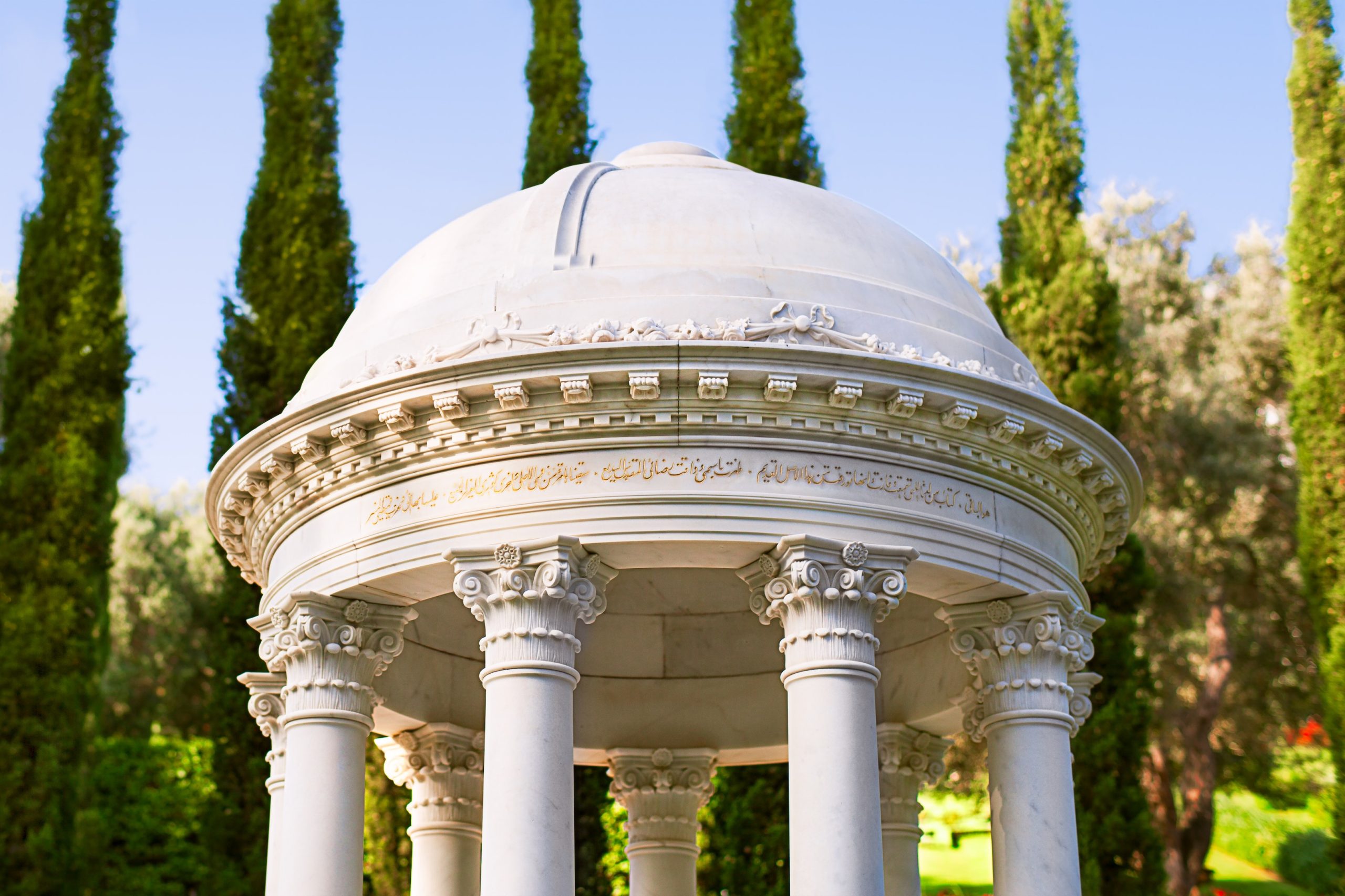
The inscription in gilded carved letters in Arabic around the base of the dome of the monument at the resting place of the Greatest Holy Leaf. The excerpt is from a Tablet of Bahá’u’lláh regarding the station of His only daughter, Bahíyyih Khánum. Source: Bahá'í Media Bank, © Bahá'í International Community 2023.
Around the base of the elegant circular dome is one of Bahá'u'lláh’s most exquisite tributes to the Greatest Holy Leaf, His peerless, illustrious daughter, is inscribed in gold in the original Arabic. The English translation of the Tablet reads:
This is My testimony for her who hath heard My voice and drawn nigh unto Me. Verily, she is a leaf that hath sprung from this preexistent Root. She hath revealed herself in My name and tasted of the sweet savours of My holy, My wondrous pleasure. At one time We gave her to drink from My honeyed Mouth, at another caused her to partake of My mighty, My luminous Kawthar. Upon her rest the glory of My name and the fragrance of My shining robe.
Once the Greatest Holy Leaf’s monument was completed, Shoghi Effendi had a beautiful photograph sent to many different National Spiritual Assemblies. The National Spiritual Assembly of the United States and Canada published the photo the Guardian sent them in Issue 76 of Bahá'í News in August 1933).
Shoghi Effendi also sent the beautiful photograph to a special list of individuals to whom he wanted to present this tender and touching souvenir.
One of the most touching aspects of Shoghi Effendi’s attention to detail with regards to the monument of the Greatest Holy Leaf was a phone call he placed to the engineer, asking him to make sure that when the head pillar was put in place that it face in the direction of the Shrine of Bahá'u'lláh and not the city of 'Akká.
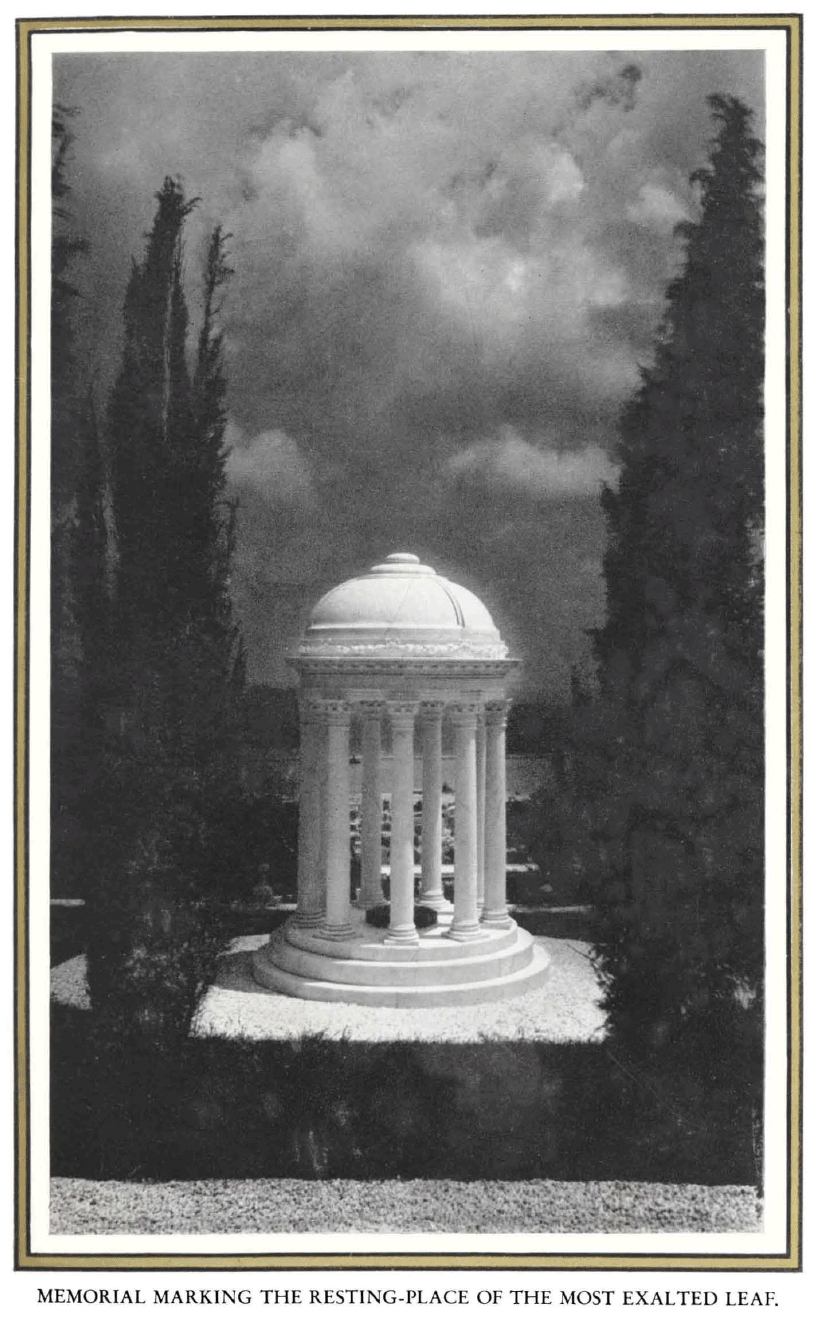
Frontispiece of The Bahá'í World Volume 5 (1930-1932): Photograph by Shoghi Effendi marking the memorial marking the resting-place of the Most Exalted Leaf.
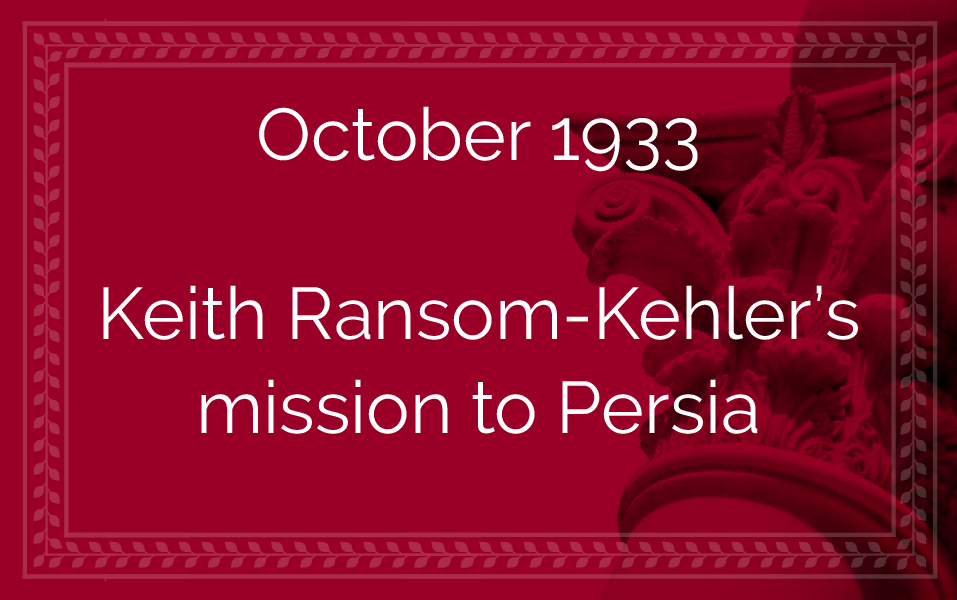
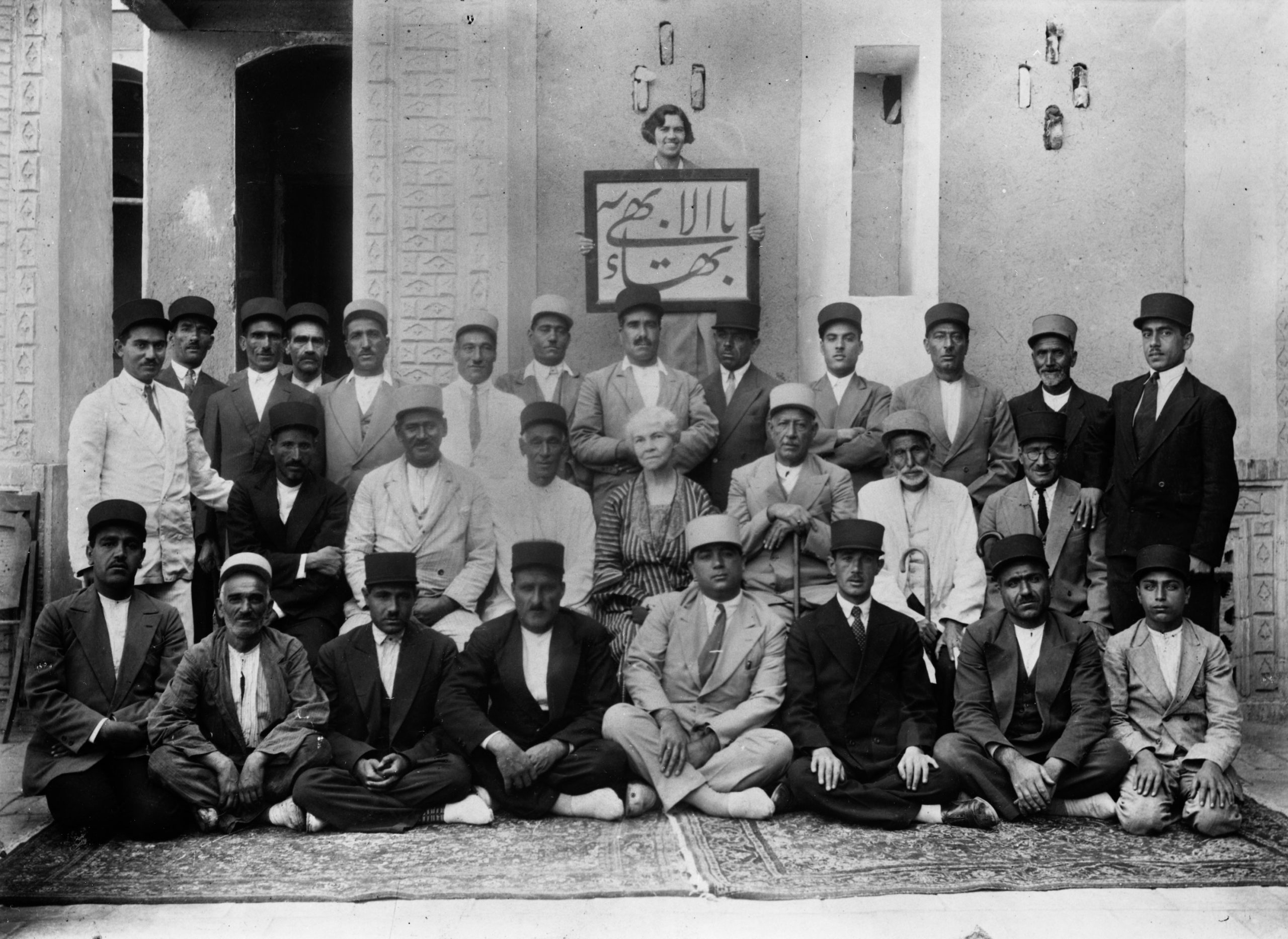
Keith Ransom-Kehler with a group of Bahá'ís in Persia in 1933. Source: Bahá'í Media Bank, © Bahá'í International Community 2023.
Keith Ransom-Kehler was an American Bahá’í lecturer and world traveler, the most outstanding Bahá’í speakers of her time, and a woman of outstanding ability. Shoghi Effendi had seen her qualities and decided to give her a very special assignment. While Keith Ransom-Kehler was traveling in India, in April 1932, Shoghi Effendi summoned her to Haifa.
Her special assignment would be to try and succeed where Persian Bahá'ís had not on two related tasks: petitioning Reza Shah Pahlavi allow Bahá'í literature into the country, and free the Persian Bahá'ís of the limitations imposed on them for so many decades.
For weeks, Shoghi Effendi personally tutored Keith Ransom-Kehler on Islam and Persia. When the Greatest Holy Leaf said farewell to Keith, she folded her tenderly in her arms and told her:
When you are come to Persia, I want you to give my love to every Bahá’í in all that land, to the men the same as to the women. And when you reach the holy city of Tihrán enter it in my name, and teach there in my name.
Keith Ransom-Kehler arrived in Persia and spent a year trying to accomplish the Guardian’s assignment. She was not able to. When she first arrived, bearing a petition for the Shah from the National Spiritual Assembly of the United States and Canada, the First Minister of Court assured her the ban on literature would be lifted and it was not.
Keith Ransom-Kehler wrote seven long letters to Reza Shah Pahlavi, and received no reply and the Shah refused to receive her. She was unable to win basic freedoms for Persian Bahá'ís, and Bahá'í literature was still banned.
If her primary mission had failed—through no fault of her own— Keith Ransom-Kehler’s visit was an enormous success in her contact with the isolated Persian Bahá'í community. Keith Ransom-Kehler—the emissary of the Guardian—was a powerful and talented speaker, and she conveyed the Guardian’s guidance regarding the development of their Administrative Order. Keith Ransom-Kehler’s visit stirred the Persian Bahá'í community into a new awareness and had a historic impact on them. They understood better their future mission and their immediate duties.
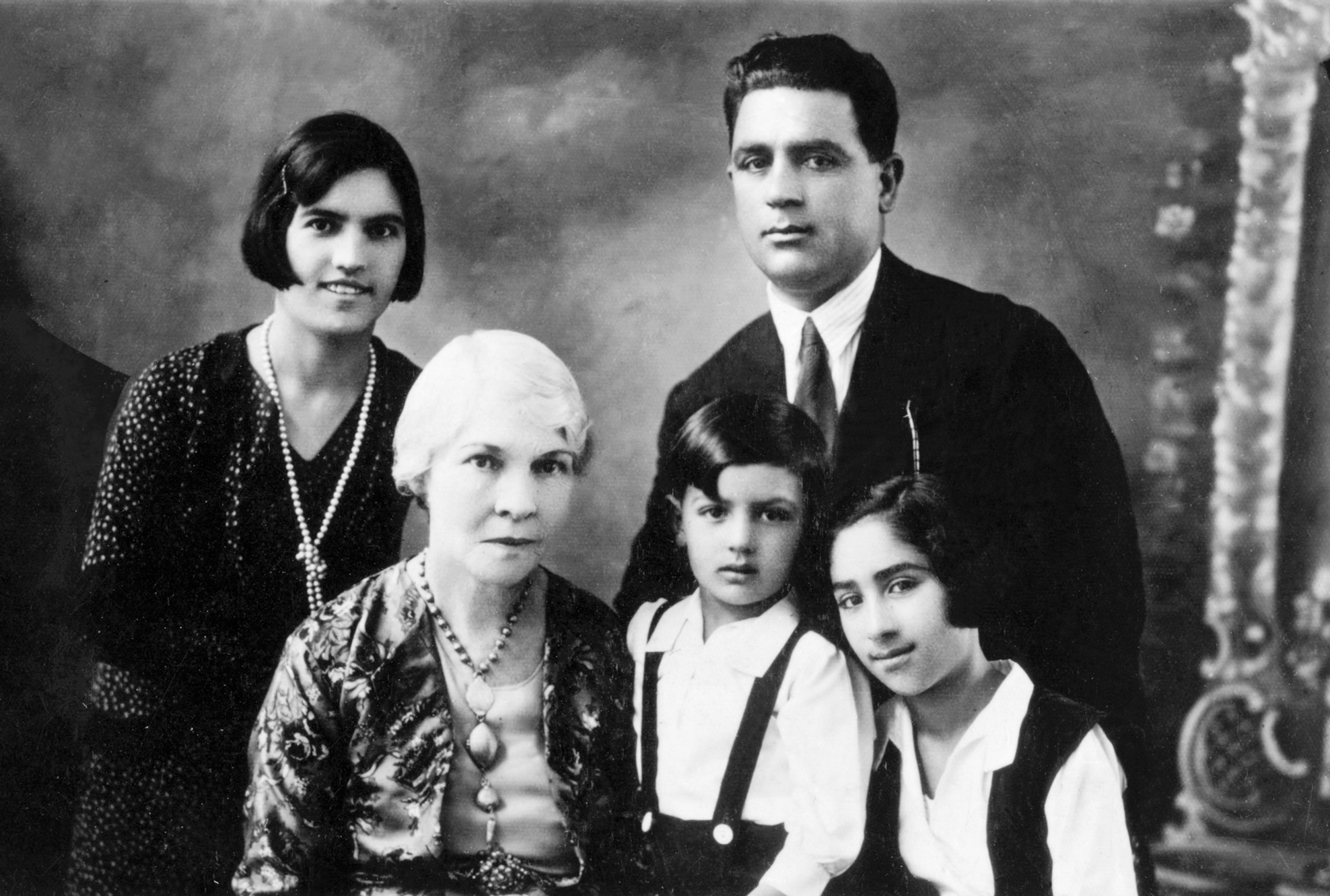
Hand of the Cause Keith Ransom-Kehler (seated at left) with Rahmatu’llah Khán ‘Ala’i (standing at right) and Najmieh (standing at left), with Gloria (right) and her brother, Manuchihr. Gloria would later become Gloria Faizi, the wife of Hand of the Cause Abu’l-Qásim Faizi. Source: Bahá'í Media Bank, © Bahá'í International Community 2023.
A few months after her arrival in Persia, Keith Ransom-Kehler left Ṭihrán for Qum on 21 September 1933 where she met with Bahá'ís and several local government officials. As she was traveling to Kashán two days later on 23 September, Keith Ransom-Kehler was met by 250 Bahá’ís who escorted her the remaining 35 kilometers into the city. For the next four days Keith Ransom-Kehler spoke in various places and went on teaching trips. She journeyed to the village of Aran, where the next day, she met with the Governor, the chief of police, the director of the municipal council, directors of public health and commerce and several other high officials in the Governor’s home.
After several more speaking engagements and teaching events, Keith Ransom-Kehler arrived in Iṣfahán on 7 October 1933. On 8 October, Keith Ransom-Kehler addressed meetings of Bahá'í men and women, and defended the Faith against the recent attacks in Persian newspapers. On 9 October, she visited the Governor of Iṣfahán in his home, as well as the head of the telegraph department and the chief of police.
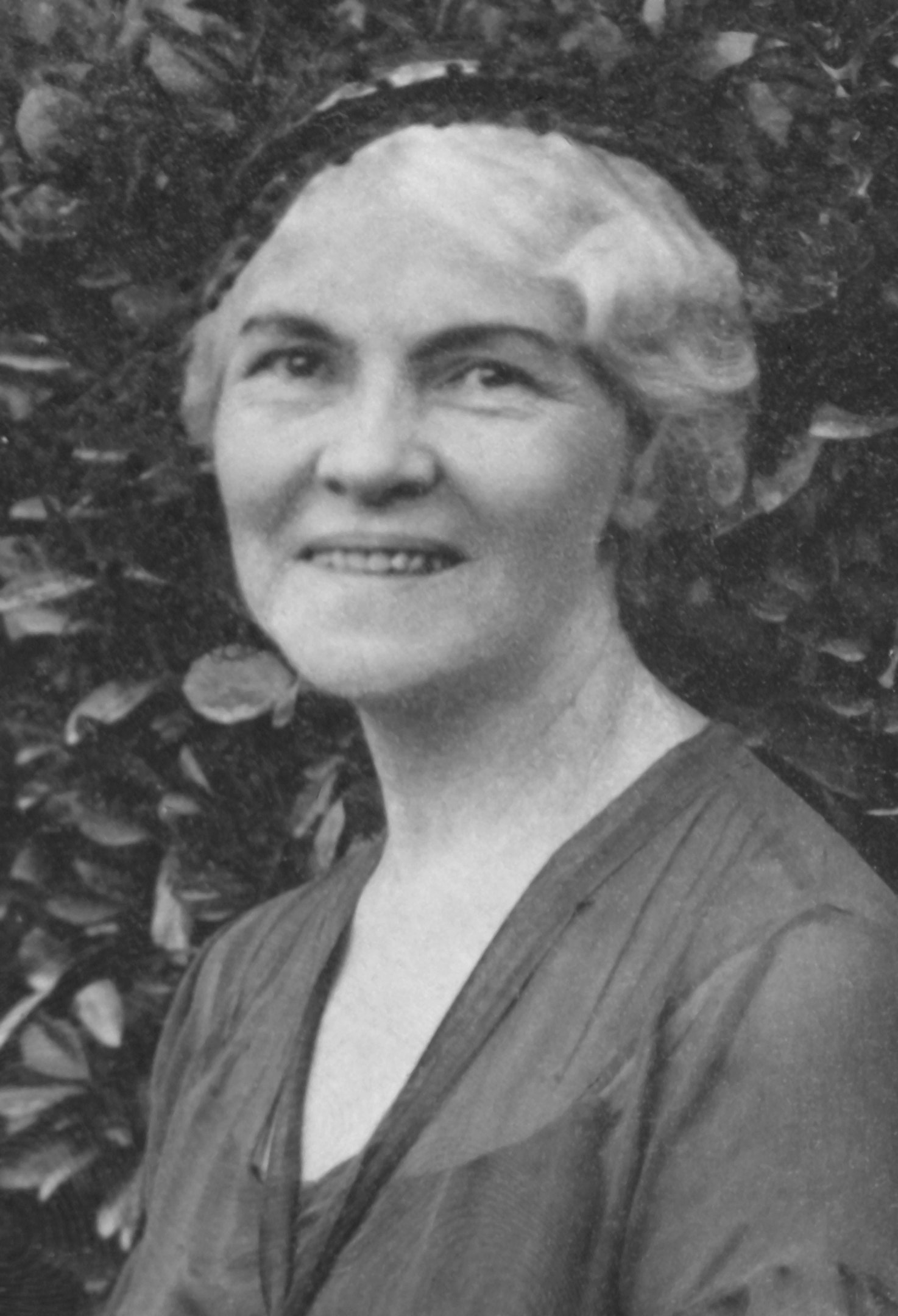
Keith Ransom-Kehler (1876-1933), Hand of the Cause and first American Bahá'í Martyr. Source: Bahá'í Media Bank, © Bahá'í International Community 2023.
On 10 October 1933, Keith Ransom-Kehler fell ill and was initially diagnosed with measles. Keith Ransom-Kehler was attended by a couple, Najmiyyih and Raḥmatu'lláh Khán 'Ala'i, both from Ṭihrán, whom the Guardian had tasked with accompanying her on her journey through Persia—and her doctor was Dr. ‘Abbasiyán from Iṣfahán. But Keith Ransom-Kehler’s condition worsened, and, in consultation with other physicians in Iṣfahán, her diagnosis was changed to smallpox and dysentery.
Smallpox is an illness which has now been eradicated from the face of the earth thanks to the smallpox vaccine and absolutely heroic medical efforts in the 19th and 20th centuries—which have gone down in history as the greatest public health achievements in history—but in 1933, in Persia, when Keith Ransom-Kehler contracted it, it was almost certainly a death sentence. Smallpox was a highly contagious and deadly viral disease for which there was no cure and which had a 30% fatality rate.
Keith Ransom-Kehler initially appeared to be improving over several days when she suddenly died from smallpox on 23 October 1933. A funeral procession of nearly 600 Bahá’ís from Iṣfahán accompanied her flower-laden hearse down one of the city's main avenues to the cemetery where she was buried near the tombs of the King of Martyrs and the Beloved of Martyrs.
Shortly before her death, she looked back on her time in Persia in an entry in her personal diary:
I have fallen, though I never faltered. Months of effort with nothing accomplished is the record that confronts me. If anyone in future should be interested in this thwarted adventure of mine, he alone can say whether near or far from the seemingly impregnable heights of complaisance and indifference, my tired old body fell. The smoke and din of battle are to-day too dense for me to ascertain whether I moved forward or was slain in my tracks.
Keith Ransom-Kehler passed away in Iṣfahán on 23 October 1933. Five days later, the Guardian spoke elevated her to the rank of Hand of the Cause and the first America Bahá'í martyr:
Keith's precious life offered up sacrifice beloved Cause in Bahá'u'lláh's native land. On Persian soil for Persia's sake she encountered challenged and fought forces of darkness with high distinction indomitable will unswerving exemplary loyalty. Mass of her helpless Persian brethren mourn sudden loss their valiant emancipator American believers grateful and proud memory their first and distinguished martyr. Sorrow stricken I lament earthly separation invaluable collaborator unfailing counsellor esteemed and faithful friend. Urge local Assemblies befittingly organize memorial gatherings in memory one whose international services entitle her eminent rank among Hands of Cause of Bahá'u'lláh.

"Change in tone." Photo by Joel Vodell on Unsplash.
The Guardian had begun his ministry as a 24-year-old youth, whose youth had vanished the second he heard the contents of 'Abdu'l-Bahá’s Will and testament.
Over the course of the first decade of his Guardianship, all the remains of Shoghi Effendi’s youthfulness progressively died out, especially after the second greatest heartbreak of his life, the passing of the Greatest Holy Leaf but also as a result of deeply-tragic unexpected events, and the attacks of the Covenant-breakers. In Rúḥíyyih Khánum’s words, by the 1930s:
Something of the tender and trusting youth has gone forever.
Ten years into his ministry, the Guardian’s writings and letters changed, and he emerged a literary giant, his pen transformed into a mighty sword.
In the first ten years of his writings, Rúḥíyyih Khánum affirms that one could sense a combination of modesty and self-effacement, perhaps even an echo of his soul’s tremendous pain at the tragic loss of his Grandfather, but these were replaced, in the 1930s with a change in the Guardian’s tone.
His writings were now imbued with the self-assurance, strength and self-confidence of a general waging a spiritual war.
Rúḥíyyih Khánum saw this change in the Guardian’s words in three places.
- First, in the newfound power with which Shoghi Effendi communicated his directives with the Bahá'í world.
- Second, in the way he began shaping the fledgling Bahá'í Administrative Order, welding diverse and different communities into a unified whole.
- Third, in the beauty and self-confidence of his literary style that steadily became more majestic and eloquent as the decades of his ministry went by.
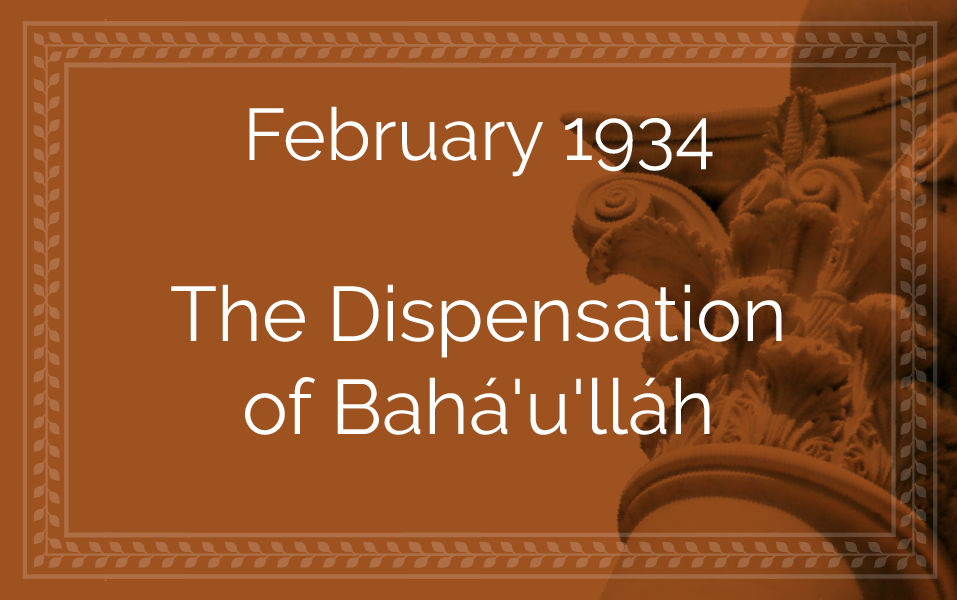
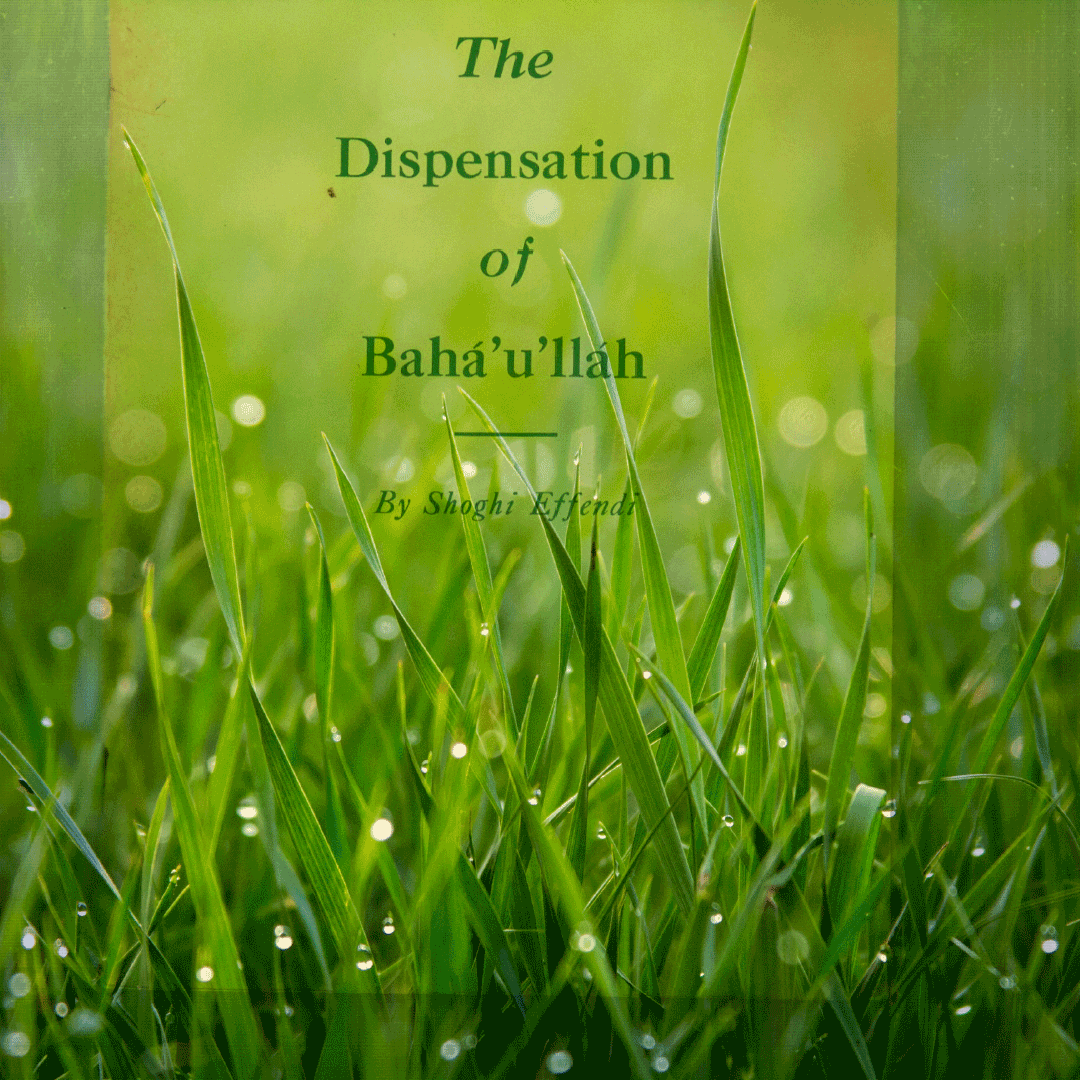
Background photo by Ochir-Erdene Oyunmedeg on Unsplash.
The Great Depression began in the United States in 1929 but its effects spread around the entire world like wildfire, destabilizing societies and pushing political movements to extremes. The crisis lasted 10 years, during which fascism and communism rose—two extremist right and left wing ideologies that had been steadily growing for decades. The Great Depression and its attending ideological lunacy led right up to the doorstep of World War II.
In 1934, in the midst of this economic, social, and political turmoil and confusion, Shoghi Effendi wrote perhaps the weightiest letter of his ministry, one year after his majestic America and the Most Great Peace. It was called the Dispensation of Bahá'u'lláh, a treatise in the form of a letter that was to transcend all letters. When it burst out into the Bahá'í world, it was a watershed event.
When Rúḥíyyih Khánum first read this letter, she was 23 years old, and still Mary Maxwell. She described the effect of The Dispensation of Bahá'u'lláh as a life-changing experience of instant awareness:
I remember when I first read it I had the most extraordinary feeling as if the whole universe had suddenly expanded around me and I was looking out into its dazzling star-filled immensity; all the frontiers of our understanding flew outwards; the glory of this Cause and the true station of its Central Figures were revealed to us and we were never the same again.
The Dispensation of Bahá’u’lláh lays out, like gems, the essential truths of the Bahá'í Faith, the basic, doctrinal verities that are fundamental to the Cause of Bahá'u'lláh.
With regards to Bahá'u'lláh’s New World Order, Shoghi Effendi conceived of The Dispensation of Bahá'u'lláh as an “invaluable supplement” to both the Kitáb-i-Íqán and the Will and Testament of 'Abdu'l-Bahá.
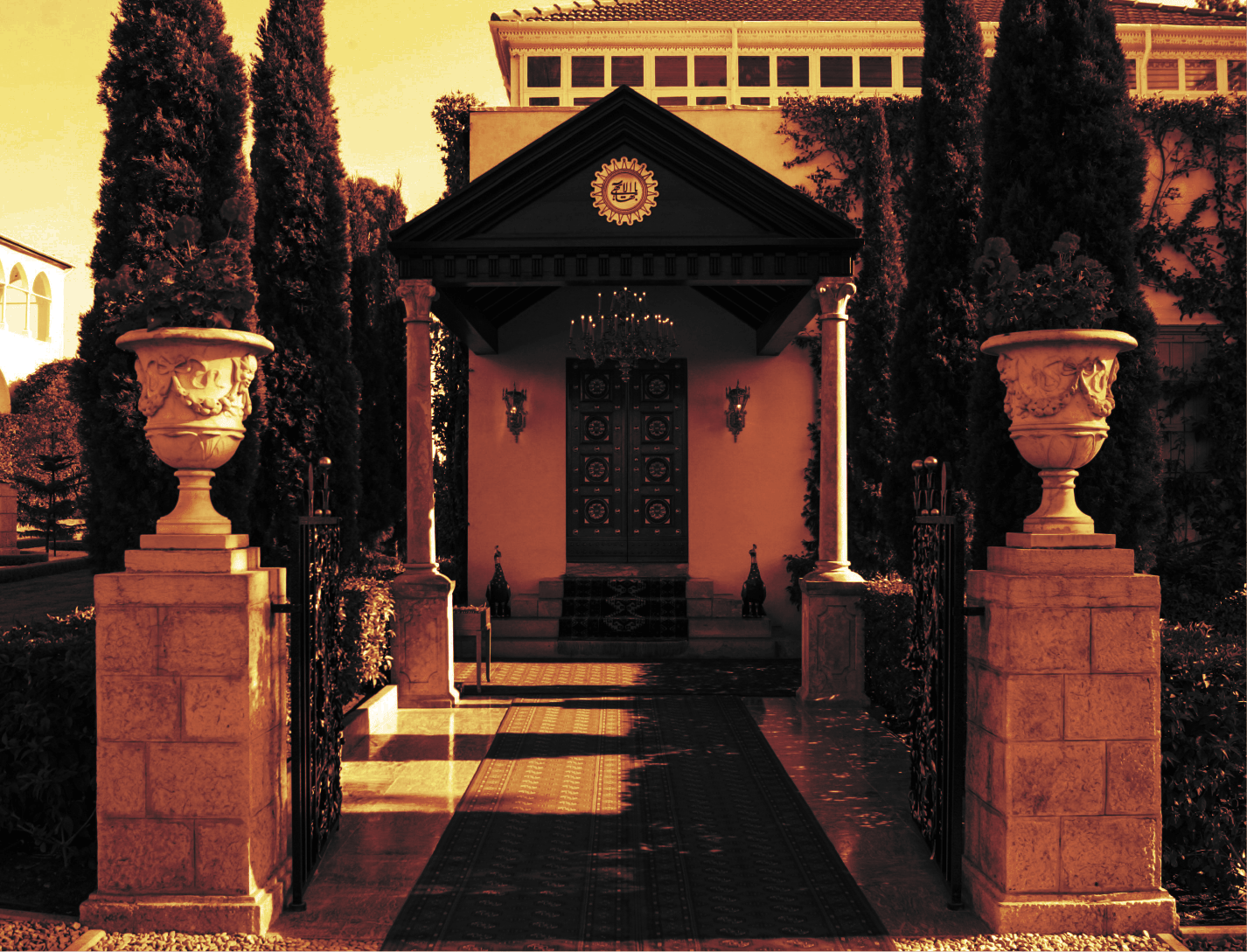
Processed photo of the Shrine of Bahá'u'lláh. Source: Bahá'í Media Bank, © Bahá'í International Community 2023.
This masterpiece is composed of four sections:
- Bahá'u'lláh
- The Báb
- 'Abdu'l-Bahá
- The Administrative Order
In the first section, devoted to expounding on the station of Bahá'u'lláh, Shoghi Effendi categorically states that a Manifestation of God is not an incarnation of God. Shoghi Effendi includes luminous excerpts from the writings of Bahá'u'lláh and the Báb on the greatness of Bahá'u'lláh’s station, but perhaps this early description of His grandeur is a befitting example of the heights of eloquence Shoghi Effendi reaches in this unique and unprecedented letter:
Dominating the entire range of this fascinating spectacle towers the incomparable figure of Bahá’u’lláh, transcendental in His majesty, serene, awe-inspiring, unapproachably glorious
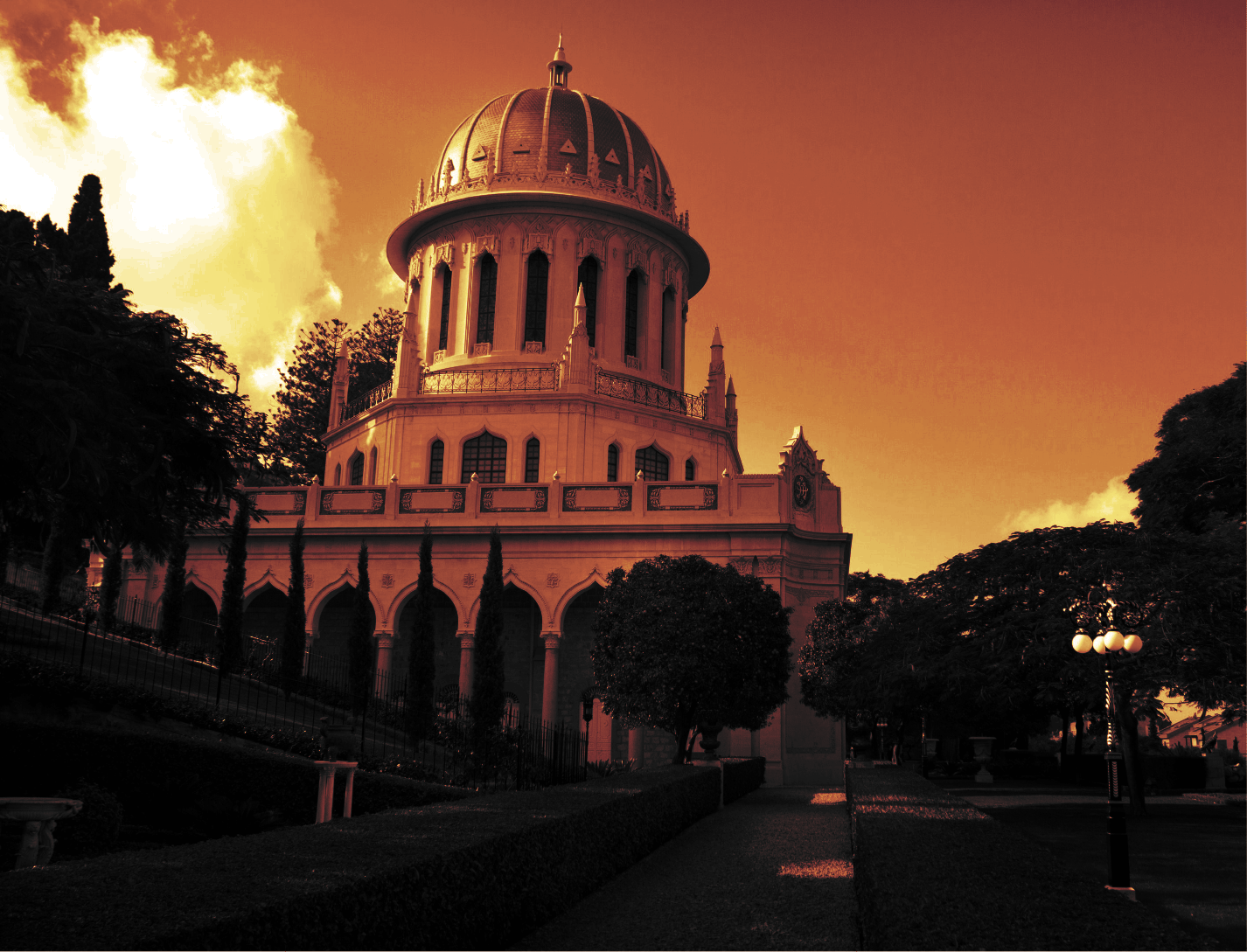
Processed photo of the Shrine of the Báb. Source: Bahá'í Media Bank, © Bahá'í International Community 2023.
In the second section, Shoghi Effendi examines the station of the Báb as an independent Manifestation of God, and not just the prophet-herald of Bahá'u'lláh:
Indeed the greatness of the Báb consists primarily, not in His being the divinely-appointed Forerunner of so transcendent a Revelation, but rather in His having been invested with the powers inherent in the inaugurator of a separate religious Dispensation, and in His wielding, to a degree unrivalled by the Messengers gone before Him, the scepter of independent Prophethood.
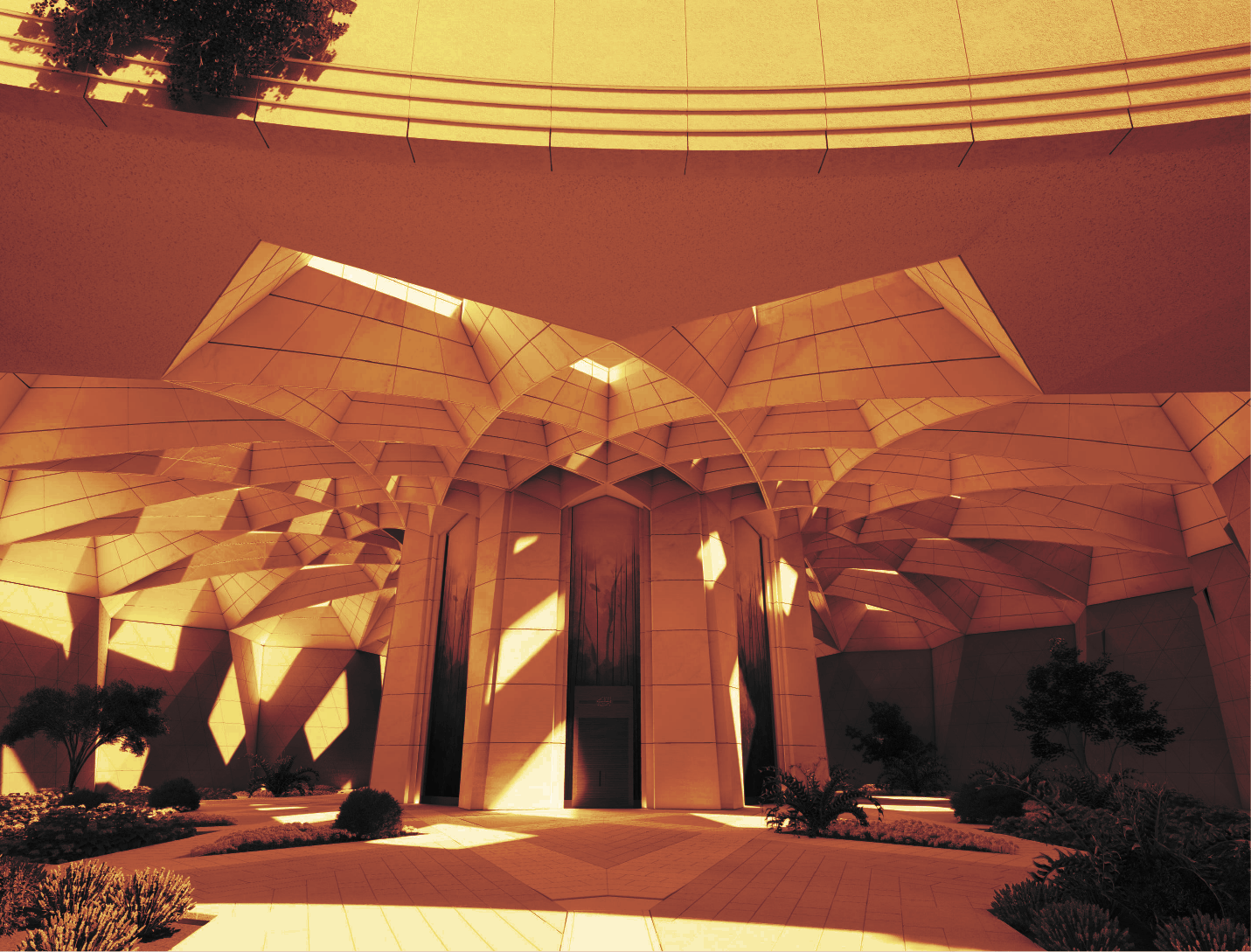
Processed photo of the design for the future Shrine of 'Abdu'l-Bahá. Source: Bahá'í Media Bank, © Bahá'í International Community 2023.
In the third section, Shoghi Effendi dwells on the station of 'Abdu'l-Bahá, the Mystery of God, imbued with all the perfections of a Manifestation of God whilst not possessing that station. Shoghi Effendi acknowledges that understanding the station of 'Abdu'l-Bahá is an arduous exercise:
It would be indeed difficult for us, who stand so close to such a tremendous figure and are drawn by the mysterious power of so magnetic a personality, to obtain a clear and exact understanding of the rôle and character of One Who, not only in the Dispensation of Bahá’u’lláh but in the entire field of religious history, fulfills a unique function…He towers, in conjunction with them [Bahá’u’lláh and the Báb], above the destinies of this infant Faith of God from a level to which no individual or body ministering to its needs after Him, and for no less a period than a full thousand years, can ever hope to rise.
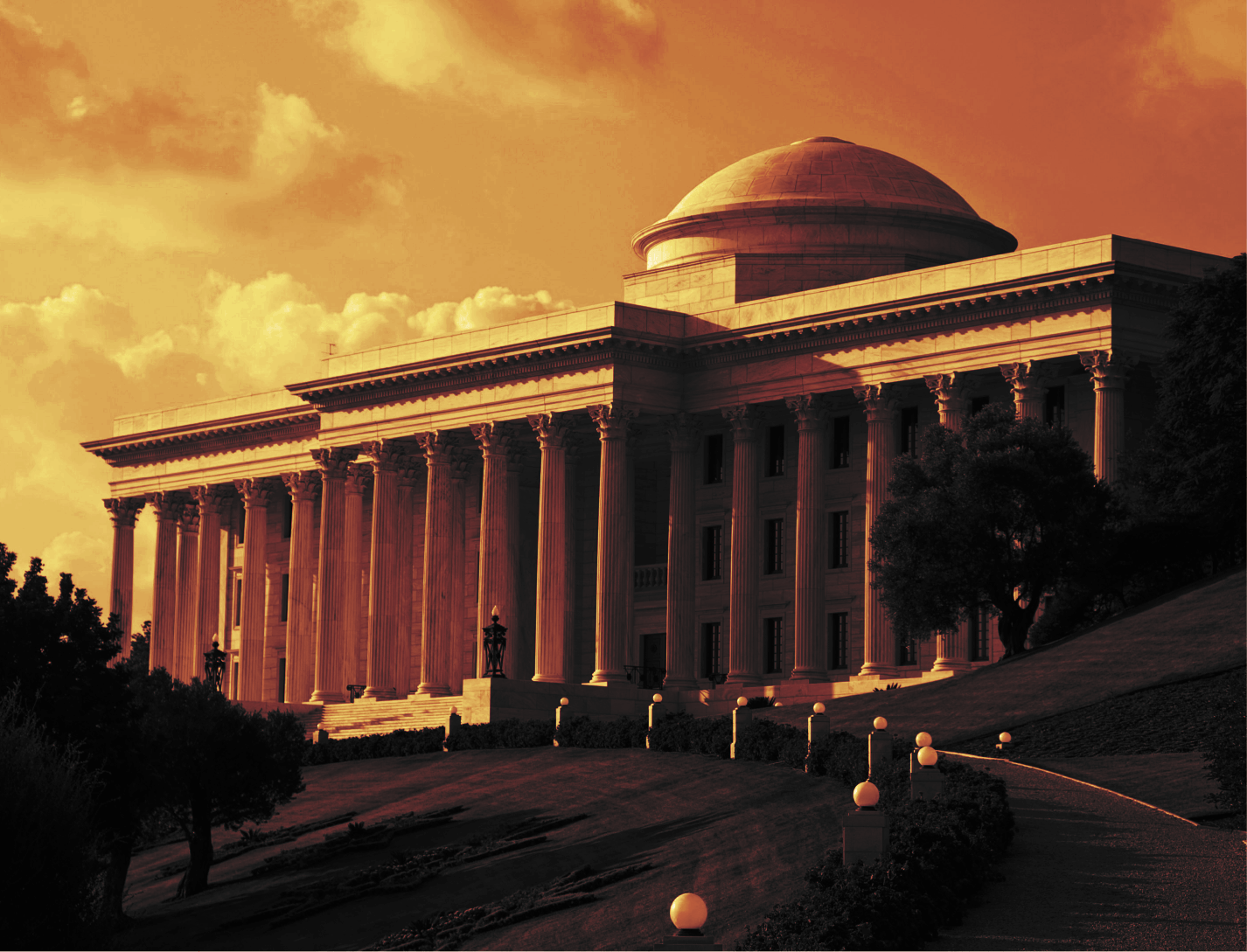
Processed photo of the Seat of the Universal House of Justice. Source: Bahá'í Media Bank, © Bahá'í International Community 2023.
The fourth and final section of the Dispensation of Bahá'u'lláh is devoted to the Formative Age of the Faith and the twin pillars of the Bahá'í Administrative Order: the Guardianship and the Universal House of Justice.
About the Guardianship, Shoghi Effendi states:
Exalted as is the position and vital as is the function of the institution of the Guardianship in the Administrative Order of Bahá’u’lláh, and staggering as must be the weight of responsibility which it carries, its importance must, whatever be the language of the Will, be in no wise over-emphasized. The Guardian of the Faith must not under any circumstances, and whatever his merits or his achievements, be exalted to the rank that will make him a co-sharer with ‘Abdu’l‑Bahá in the unique position which the Center of the Covenant occupies… No Guardian of the Faith, I feel it my solemn duty to place on record, can ever claim to be the perfect exemplar of the teachings of Bahá’u’lláh or the stainless mirror that reflects His light.
And these are his words about the Universal House of Justice:
In the conduct of the administrative affairs of the Faith, in the enactment of the legislation necessary to supplement the laws of the Kitáb-i-Aqdas, the members of the Universal House of Justice, it should be borne in mind, are not, as Bahá’u’lláh’s utterances clearly imply, responsible to those whom they represent, nor are they allowed to be governed by the feelings, the general opinion, and even the convictions of the mass of the faithful, or of those who directly elect them.

Ages and Cycles: Right-click on image to open in a new tab and see it full-size. Alternatively, download the image and open on your computer or device.
The Báb revealed the Badí’ Calendar, Bahá'u'lláh implemented it with the help of Nabíl, the historian, fixing Naw-Rúz, placing the Intercalary Days before the Fast, and 'Abdu'l-Bahá added the 9 holy days. The three Central Figures gave us the Bahá'í Calendar, but the Guardian gave us our understanding of time.
Before Shoghi Effendi, we did not conceive of Bahá'í Ages, Cycles and Epochs. These are all emanations of the genius, infallible mind of Shoghi Effendi and his extraordinary capacity for interpreting history. He was the one who, following the implicit patterns of the teachings and history of the Faith, divided the events that comprised the Heroic Age of the Faith and its three epochs—the ministries of the three Central Figures of the Bahá'í Faith: the Báb, Bahá'u'lláh, and 'Abdu'l-Bahá.
It was Shoghi Effendi who announced the Formative Age—also called the Age of Transition and the Iron Age—which coincided with his ministry, but the Guardian never once mentioned his name in connection to his analysis of the history of the Faith.
The Formative Age was the period marked by the Administrative Order of the Faith, and would see its birth, its evolution, its perfection, and the establishment of the World Order of Bahá'u'lláh—the Kingdom of God on Earth.
The First Epoch of the Formative Age ended in 1944 with the Centenary of the Declaration of the Báb, and its Second Epoch would end in 1963, the year marking not only the Centenary of the Declaration of Bahá'u'lláh, but also the election of the Universal House of Justice.
Bahá'ís could now understand the spiritual forces at play in their own codified history, they could understand the evolution of the Faith, and they could understand how achieving an objective could then, in the future, be slotted into the overall victories of an epoch.
The Dispensation of Bahá'u'lláh holds a very special rank among the long letters the Guardian wrote to the Bahá'í World. Rúḥíyyih Khánum makes it abundantly clear how much importance the Guardian attached to this work:
Shoghi Effendi felt in his inmost heart about his other writings, I know from his remarks that he considered he had said all he had to say, in many ways, in the Dispensation.
Shoghi Effendi repeatedly stated to Bahá'í pilgrims that The Dispensation of Bahá'u'lláh should be regarded as his will and testament.
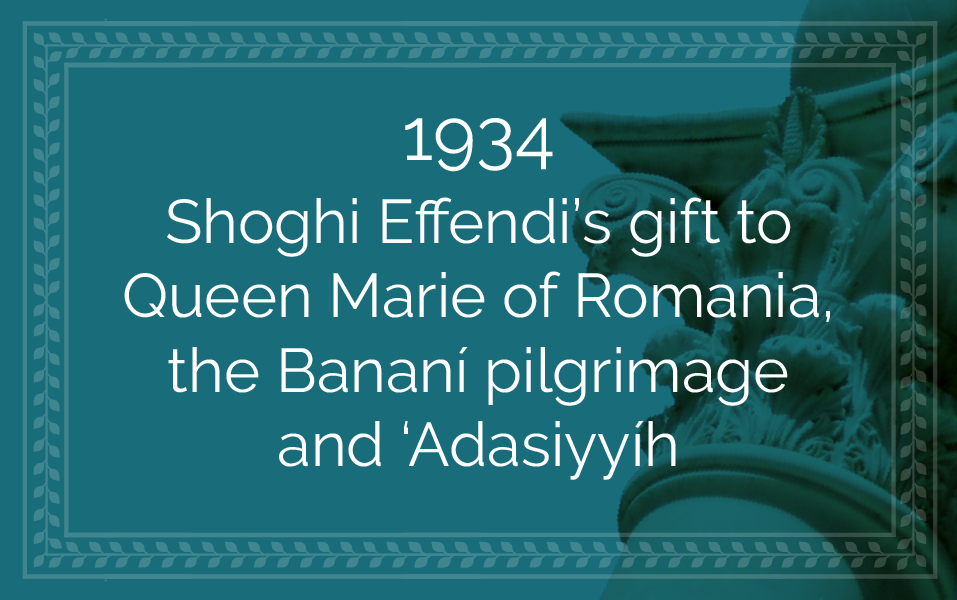
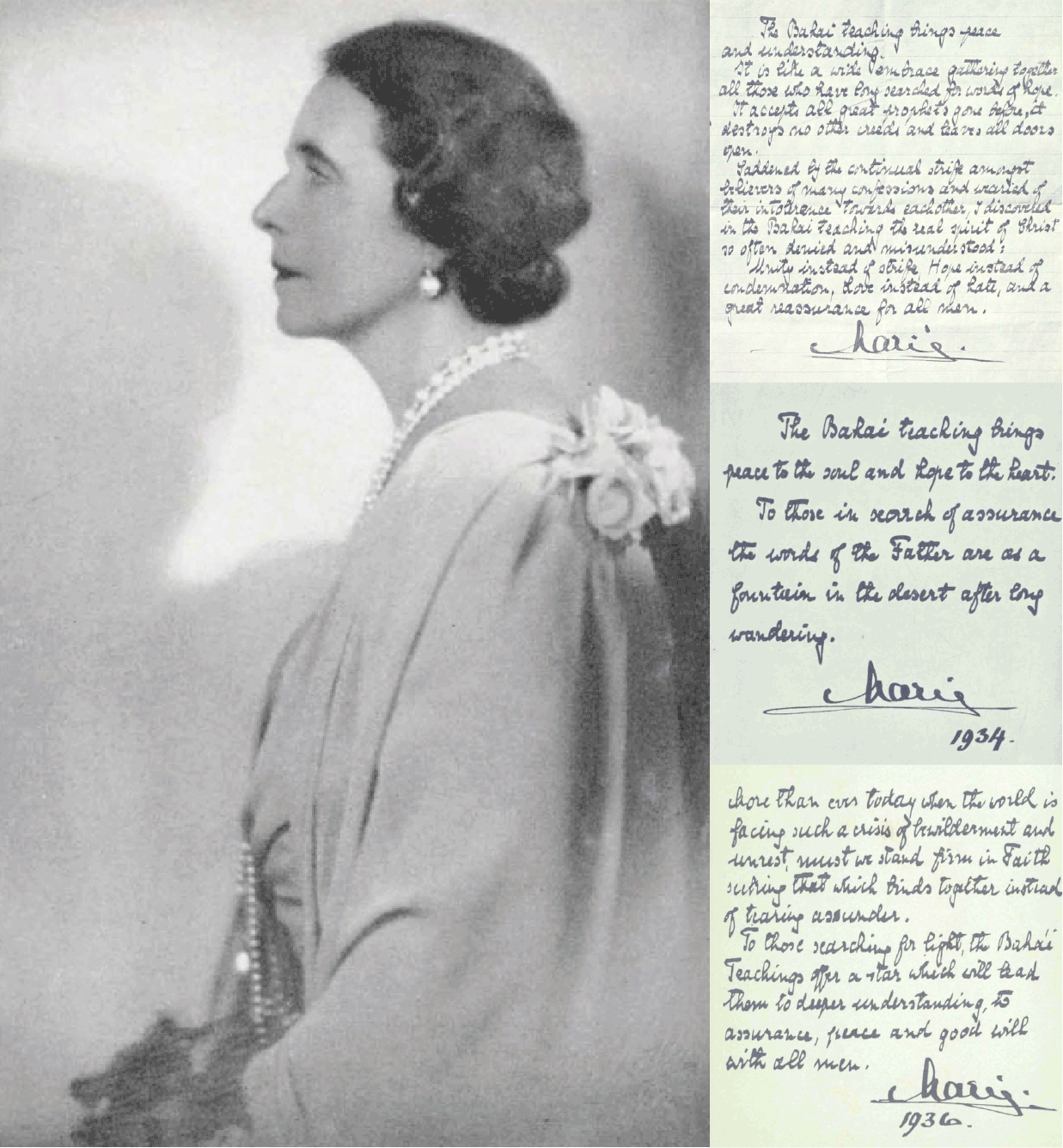
Left: Queen Marie of Romania gave permission for her photograph to appear as the frontispiece for The Bahá'í World Volume 5. Right, top, middle, and bottom: Facsimiles of the Queen’s handwritten and signed appreciation for the Faith were published as frontispieces for Volumes 4, 6, and 8. Source: Bahaimedia.
On 23 January 1934, the Guardian wrote a letter to Queen Marie of Romania with which he enclosed a precious manuscript in the handwriting of Bahá'u'lláh, illumined by a devoted Persian Bahá'í in Ṭihrán:
Your Majesty,
I am deeply touched by the splendid appreciation Your Majesty has graciously penned for the Bahá'í World, and wish to offer my heartfelt and abiding gratitude for this striking evidence of Your Majesty's sustained interest in the Cause of Bahá'u'lláh.
I was moved to undertake its translation in person, and feel certain that the unnumbered followers of the Faith in both the East and the West will feel greatly stimulated in their unceasing labours for the eventual establishment of the Most Great Peace foretold by Bahá'u'lláh.
I am presenting to Your Majesty, through the care of Miss Martha Root, a precious manuscript in the handwriting of Bahá'u'lláh, illumined by a devoted follower of His Faith in Ṭihrán.
May it serve as a token of my admiration for the spirit that has prompted Your Majesty to voice such noble sentiments for a struggling and persecuted Faith.
With the assurance of my prayers at the threshold of Bahá'u'lláh for Your Majesty's welfare and happiness,
I am yours very sincerely,
Shoghi
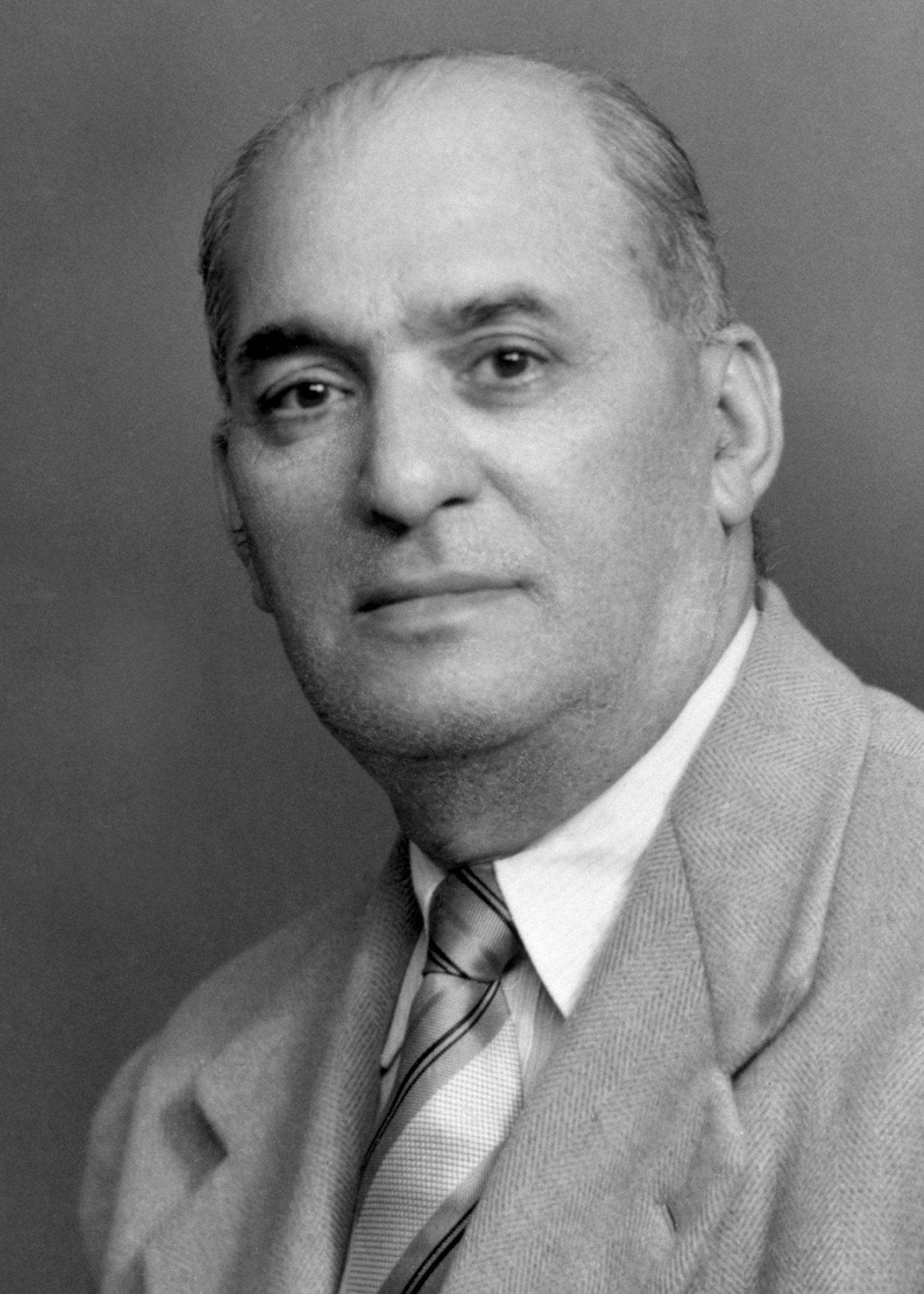
Músá Banání. Source: Bahaimedia.
Músá Banání was born in Baghdad in 1886 in a Jewish family. He became a Bahá'í while he was working in Kirmánsháh as a merchant and entrepreneur in 1913 and becoming a Bahá'í transformed him completely. In 1925, he married Samíhíh Rafí‘ Ardistání and they had six children, including Violette, who would later marry ‘Alí Nakhjávání. Músá Banání was bankrupted at the onset of World War I, then rebuilt his fortune after moving to Ṭihrán.
In 1934, Músá Banání and his wife Samíhíh went on their first pilgrimage to Haifa and spent 26 days in the presence of Shoghi Effendi.
The Guardian had already perceived Músá Banání’s unique devotion, and told pilgrims at the time that Músá Banání was “one equal to a thousand.” The Guardian loved Músá Banání’s simplicity, directness, unbounded energy, and spiritual potential and carefully nurtured these qualities by showering him with a love filled with joy. At the end of Músá Banání’s pilgrimage, the Guardian sent him to Egypt to encourage the Bahá'ís in Cairo, Alexandria, Port Said and Ismá‘ílíyyih.
After his pilgrimage, Músá Banání was deeply enkindled. His proximity to Shoghi Effendi had fused the essence of his being, and his ardent devotion to the Guardian would last him until the end of his life.
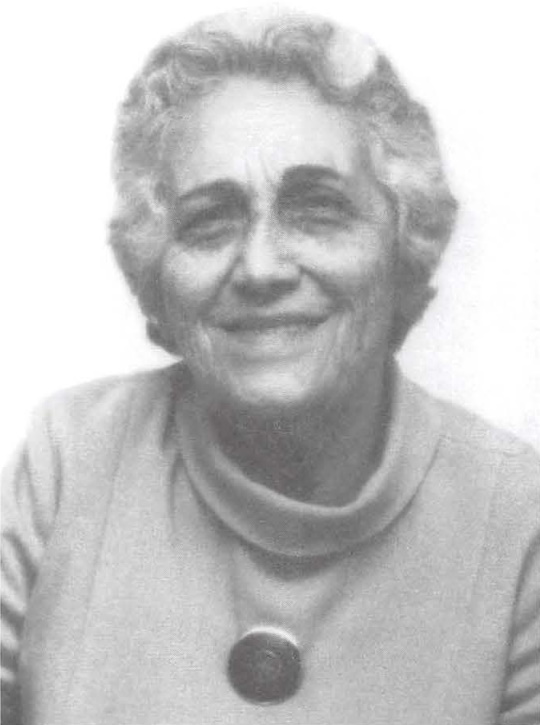
Samíhíh Banání. Source: Bahaimedia.
Samíhíh Banání had an unforgettable experience during this pilgrimage. 'Abdu'l-Bahá’s wife Munírih Khánum recognized her and recounted a story to Samíhíh about her great-grandmother, who, for a time, had lived in a room in the House of ‘Abbúd. One day, Samíhíh’s great-grandmother fell down the stairs and landed on 'Abdu'l-Bahá, and she moved out the House of ‘Abbúd out of embarrassment. Samíhíh didn’t dare ask Shoghi Effendi about this story, but one day, after they had gone to Bahjí, Shoghi Effendi asked Samíhíh:
Did you go to 'Akká?
Samíhíh responded:
Yes.
Did you go to the House of ‘Abbúd?
Yes
Have you been to that room?
Yes.
Then Shoghi Effendi told Samíhíh that 'Abdu'l-Bahá Himself had told him the story of Samíhíh’s great-grandmother falling down on Him.
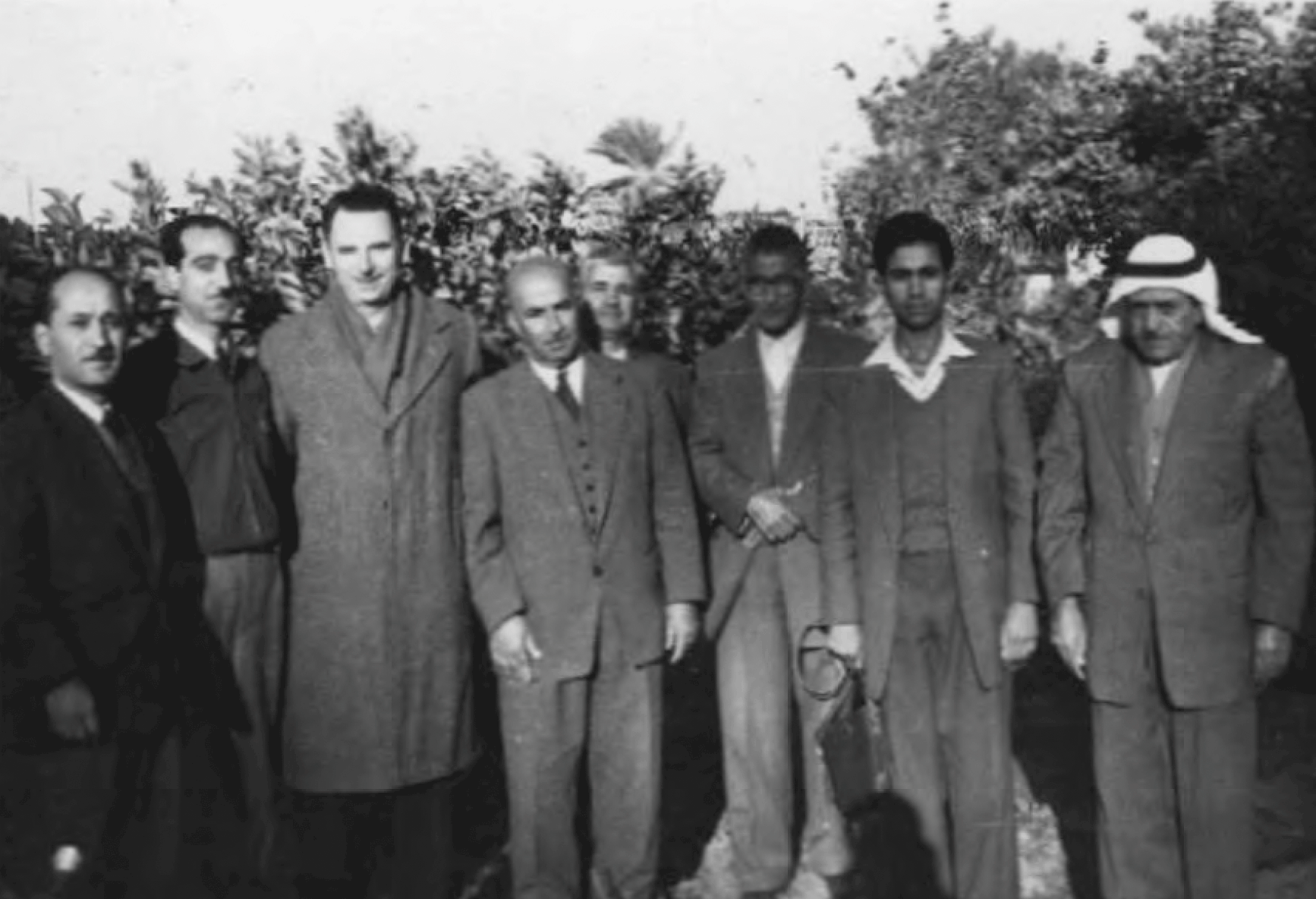
Some of the Baha’is of ‘Adasiyyah standing in front of one of the orchards, 1940s (L. To R.): Shafiq Ehsan, Haydar Asad Touza, Robert Gulick, Husayn Tabrizi, Isfandiyar Siyavushi, Bahram Na‘imi, Davud Forudi, Azizu’llah Forudi (photograph from Hossein Source: ‘Adasiyyah: A Study in Agriculture and Rural Development, Iraj Poostchi Baha’i Studies Review, Volume 16, Number 1, 1 April 2010, page 71.
During one of his visits to ‘Adasiyyah, ‘Abdu’l-Baha stated that he had dedicated the whole of ‘Adasiyyah as endowments to the Shrine of Baha’u’llah. After the passing of ‘Abdu’l-Baha, the farmers continued to pay the 20 per cent share of the harvest to his heirs: Ḍíyá‘íyyih Khánum and Mírzá Hádí Afnán—Shoghi Effendi’s parents—two of 'Abdu'l-Bahá’s daughters—Tuba Khanum and Ruḥá Khánum, and Ruḥí Afnán, Shoghi Effendi’s cousin.
Each farmer could have taken possession of a share of the land, but Shoghi Effendi told the Baha’i farmers not to apply for the ownership titles of their farms. Mirza Hádí Afnán, Shoghi Effendi’s father, also lived and managed a farm in ‘Adasiyyah.
Shoghi Effendi was keenly interested in the work of the Baha’i farmers, and often recommended that they and their children—sons and daughters—study agriculture and learn about appropriate methods and techniques of farming in order to increase yield and lead agricultural change in the region.
‘Adasiyyíh’s agricultural and rural development—initiated by 'Abdu'l-Bahá—increased during Shoghi Effendi’s ministry in both pace and scope. The older, first-generation Baha’i farmers passed on their farms to their children, who took up the work.
Over the years, ‘Adasiyyah became a showcase village for Jordan. The government brought foreign guests and dignitaries to the village to show them the fields of crops, vegetable trucks and the orchards of fruit trees, and 'Abdu'l-Bahá’s banana plantations as well as its schools.
‘Adasiyyíh also had a mature Bahá'í culture: a functioning Local Spiritual Assembly and various committees—like the farming committee that regulated seasonal crops and animal husbandry—and weekly spiritual children’s classes.
Shoghi Effendi was adamant that the children of ‘Adasiyyíh learn Arabic and English, the dominant local languages. He wanted the Bahá'ís to mix with the local population and establish meaningful bonds of friendship.
As a result, in 1934, the Local Spiritual Assembly of ‘Adasiyyíh hired a graduate of the American University in Beirut to come to ‘Adasiyyah and teach both languages.
Shoghi Effendi also gave advice to some farmers. Isfandíyár Siyavushi had left Persia at the age of 12 and worked for some time at the shrines of the Báb and Bahá'u'lláh when Shoghi Effendi advised him to settle in ‘Adasiyyíh and farm. Isfandíyár Siyavushi obeyed, and began growing eggplants and other vegetables, as well as lentils, wheat, and chickpeas.
The farmers of ‘Adasiyyíh had a long-standing tradition since the days of 'Abdu'l-Bahá, to bring vegetables, fruits and dairy products as gifts when they went to visit Him in Haifa, and this tradition extended to Shoghi Effendi’s ministry.
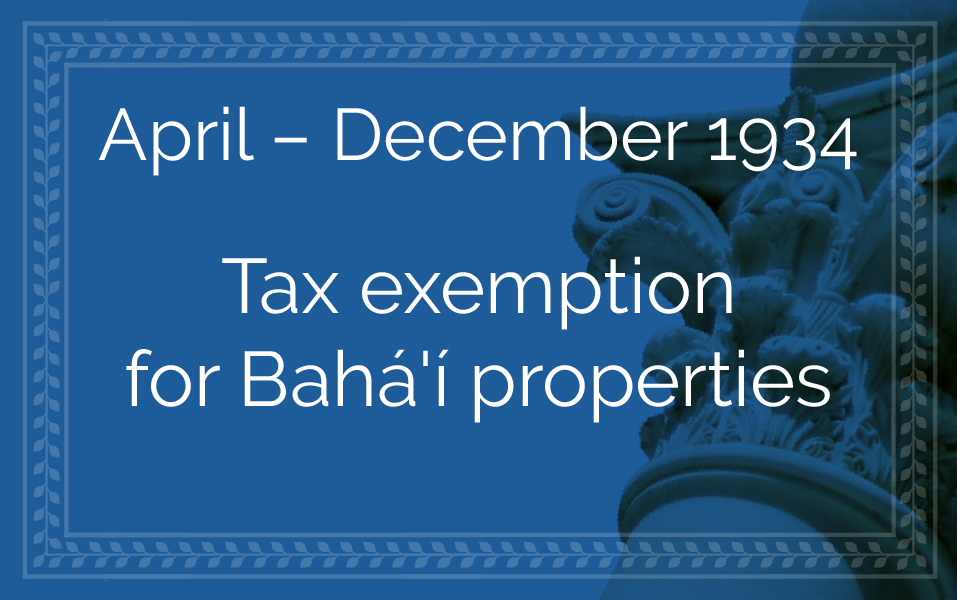
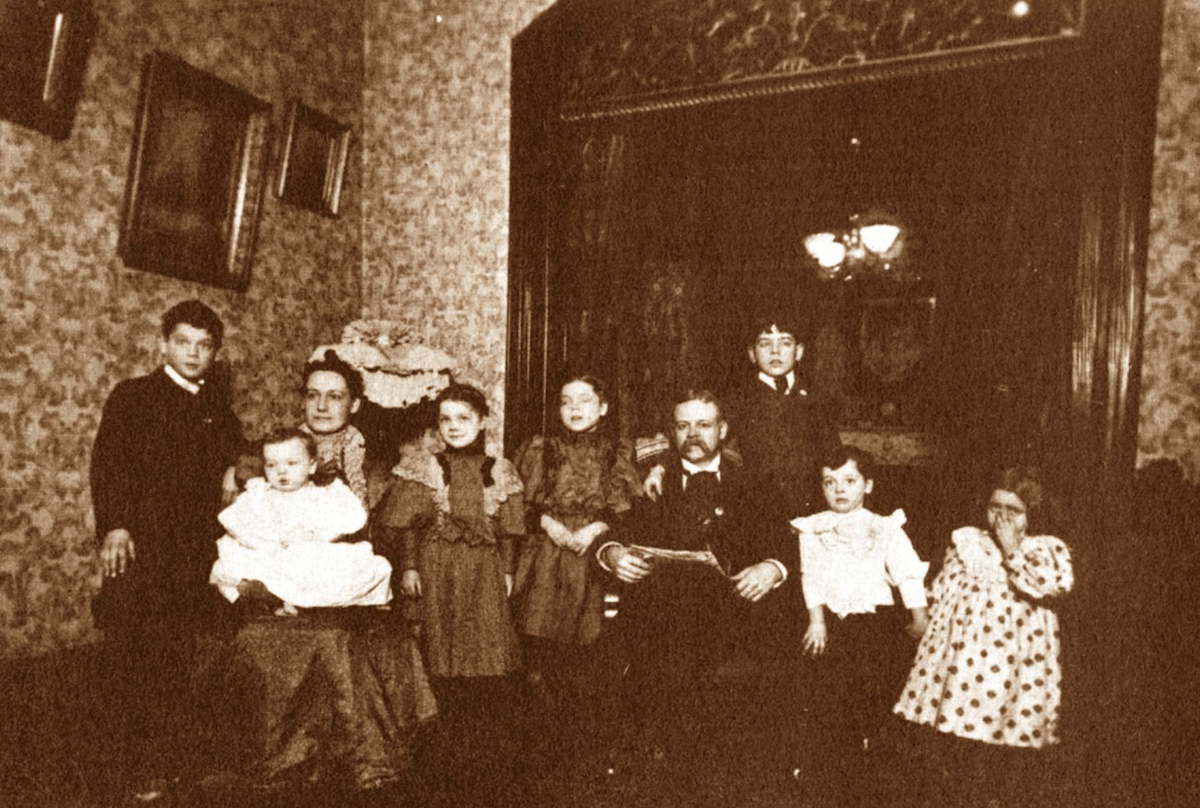
Corinne True, the mother of 7 children, taking care of Shoghi Effendi and worrying over his eating enough. Pictured here are Corine and Moses True and their 7 children. Corinne True was one of the very few Westerners to ever have met 'Abdu'l-Bahá in 'Akká when He was still a Prisoner of the Ottoman Empire. Source: Bahaimedia.
No doubt one of the reasons both 'Abdu'l-Bahá and Shoghi Effendi loved Corinne True so much was her loving candor and aptitude to be totally frank, honest, and direct, while being loving, respectful and kind, a combination extremely rare..
During her pilgrimage in the spring of 1934, Corinne True vividly demonstrated her particular mixture of loving frankness. During her first dinner at the western Pilgrim House with Shoghi Effendi, she looked at his plate and said:
Shoghi Effendi, you are not eating enough.
Shoghi Effendi protested:
But, Mrs. True, that’s all I want.
Corinne True replied:
You need to eat more, for eating only twice a day isn’t enough.
The other Bahá'ís at the dinner table were shocked by Corinne True’s directness, but they soon realized that the Guardian was moved by Corinne’s motherly concern for him. After all, she said exactly what the Greatest Holy Leaf always told Shoghi Effendi when she was alive. She too, had been deeply concerned with making sure Shoghi Effendi ate enough. The Guardian, in any case, would never have been offended by words that came out of great love for him.
In fact, the Guardian loved Corinne True so much, that she would receive over 70 letters written by the Guardian’s secretary, and always including a handwritten note from Shoghi Effendi. The Guardian always encouraged Corinne True to write to him, even once telling her in one of his early letters:
I value greatly your views and feelings as they proceed from a heart that is wholly consecrated to His love and mind that thinks of naught but service to His Cause.
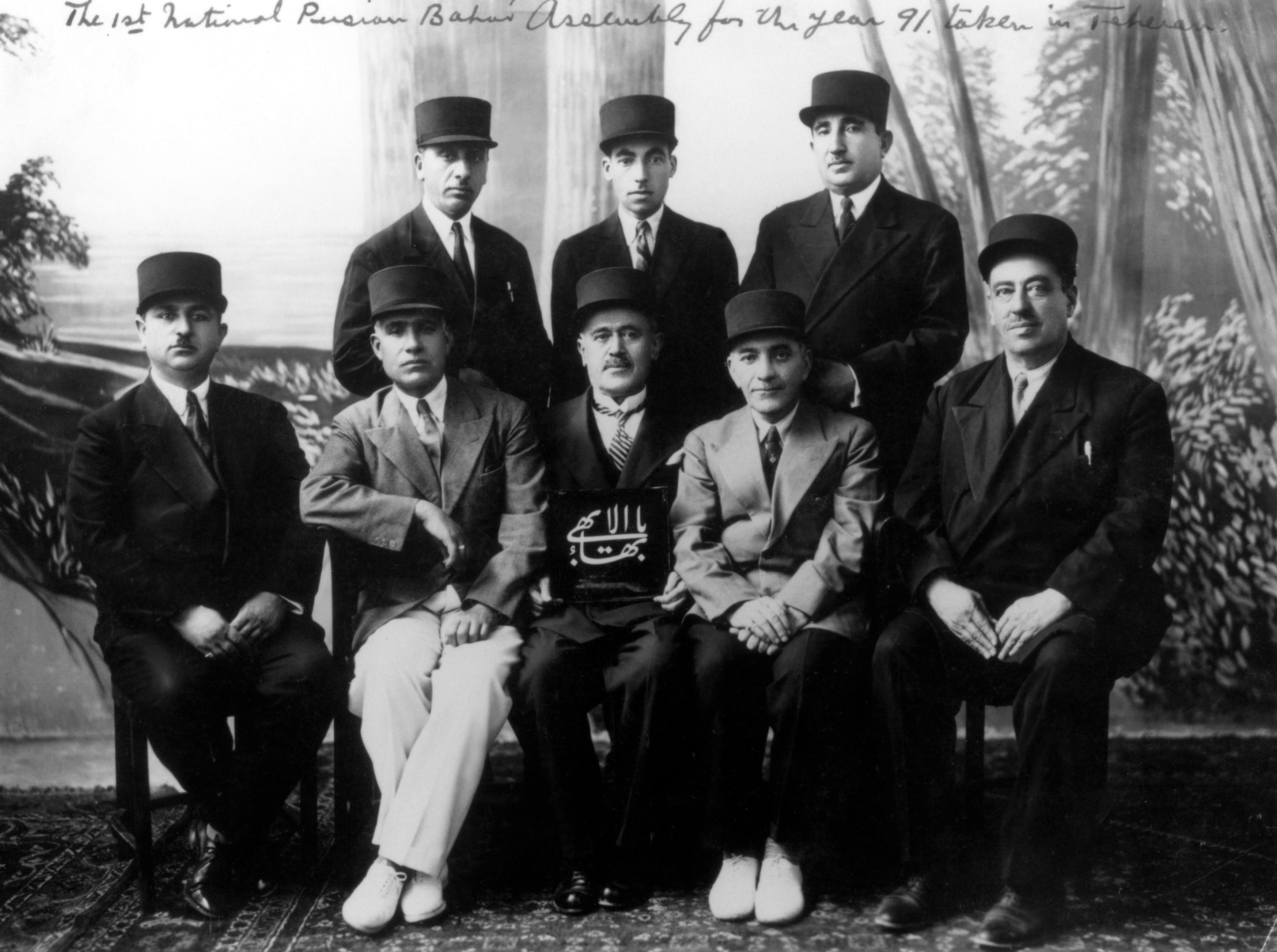
First National Spiritual Assembly of the Bahá’ís of Persia, 1934. Source: Bahá'í Media Bank, © Bahá'í International Community 2023.
The Bahá'ís of Persia had elected a National Spiritual Assembly since 1927, but the Guardian did not consider it to be official until 1934, when the Assembly was elected according to his specific guidelines.
The first real Annual Convention of Persia took place in Ṭihrán between 26 April and 3 May 1934. They followed the Guardian’s specific criteria for the election of the National Spiritual Assembly in two steps, to the letter: the Bahá'ís of Persia elected 95 delegates proportionately through the 20 administrative divisions representing all regions of the country, and the National Spiritual Assembly was duly and properly elected according to Bahá'í law by the 84 delegates present at National Convention.
The first duly elected National Spiritual Assembly of the Bahá'ís of Persia, recorded by the Guardian in May 1934, and its elected members were: Valíyu’lláh Khán Varqá, Shu‘a’u’lláh Khán ‘Alá’i, Dr. Youness Khan Afroukhteh, Jináb-i-Fáḍil-i-Mázinḍaráni, Amín—Amín, Aḥmad Khán Yazdaní, ‘Alí-Akbar Khán Furútan, ‘Ináyatu’lláh Khán Aḥmadpúr, and Maḥmud Khán Badi’í.
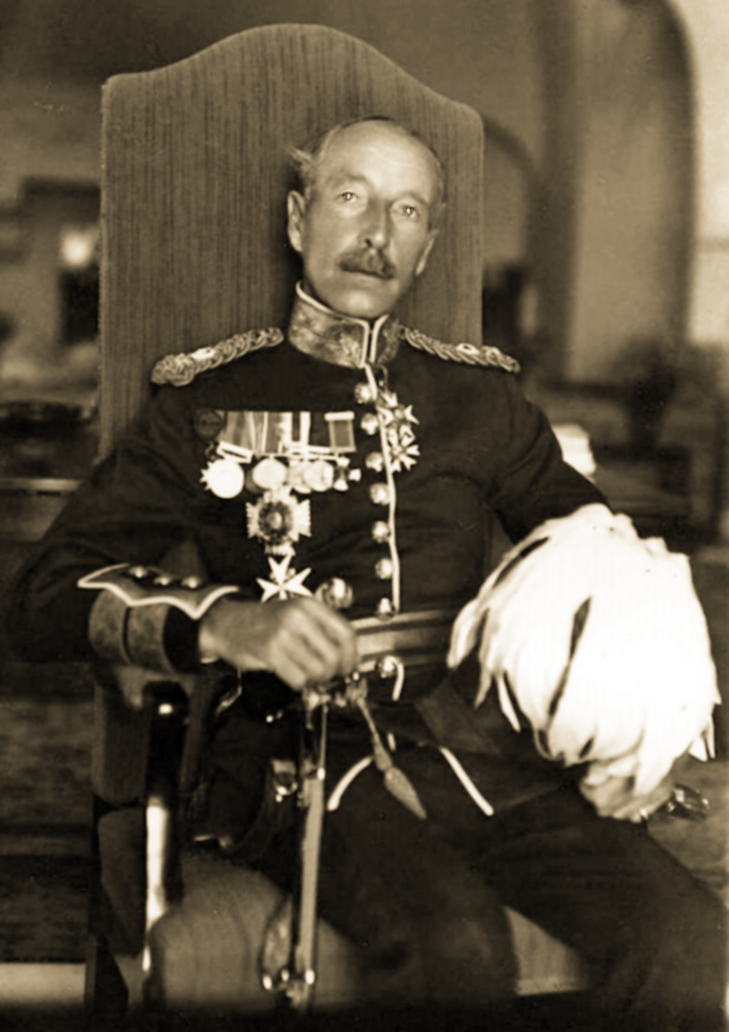
High Commissioner of Palestine Arthur Grenfell Wauchope, some time between 1920 and 1940. Source: Wikimedia Commons.
Shoghi Effendi often referred to the Holy Land as the "heart and nerve centre" of the Faith. It was not difficult for him to obtain tax exemptions for places of Bahá'í pilgrimage, such as the Shrines, because they had sacred associations, and were visited by pilgrims who traveled from around the world to pay their respects at the thresholds.
Full exemption from all taxation, including customs duty was far more difficult to obtain for other Bahá'í properties, and it was one of the Guardian’s great achievements in his ministry, which he began working on in the early 1930s.
Sir Arthur Wauchope was the High Commissioner for Palestine at the time, and was a fair and courteous man.
On 26 June 1933 Sir Arthur Wauchope wrote to the Guardian:
I have received your letter of 21st June and I hasten to write to thank you for it and to assure you that when the case which you mention is referred to me for a decision under the Palestine (Holy Places) Order in Council, it will receive my most careful consideration.
Between 1933 and 1934 there was a period of arduous negotiations between the Guardian and the government of British Mandate Palestine, and a year after Sir Arthur Wauchope’s letter, Shoghi Effendi cabled the United States and Canada on 10 May 1934 with wonderful news:
Prolonged negotiations Palestine authorities resulted exemption from taxation entire area surrounding dedicated Shrines Mount Carmel.
To the Guardian, as he explained to the National Spiritual Assembly, this was equivalent to "securing indirect recognition sacredness Faith International Centre…”
The same day, the Guardian wrote to Sir Arthur Wauchope:
The gratifying news has just come to me from the District Commissioner at Haifa that the petition for exemption from taxation of the Bahá'í property holdings on Mt. Carmel has been granted by the Government.
The Guardian added his and the Bahá'í community’s deep appreciation for his interest in this matter and stated that this exemption would open the way for "our plan to gradually beautify this property for the use and enjoyment of the people of Haifa…"
The Guardian went through enormous tests in signing contracts, purchasing, exempting from taxes and safeguarding the properties at the Bahá'í World Centre. There were litigations that lasted for years, financial issues, how much money was available at the World Center versus how much was needed, there were tight deadlines, that every single time the Guardian needed to meet.
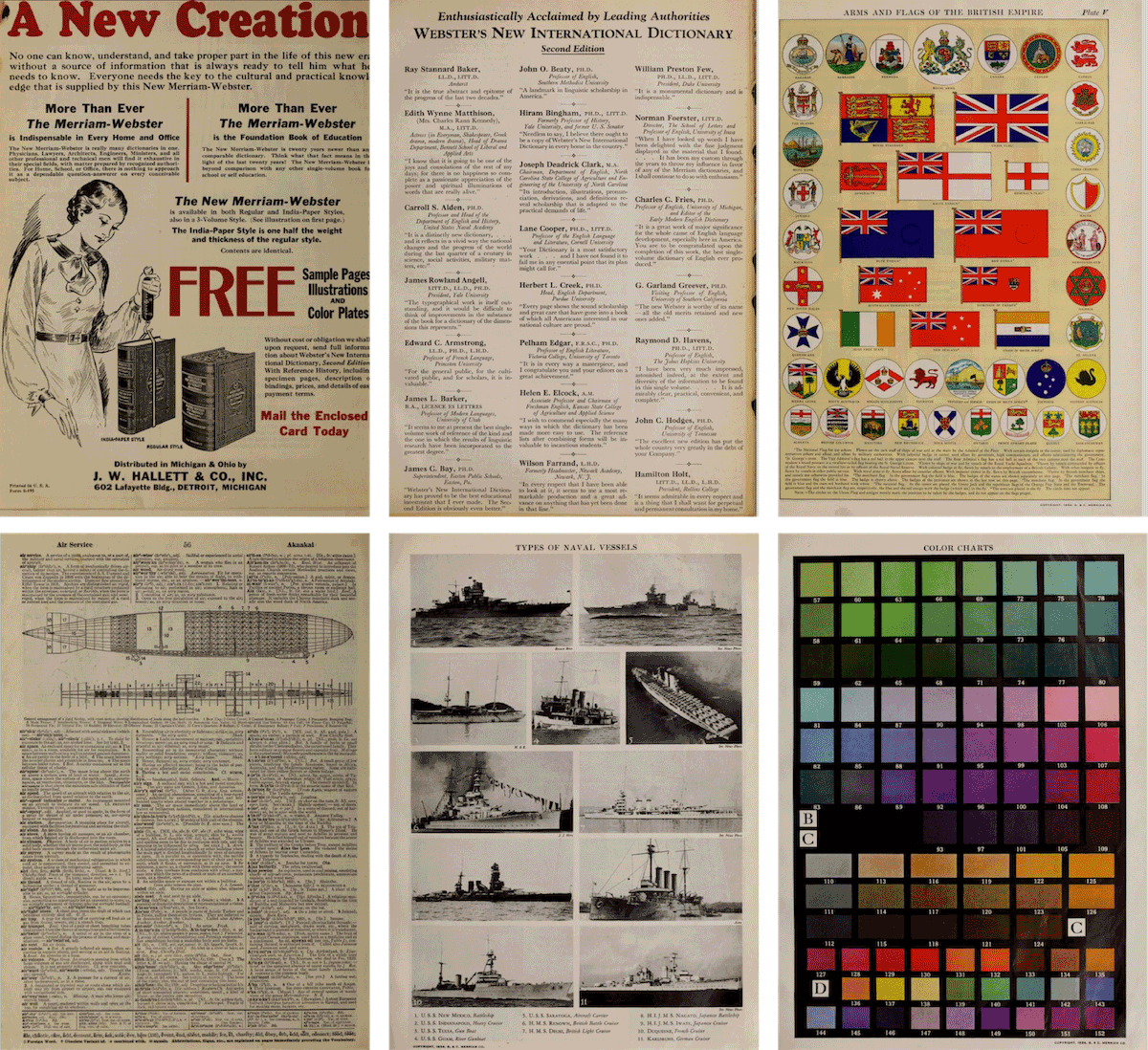
The Guardian’s favorite dictionary was the Webster’s New International Dictionary of the English Language, Second Edition, published in 1934. It was a very big, heavy tome, which he referred to often, and asked Rúḥíyyih Khánum to bring to him when he needed it. Although the Guardian had a perfect command of English, he liked to use the third or fourth meaning of a word, at times bordering on the archaic, and this was one of the main uses of the Websters’.
The Websters’ Second Edition contained 600,000 entries and was 3,350 pages and sold for $39.50—adjusted for inflation this represents $900 today. The Websters’ also had gorgeous illustrations throughout. Some versions added a supplement called A Reference History of the World, which provided chronologies from Ancient history to the present—it is unknown if the Guardian owned this supplement.
The feature the Guardian loved so much was that the Websters’ provided multiple definitions for each word, in chronological order from most ancient to most recent. As an example, the first definition of “starve” includes dying of exposure to the elements as well as from lack of food.
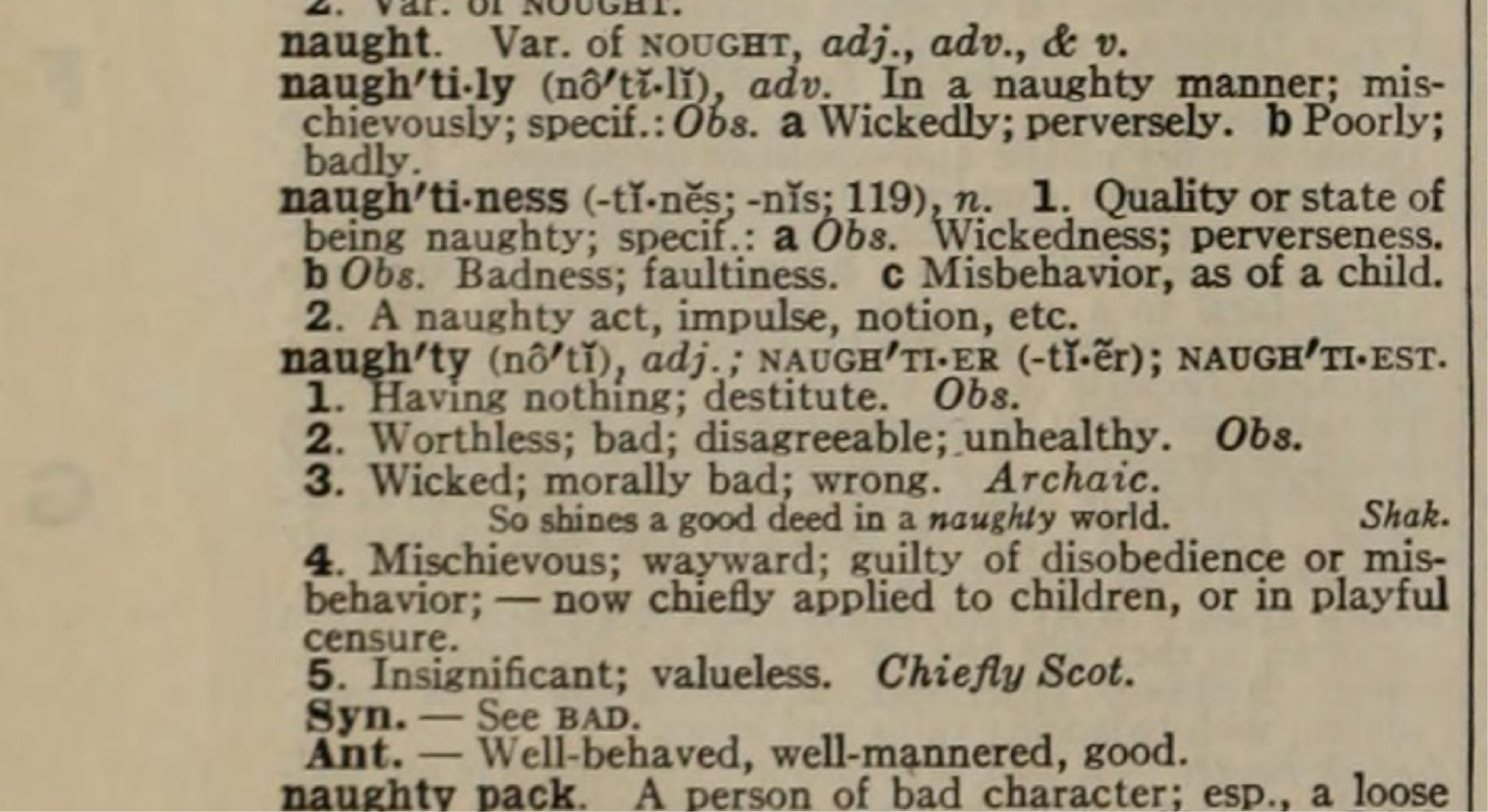
In God Passes By, when relating the Báb’s last address to the vast multitudes of Persians of Tabríz about to watch him be shot and martyred, the Guardian translates the original Persian with an archaic, seldom-used word, “wayward”:
O wayward generation! Had you believed in Me every one of you would have followed the example of this youth, who stood in rank above most of you, and would have willingly sacrificed himself in My path. The day will come when you will have recognized Me; that day I shall have ceased to be with you.
Wayward itself does not actually appear in the Second Edition of Websters’ but is listed as the fourth definition for the word “naughty.” Here is the entire Websters’ entry for the word, and as you will see, the definitions go from obscure to archaic, to modern to just used in Scotland. The word “wayward,” which was exactly what the Guardian wanted to describe the crowd, is in the description of the fourth meaning of the word— guilty of disobedience or misbehavior.
Naughty, adjective
- Having nothing; destitute. Obsolete.
- Worthless; bad; disagreeable; unhealthy. Obsolete.
- Wicked; morally bad; wrong. Archaic.
- Mischievous; wayward; guilty of disobedience or misbehavior; now chiefly applied to children, or in playful censure.
- Insignificant; valueless. Chiefly Scottish.
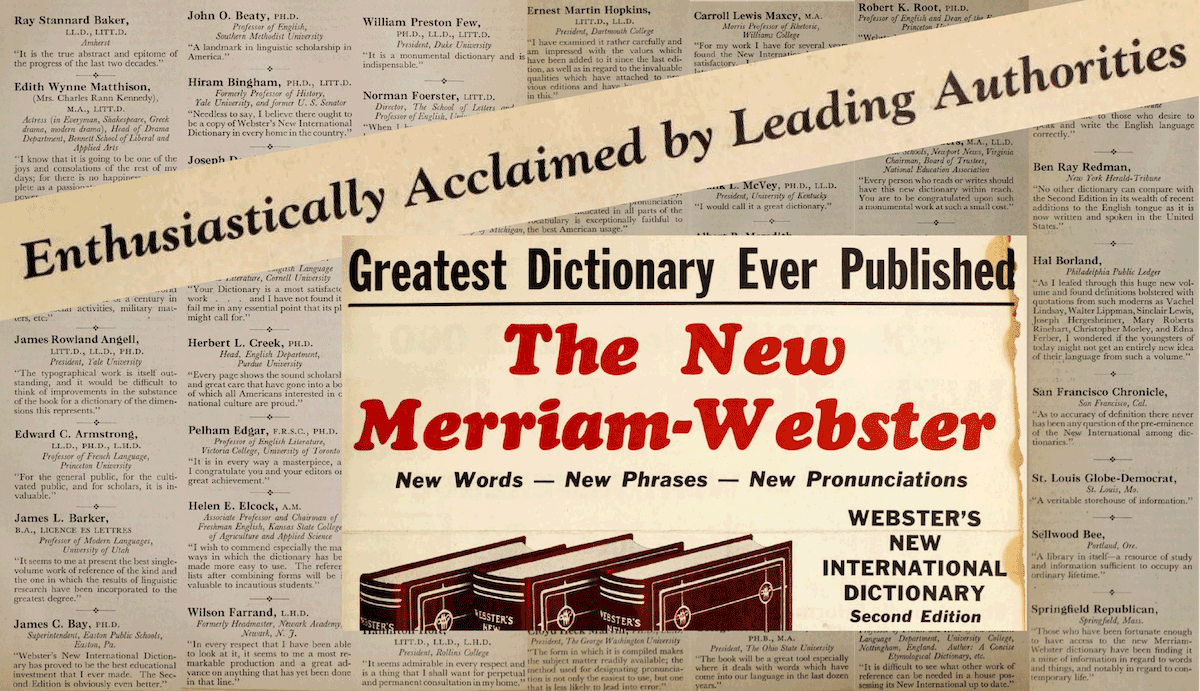
The review of the Websters’ New International Dictionary of the English Language, Second Edition by Eric John Holmyard—an English science teacher at Clifton College, a public school in the city of Bristol in South West England, and historian of science and technology—in the 20 October 1934 supplement to Nature Journal Issue number 3390, calls Webster’s New International Dictionary of the English Language, Second Edition a ”long-anticipated” “monument of lexicography,” “inimitable in conception and unexcelled in achievement, and has won, on its merits alone, a place of pre-eminence in a world by no means ill-provided with dictionaries of high rank.”
Holmyard compares the Websters’ with the gold standard, the Oxford English Dictionary (the OED), and the Webster’s wins on all counts. It was much cheaper, was one single volume, as opposed to the OED, which filled an entire library with volumes.
Websters went above and beyond defining words, often providing illustrations, context, etymology, the history of uses for a particular technology with the dates they were conceived the names of their inventors.
The Websters’ also had other useful features: a biographical section with 13,500. Names, a table of various forms of address, a section on signs and symbols, a lengthy list of abbreviations, color plates of national flags, the history of the English language, and a pronunciation guide, among many, many other features.
Holmyard ends his review by saying:
[The Websters’] have placed the whole of the English-speaking world under a lasting debt to them; and they should feel happy in the thought that "Webster", re-invigorated and reinforced, has once more undertaken its task of universal service. The dictionary-maker is no longer “a harmless drudge”; he is a vital factor in the advance of learning and the progress of civilization.
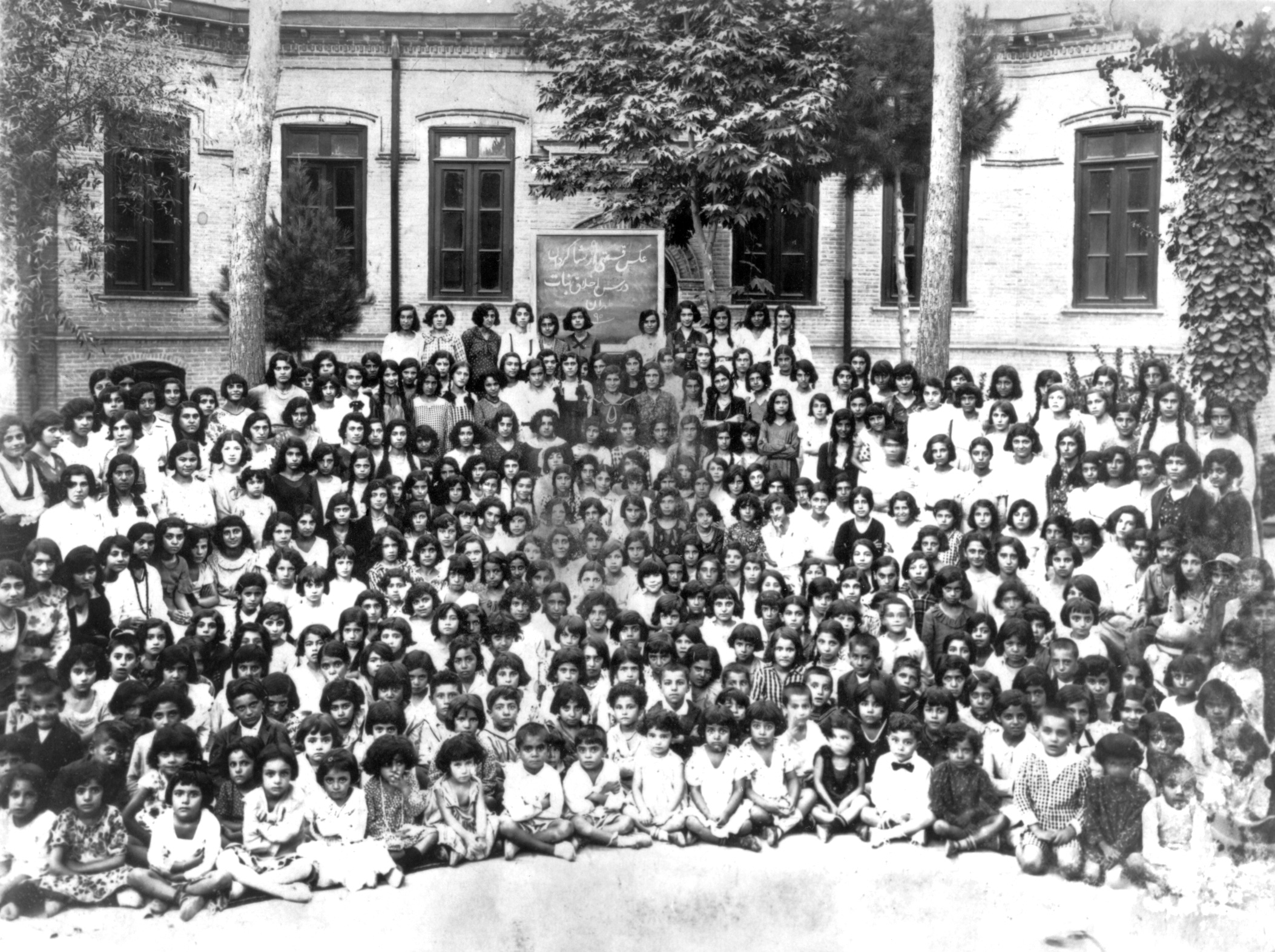
The Tarbiyát School in Ṭihrán around 1911, 13 years before it was closed by Government Decree in 1934. Source: Wikimedia Commons.
The Tarbíyat boys' and girls' School, owned and managed entirely by the Bahá'ís, had been founded during the ministry of 'Abdu'l-Bahá in 1898. By 1924, the schools had been in operation for 36 years, and although its students were mainly Bahá'ís, children of all denomination attended the school which had an excellent reputation.
Because it was a Bahá'í school, The Tarbíyat School had always closed on the nine Bahá'í Holy Days, and suddenly, in early December 1934, the Ministry of Education instructed the school to remain open on Bahá'í Holy Days. The excuse was that Bahá'ís belonged to a non-officially-recognized religion in Persia, asking them to dissimulate, hide in society and not express their religious beliefs publicly.
The upcoming Holy Day was the commemoration of the Báb’s martyrdom—celebrated at the time according to the Muslim Lunar calendar on 6 December 1934—and Shoghi Effendi flatly refused to leave the Tarbíyat school open on the Holy Day or allow the Bahá'í school to hid its Faith. He ordered the school to remain closed in observance of the Martyrdom of the Báb.
On that day, 6 December 1934, the Minister of Education closed the Tarbíyat Bahá’í Schools in Tihrán and 19 other schools in Persia in Káshán, Qazvín, Yazd, Najafábád, Ábádih and Sultanabad.
Immediately after hearing the news, Shoghi Effendi wired the Persian National Assembly:
Has Tarbíyat School been permanently closed enquire and wire.
The Persian National Assembly replied:
Pursuant with your request on day Bab's Martyrdom both Tarbíyat Schools Teheran were closed therefore Ministry Education obliged close both schools and asked why we did not dissimulate…
The next day, the Guardian cabled the Bahá'ís of the United States and Canada apprising them of the horrifying situation in Persia, where not only Bahá'ís schools had been closed but the Bahá'í community countrywide was experiencing new persecutions incited by the clergy, and asking the Bahá'ís to contact authorities:
Information just received indicates deliberate efforts undermine all Bahá'í institutions in Persia. Schools in Kashan, Qazvin, Sultanabad closed. In several leading centres including Qazvin Kirmánsháh orders issued suspend teaching activities, prohibit gatherings, close Bahá'í Hall, deny right burial in Bahá'í cemeteries. Bahá'ís of Teheran compelled under penalty imprisonment register themselves Moslems in identity papers. Elated clergy inciting population. National Teheran Assembly's petitions to Shah undelivered rejected. Impress Persian Minister gravity intolerable situation.
The case of the Tarbíyat schools is a classic example of the struggle of the Guardian to try every avenue to attempt and gain more freedom for the Persian Bahá'ís. After Islam, the Bahá'í Faith was the largest religious minority in the country and the Guardian never stopped encouraging and guiding the Bahá'ís of Persia.
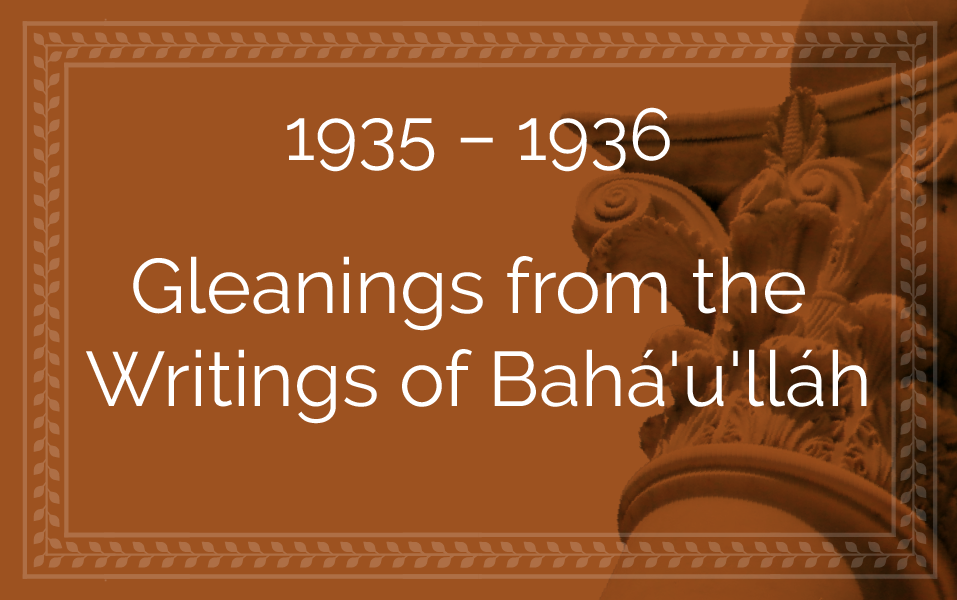
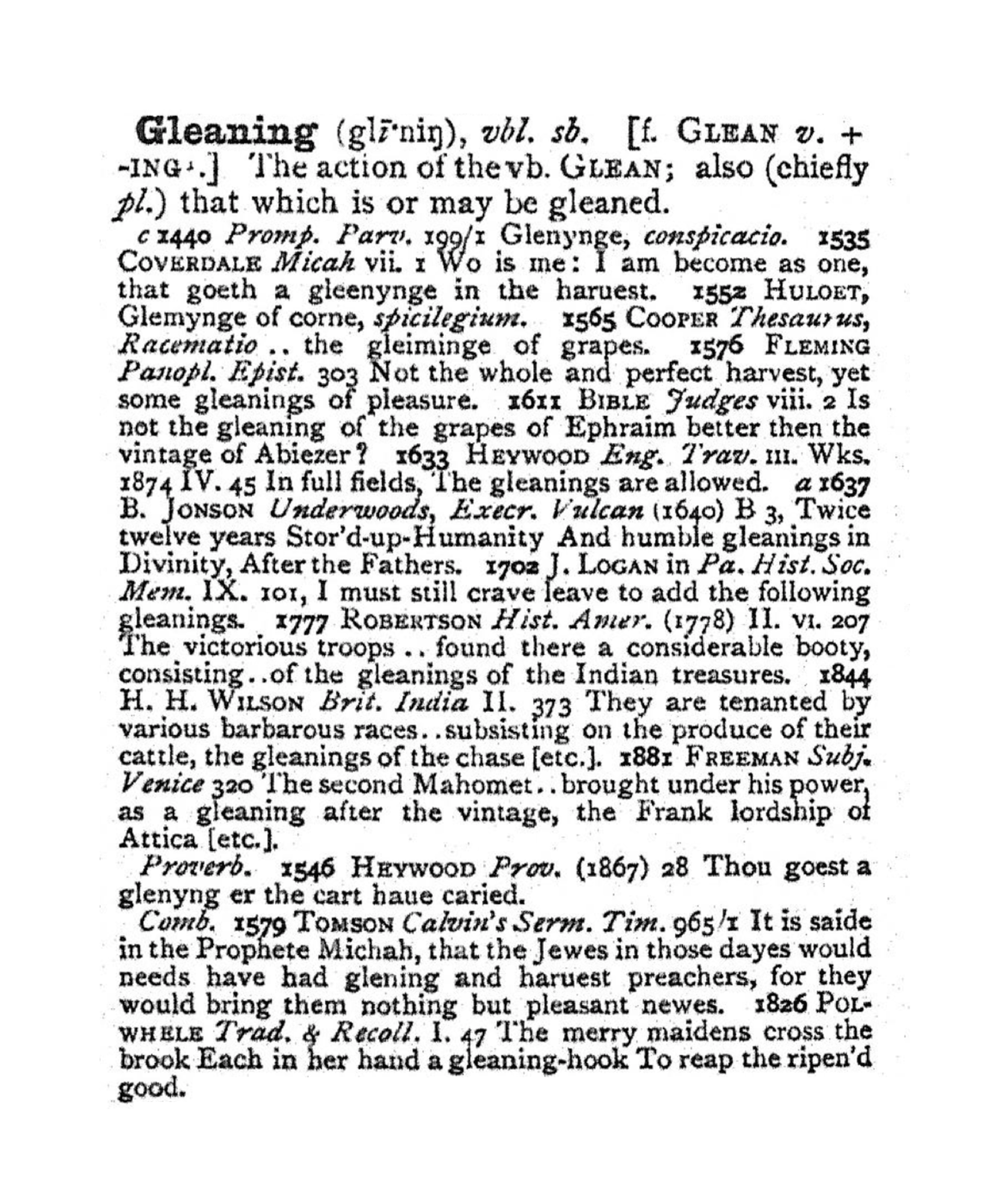
Definition of the word Gleaning: The Oxford English Dictionary Volume IV (F – G), page 210 (Internet Archive).
It is unknown exactly when Shoghi Effendi began working on his next literary marvel, but it was at least in 1934, if not earlier. This project was not a straight translation of a single work of Bahá'u'lláh, but rather, a careful selection of 165 excerpts from the Writings of Bahá'u'lláh chosen by the Guardian for the purpose of presenting to the Bahá’ís, as Shoghi Effendi’s secretary described it to George Townshend in a letter of 10 January 1935:
…a befitting and authoritative rendering of the fundamental teachings of the Cause regarding God, soul, creation, the nature of Divine Manifestations and similar subjects. In addition he is very keen to make of this work a means through which the non-Bahá’í public may be given the opportunity of acquiring an exact knowledge of, and a genuine interest in, the Message.
Shoghi Effendi sent Gleanings from the Writings of Bahá’u’lláh to George Townshend in four installments for editorial comments, from December 1934 to April 1935. The title—Gleanings from the Writings of Bahá'u'lláh—was Shoghi Effendi’s original idea, and one of his requests for George Townshend was regarding the suitability and timeliness in publishing this collection. The Guardian also specifically requested George to carefully go over the manuscript with a view of improving its style and making it as fluently readable as possible.
George Townshend returned the final pages on 8 May 1935, specifically calling the Guardian’s attention to the fact he had felt that his English translation had such a special force and beauty, he was compelled to not change it, though he did suggest some very minor editorial changes.
Shoghi Effendi published his timeless bouquet of Writings of Bahá'u'lláh in 1935, a collection which would find its way into the hearts and souls of all Bahá'ís, and to which all believers would turn to, time and again, in search of solace, inspiration, and guidance.
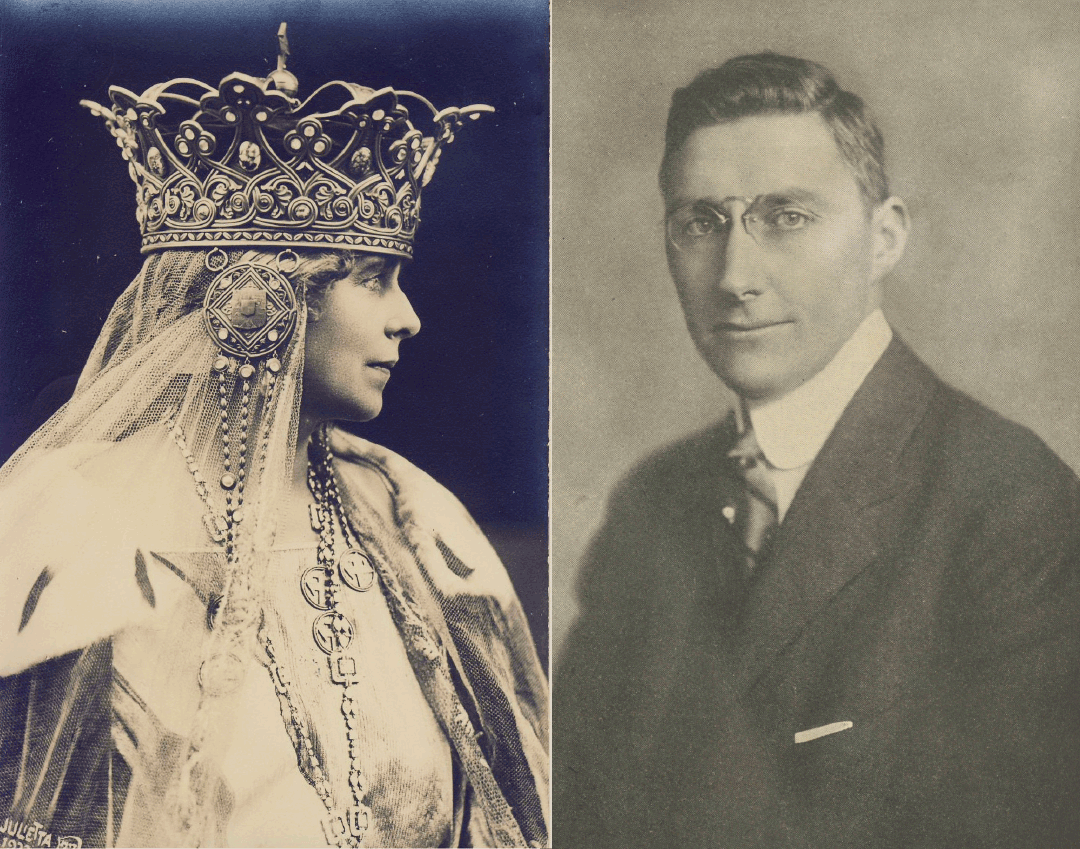
Queen Marie of Romania wearing the steel crown forged out of a cannon captured from the Ottomans during the War of Independence. Source: Wikimedia Commons. Bayard Dodge, one of Shoghi Effendi’s former professors at Syrian Protestant College, now American University in Beirut. Source: Bahaimedia.
Martha Root gave Queen Marie of Romania a copy of Gleanings from the Writings of Bahá'u'lláh, and the Queen thanked Shoghi Effendi, describing Gleanings as a “wonderful book, every word of which is precious to me, and doubly so in this time of anxiety and unrest.” Queen Marie told Martha Root that Gleanings possessed true spiritual power, and that “even doubters would find a powerful strength in it, if they would read it alone, and would give their souls time to expand.”
When Bayard Dodge, Shoghi Effendi’s old Professor from Syrian Protestant College received Gleanings from the Writings of Bahá'u'lláh, he had words of the highest praise for his former student, now the Head of the Bahá'í Faith:
You have mastered English in such a remarkable way that I am sure the sayings do not lose their meaning and charm because of translation.
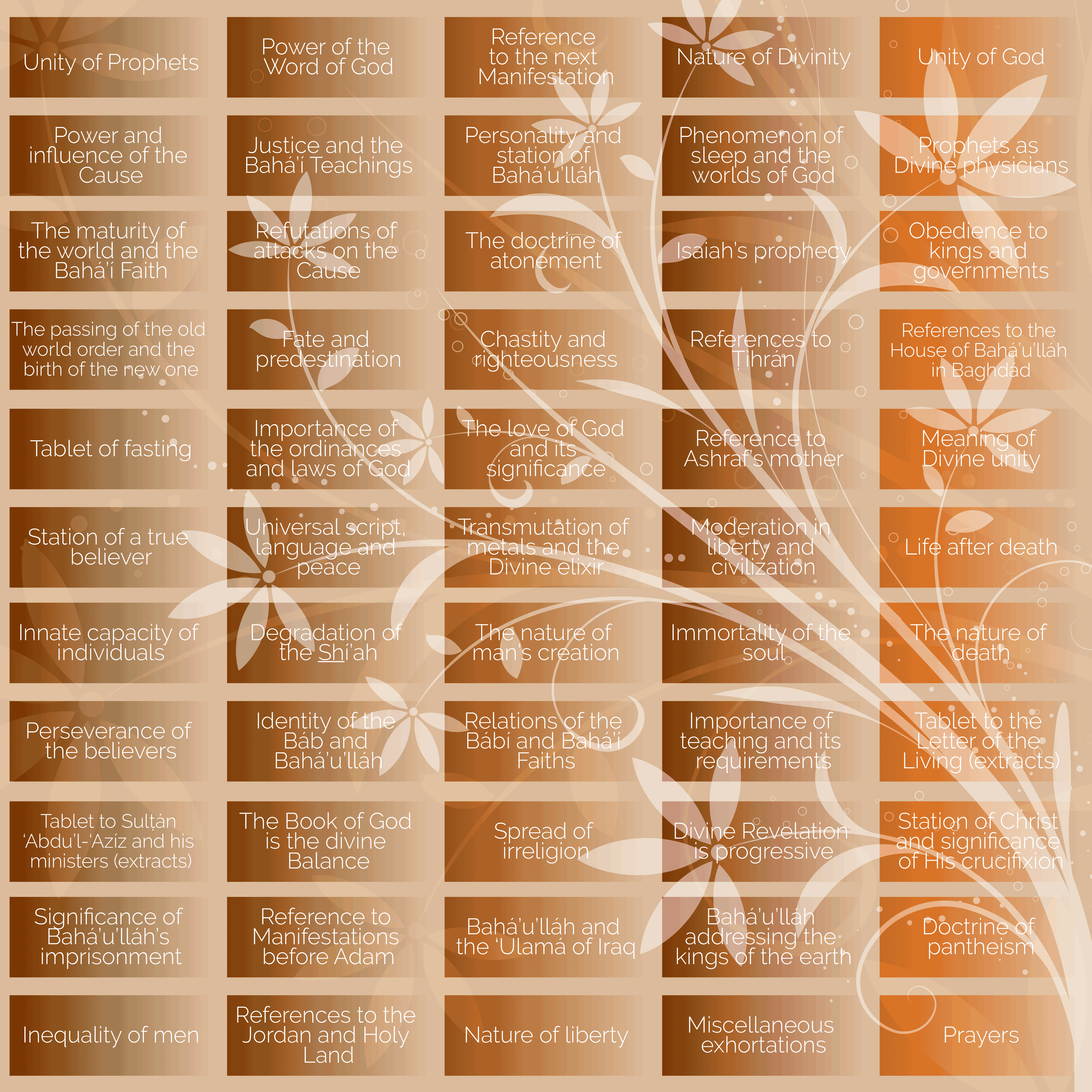
In a letter to the National Spiritual Assembly of the United States and Canada dated 13 May 1935—ostensibly prior to publication—the Guardian provided a list of 55 subjects addressed in Gleanings from the Writings of Bahá'u'lláh to help build the index for the work. The list is as follows:
- Unity of Prophets
- Power of the Word of God
- Reference to the next Manifestation
- Nature of Divinity
- Unity of God
- Power and influence of the Cause
- Justice and the Bahá’í Teachings
- Personality and station of Bahá’u’lláh
- Phenomenon of sleep and the worlds of God
- Prophets as Divine physicians
- The maturity of the world and the Bahá’í Faith
- Refutations of attacks on the Cause
- The doctrine of atonement
- Isaiah’s prophecy
- Obedience to kings and governments
- The passing of the old world order and the birth of the new one
- Fate and predestination
- Chastity and righteousness
- References to Ṭihrán
- References to the House of Bahá’u’lláh in Baghdád
- Tablet of fasting
- Importance of the ordinances and laws of God
- The love of God and its significance
- Reference to Ashraf’s mother
- Meaning of Divine unity
- Station of a true believer
- Universal script, language and peace
- Transmutation of metals and the Divine elixir
- Moderation in liberty and civilization
- Life after death
- Innate capacity of individuals
- Degradation of the Shí’ah
- The nature of man’s creation
- Immortality of the soul
- The nature of death
- Perseverance of the believers
- Identity of the Báb and Bahá’u’lláh
- Relations of the Bábí and Bahá’í Faiths
- Importance of teaching and its requirements
- Tablet to the Letter of the Living (extracts)
- Tablet to Sultan ‘Abdu’l-‘Azíz and his ministers (extracts)
- The Book of God is the divine Balance
- Spread of irreligion
- Divine Revelation is progressive
- Station of Christ and significance of His crucifixion
- Significance of Bahá’u’lláh’s imprisonment
- Reference to Manifestations before Adam
- Bahá’u’lláh and the ‘Ulamá of Iraq
- Bahá’u’lláh addressing the kings of the earth
- Doctrine of pantheism
- Inequality of men
- References to the Jordan and Holy Land
- Nature of liberty
- Miscellaneous exhortations
- Prayers
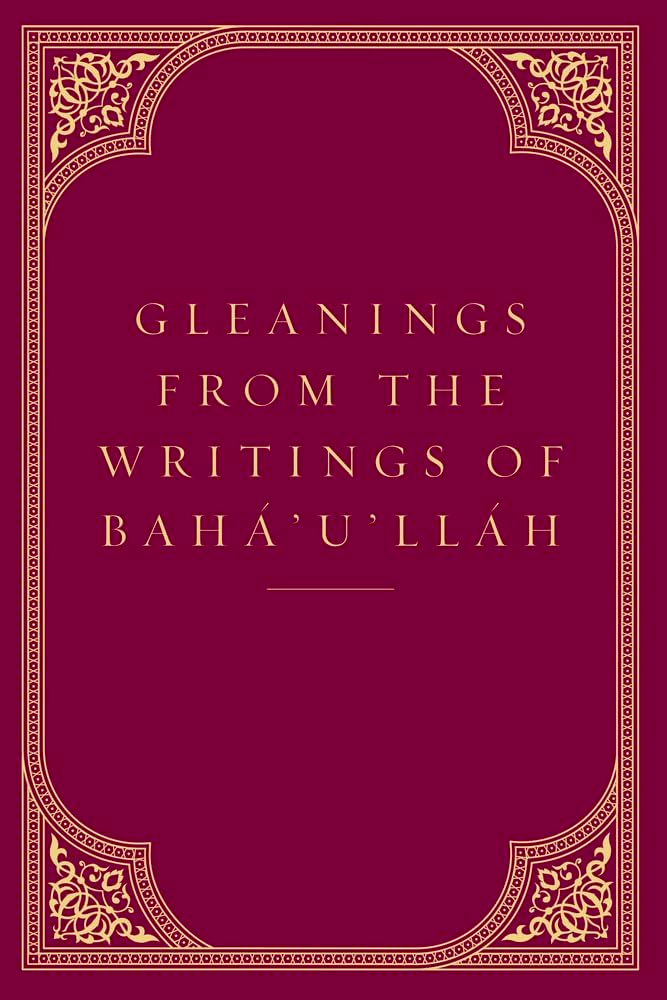
This story was written by Adib Masumian, provisional translator of the Bahá'í Writings from Arabic and Persian into English:
An exceptional example of Shoghi Effendi’s mastery of both translation and interpretation from Arabic and Persian into English is Gleanings from the Writings of Bahá'u'lláh Selection XCIX, which begins “The vitality of men’s belief in God is dying out in every land.”
On its own, the English never reads like a translation, but rather as if it had been revealed by Bahá'u'lláh into English directly. That is how simultaneously self-effacing and beautiful the Guardian’s translation is.
But in order to produce such an elegant translation, it is important to remember there are at least two major factors that work in combination: Shoghi Effendi’s mastery of English, and his unerring interpretation of the Writings from their original Persian and Arabic into English.
Where the former is concerned, this particular sentence in the excerpt below reads so beautifully, with such elegance and majesty in spite of its complexity:
Is it within human power, O Ḥakím, to effect in the constituent elements of any of the minute and indivisible particles of matter so complete a transformation as to transmute it into purest gold?
As for the latter, there are so many examples one can point to, but to choose just two:
- "The vitality of men’s belief in God is dying out in every land"reads literally in the original text as: "the strength and ability of belief are weakening in the regions of the world."
- "The corrosion of ungodliness" is a perfect example of interpretation on the part of Shoghi Effendi. The original Persian/Arabic is a dark metaphor which states “the blackness of copper," but in his interpreted translation, the Guardian not only keeps the imagery of rusting by using the word “corrosion,” but also links it with the true meaning of spiritual and moral decay in society.
Reading between the original Arabic and Persian and the Guardian’s English interpretation and translation is like watching a master jeweler at work. Here is the full excerpt from Gleanings from the Writings of Bahá'u'lláh:
The vitality of men’s belief in God is dying out in every land; nothing short of His wholesome medicine can ever restore it. The corrosion of ungodliness is eating into the vitals of human society; what else but the Elixir of His potent Revelation can cleanse and revive it? Is it within human power, O Ḥakím, to effect in the constituent elements of any of the minute and indivisible particles of matter so complete a transformation as to transmute it into purest gold? Perplexing and difficult as this may appear, the still greater task of converting satanic strength into heavenly power is one that We have been empowered to accomplish. The Force capable of such a transformation transcendeth the potency of the Elixir itself. The Word of God, alone, can claim the distinction of being endowed with the capacity required for so great and far-reaching a change.
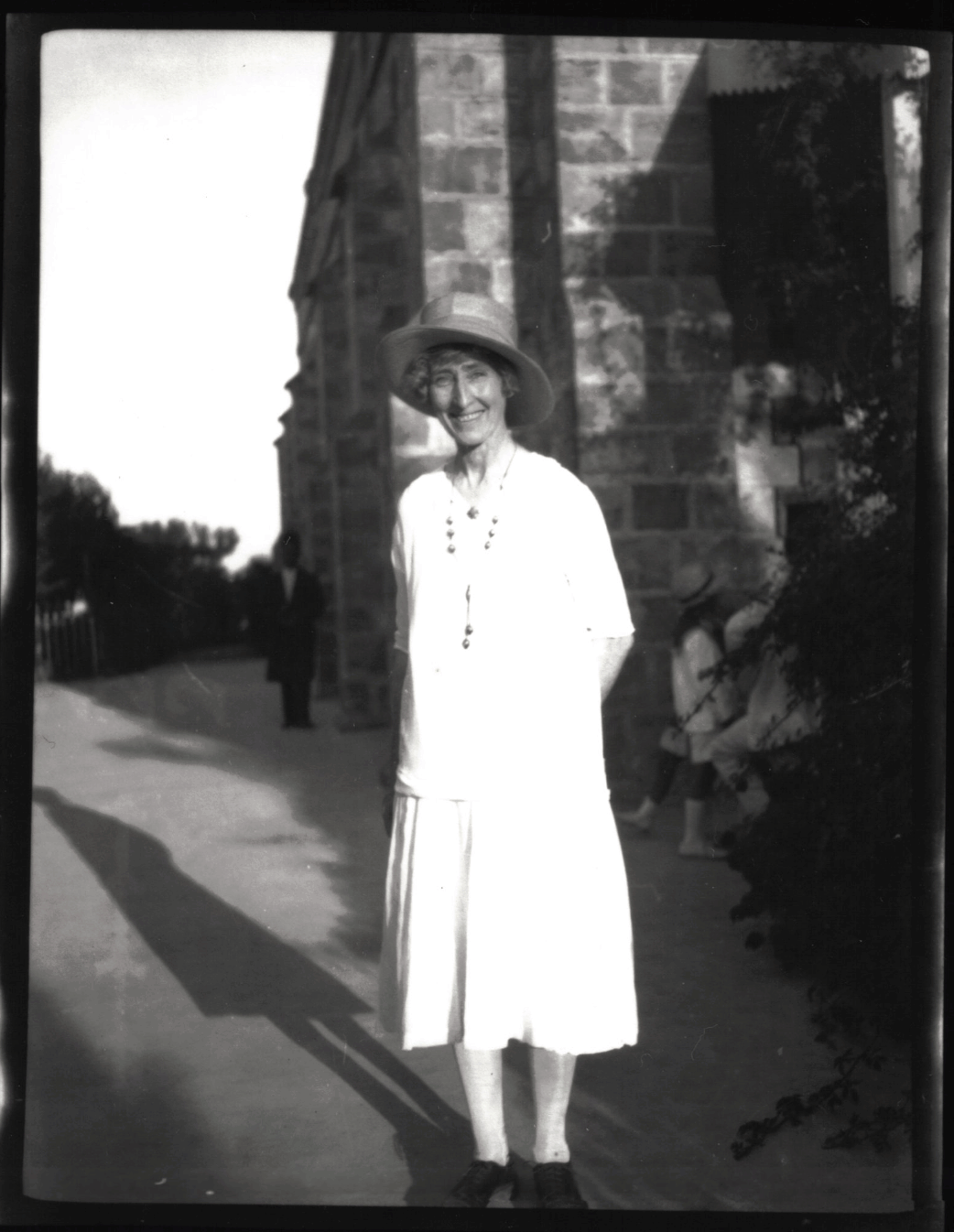
Effie Baker in Haifa.
After her return from her six-month photographic assignment in Iran, Effie Baker resumed her duties as hostess of the Western Pilgrim House, and was very busy. By 1931 Effie had served Shoghi Effendi in Haifa for five years and had proven both her abilities and her complete devotion. The Guardian trusted Effie so implicitly that he named her Custodian of the International Archives.
One evening at dinner, Shoghi Effendi teased Effie about the number of keys she carried as both the Custodian of the International Bahá'í Archives and the hostess of the Western Pilgrim House. Effie Baker was still documenting the Guardian’s landscaping and construction of the Bahá'í World Centre, mostly on Mount Carmel.
Many prominent and fascinating Bahá'ís came on pilgrimage that year: Mrs. Lynch was in Haifa in November 1931, assisting Shoghi Effendi with translation of German correspondence. Albert Windust also arrived at the same time to help Shoghi Effendi with the preparations for publication of the next volume of The Bahá’í World. Late in 1931, Effie was overjoyed to welcome New Zealander pilgrims Amy Dewing and her daughter Vera. Clara Dunn arrived on pilgrimage in April 1932.
In April 1933, Marzieh Gail—the eminent author and translator—Marjorie Morten, Mark Tobey—the famous abstract painter—and Mountfort Mills, the lawyer, arrived on 17 April 1933. They all appreciated Effie’s feminine touches to the Western Pilgrim House, like floating roses in water bowls, putting flowers on the pilgrim trays. Keith Ransom-Kehler arrived in August 1933 and stayed for 9 weeks, she came to consult and be trained by Shoghi Effendi for her journey to Iran—the last journey of her life.
By 1935, Effie Baker had been the hostess of the Western Pilgrim House for 10 years, and she was getting tired. She was 55 years old and the physical demands of her service were beginning to be too taxing for her. Her mother back in Goldsborough Victoria, Australia was becoming elderly and was in need of constant loving care and attention. Towards the end of 1935, Effie resigned from Haifa's Social Service and Infant Welfare Association after building and auctioning a beautiful doll house as her farewell gift to an association she loved.
In her decade of living in Haifa, the port city had become a very important commercial center. When Effie Baker arrived in 1925 the population of Haifa was 26,000, and when she left in 1936, there were 75,000 people living in Haifa.
With the Guardian’s blessings and lasting gratitude, Effie left Haifa after a decade of devoted service to Shoghi Effendi, and having earned the admiration of countless Bahá'í pilgrims to witnessed her example of love, devotion and humility. She sailed away in early 1936, and arrived in Perth, Australia, on 3 February 1961.
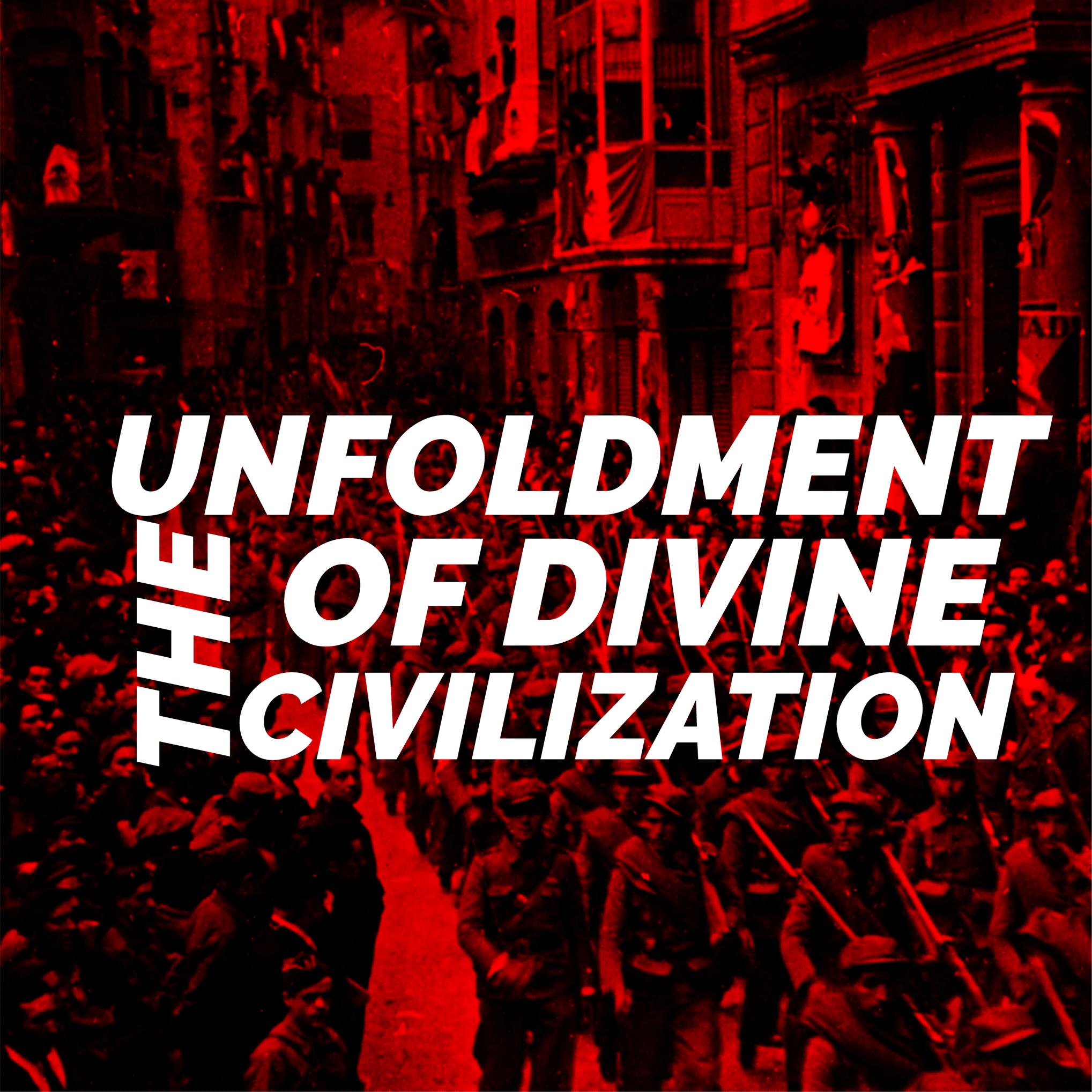
1936: Events that shook the world’s stage the year Shoghi Effendi wrote The Unfoldment of World Civilization. The death of King George V; The Battle of Amba-Aradam in the Second Italo-Ethipioan War; Hitler and Nazi Germany reoccupy the Rhineland in violation of the Treaty of Versailles; The start of the Spanish Civil War; After a coup, Greece becomes yet another European country to fall under the rule of authoritarian Fascism; In the Soviet Union, Joseph Stalin begins his Great Purge; Great Britain is rocked by the abdication of King Edward VIII; China suffers a disastrous famine in Sichuan, which claims the lives of 5 million people, forcing starving men, women and children to eat clay to survive. Background image: The Spanish Civil War (Encyclopaedia Britanica).
In 1936, amid continuing rising political unrest and severe socio-economic challenges in both Europe and America, Shoghi Effendi communicated with the Bahá'ís of the West with a letter called The Unfoldment of World Civilization, written on 11 March 1936.
The Guardian casts his unerring eye on the decaying state of the world and its rapid political, moral and spiritual decline, what he terms the “downfall of those powers and principalities that have either ignored or opposed’ the onward march of the Faith,” the crisis in Christianity and Islam, and the terrifying heedlessness of humanity.
Shoghi Effendi contrasts this appalling diagnosis with the two-fold process of “mystic, all-pervasive” power of Bahá'u'lláh’s revivifying Teachings.
On the one hand, the spiritual process engendered by the Revelation of Bahá'u'lláh increasingly promotes oneness and cohesion.
An on the other hand, in a complementary dual process, it disrupts a damaged, ailing world, forcing mankind to part with “hollow and outworn institutions” and “obsolescent doctrines and beliefs.”
Letters like The Unfoldment of World Civilization contained so many newly translated quotes of Bahá'u'lláh and 'Abdu'l-Bahá, that they sustained the Bahá'ís, fed their souls, inspired them, and more importantly, educated them on the world-embracing aims of the Bahá'í Faith, year after year.
In Shoghi Effendi’s analysis of the decay of religion, he contrasts the strictly non-partisan, non-sectarian, unifying power of the Bahá'í Faith, stating that Bahá'u'lláh had prophesied a universal system of governance based on oneness: a single language, a single currency, a single script, even a single system of measurement.
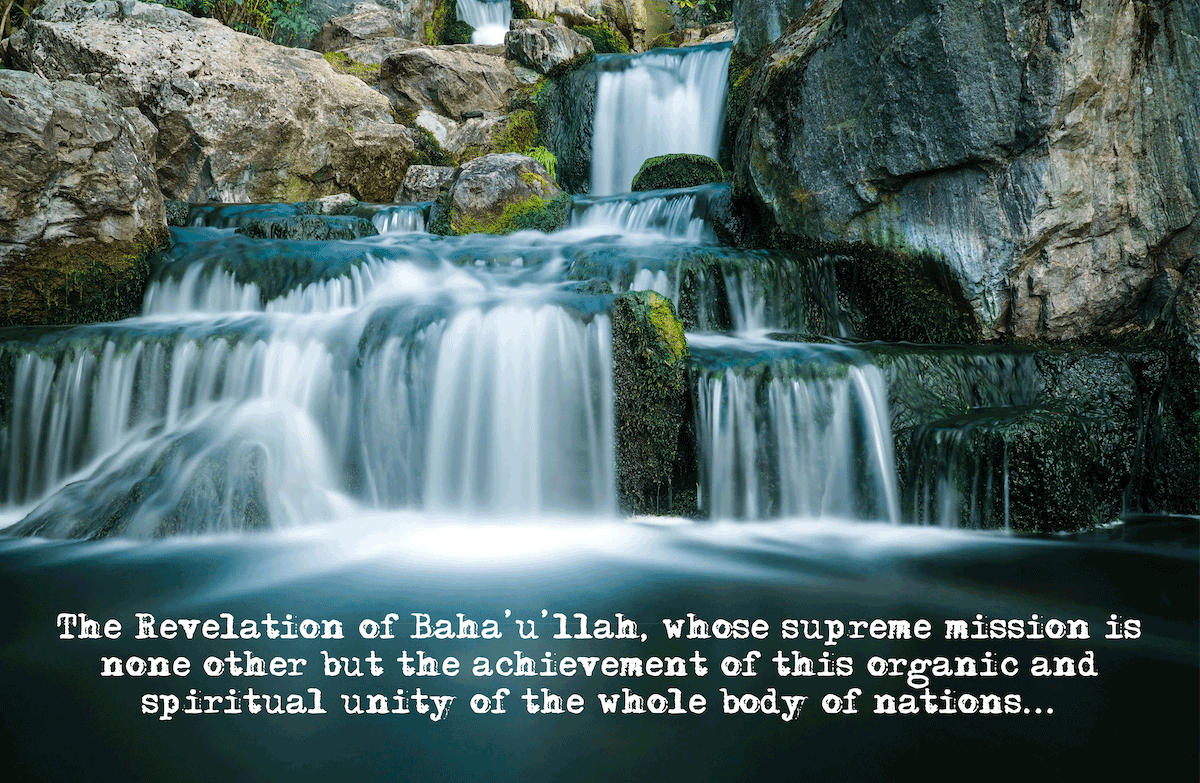
Waterfall photo by Mike Lewis HeadSmart Media on Unsplash.
This excerpt on the primary aim of Bahá'u'lláh’s Revelation is a perfect encapsulation of several of the themes addressed by the Guardian in The Unfoldment of World Civilization:
The Revelation of Bahá’u’lláh, whose supreme mission is none other but the achievement of this organic and spiritual unity of the whole body of nations, should, if we be faithful to its implications, be regarded as signalizing through its advent the coming of age of the entire human race. It should be viewed not merely as yet another spiritual revival in the ever-changing fortunes of mankind, not only as a further stage in a chain of progressive Revelations, nor even as the culmination of one of a series of recurrent prophetic cycles, but rather as marking the last and highest stage in the stupendous evolution of man’s collective life on this planet. The emergence of a world community, the consciousness of world citizenship, the founding of a world civilization and culture – all of which must synchronize with the initial stages in the unfoldment of the Golden Age of the Bahá’í Era – should, by their very nature, be regarded, as far as this planetary life is concerned, as the furthermost limits in the organization of human society, though man, as an individual, will, nay must indeed as a result of such a consummation, continue indefinitely to progress and develop.

Participants at the 1933 World Congress of Faiths. Source: Mahanam.org.
The World Congress of Faiths was an interfaith organization that was formed in London between 3 – 17 July 1936, and is one of the oldest interfaith organizations in the world. In July 1936, representatives of all religions, liberals, scientists and philosophers gathered to fulfill the intention of the Congress, that is “To promote the spirit of fellowship was the one aim of the Congress.”
Bahá'ís Buddhists, Hindus, Jews, Christians, Muslims, and Confucianists presented a total of 20 papers on the theme of the Congress, “World Fellowship through Religion.”
The Bahá'ís presented paper number 17: Bahá’u’lláh’s Ground Plan of World Fellowship, which had been approved by Shoghi Effendi and which was presented by “The Reverend Canon George Townshend” on the morning of 16 July 1936. This paper is 9 pages long, and a summary of it would be too long to include in this chronology, but we have formatted the document and it can be downloaded by clicking on the graphic below:
One wonderful, humorous section of this presentation is the following excerpt:
In advocating peace to a western audience ‘Alí-Aṣghar once said: “You have had war for thousands of years; why not try peace for a change? If you do not like it you can always go back to war.” One might hazard a similar suggestion about this fellowship plan. We have tried every other device, why not now try this?
After this presentation, Mrs. Bishop, a representative of the Bahá'í International Bureau in Geneva explained that it was every Bahá'ís mission to break down barriers both within and outside the churches, and she quoted Bahá'u'lláh and Shoghi Effendi from The Goal of a New World Order.
Dr. D. N. Maitra, a member of the Congress, from India recalled visiting the Shrine of the Báb in Haifa with his daughter three months before the Congress:
It was on the 24th of April this year (1936) that I, with my daughter, paid a visit to the mausoleum on Mount Carmel, built over the remains of the Báb and ‘Abdu’l-Bahá. And it was twenty-five years ago in this very city of London that I first attended a Bahá’í meeting and spoke there. Such is my very personal interest in and regard for the great cause which is represented by Bahá’í.
Madame Barry-Orlova spoke next, on behalf of the International Bahá’í Community and had a strong opening sentence:
Bahá’u’lláh has said: “Speed ye out of your sepulchers.” What is the sepulcher? The sepulcher is the denial of humanity, the limitation and the ignorance of the Manifestation of God, He who manifests the splendor, the glory and bounty and the gift of God.
Mr. St. Barbe Baker—not a Bahá'í—recalled 'Abdu'l-Bahá’s heroic humanitarian efforts during World War I:
When I was in Palestine a little while ago I had the great privilege of meeting Shoghi Effendi, who is Guardian of the Bahá’í Cause. I also met many other local inhabitants who told me stories about ‘Abdu’l-Bahá. It is not generally realized how wonderful was the contribution He made to peace. Three years before the Great War He realized what was coming, and insisted that His Persian settlers should plant wheat, which they did, and it was stored. And when the Turks evacuated Palestine this wheat was brought forward to feed the starving population. This shows the practical aspect of their Movement. Do you not see in it a solution? Both the spiritual and the scientific working together, one the complement of the other.
SOURCES FOR PART X
Shoghi Effendi and Bahíyyih Khánum: A profound, spiritual love
The Guardian and the Greatest Holy Leaf: After the passing of ‘Abdu’l-Bahá
The Greatest Holy Leaf: the Guardian’s refuge
REFERENCES FOR THE PREVIOUS THREE STORIES:
The Priceless Pearl, Rúḥíyyih Rabbání, Bahá’í Publishing Trust, London, 1969, pages 6-7, 144-146 and 430.
Unfolding Destiny, Shoghi Effendi.
Letters and Extracts of Writings from the Guardian Published in the US Bahá’í News 1924 – 1934, Shoghi Effendi.
Leaves of the Twin Divine Trees. Baharieh Rouhani Ma’ani, George Ronald, Oxford, 2013, Kindle Edition, Chapter 7: Bahá’íyyih Khánum, the Most Outstanding Heroine of the Bahá’í Dispensation.
1892 – 1932: Bahíyyih Khánum in ‘Akká and Haifa during ‘Abdu’l-Bahá’s and Shoghi Effendi’s absences
Times when the Greatest Holy Leaf was alone at the head of the Faith in the Holy Land
REFERENCES FOR THE PREVIOUS TWO STORIES:
Bahíyyih Khánum and the Covenant: Google Sheets calculations by Violetta Zein based on ‘Abdu’l-Bahá and Shoghi Effendi’s dated absences from the World Center.
TLD
Violetta Zein, The Extraordinary Life of ‘Abdu’l-Bahá Part VIII: Return to the Holy Land (1913-1921): Early 1916 – NAZARETH – ‘Abdu’l-Bahá visits Jamál Páshá.
Leaves of the Twin Divine Trees. Baharieh Rouhani Ma’ani, George Ronald, Oxford, 2013, Kindle Edition, Chapter 7: Bahá’íyyih Khánum, the Most Outstanding Heroine of the Bahá’í Dispensation.
The Greatest Holy Leaf: Trusted supporter of ‘Abdu’l-Bahá
The Greatest Holy Leaf: Chief sustainer of the Guardian
REFERENCES FOR THE PREVIOUS TWO STORIES:
Leaves of the Twin Divine Trees. Baharieh Rouhani Ma’ani, George Ronald, Oxford, 2013, Kindle Edition, Chapter 7: Bahá’íyyih Khánum, the Most Outstanding Heroine of the Bahá’í Dispensation.
Transcript of The Greatest Holy Leaf, talk by Bahíyyih Nakhjávání, Timestamp: 5:20.
The Priceless Pearl, Rúḥíyyih Rabbání, Bahá’í Publishing Trust, London, 1969, page
Bahá’í Administration, Shoghi Effendi, Letter of 17 July 1932.
25 October 1929 – March 1932: Shoghi Effendi’s awareness of Bahíyyih Khánum’s frailty
The Priceless Pearl, Rúḥíyyih Rabbání, Bahá’í Publishing Trust, London, 1969, pages 144-146.
Bahá’í Administration, Shoghi Effendi, 25 October 1929.
The World Order of Bahá’u’lláh, Shoghi Effendi, 21 March 1932: The Golden Age of the Cause of Bahá’u’lláh: Our Beloved Temple.
May – 15 July 1932 in Interlaken: The Guardian learns of the passing of the Greatest Holy Leaf
The Guardian’s fist cable announcing the passing of the Greatest Holy Leaf
REFERENCES FOR THE PREVIOUS TWO SECTIONS:
The Priceless Pearl, Rúḥíyyih Rabbání, Bahá’í Publishing Trust, London, 1969, pages 144-146.
Prophet’s Daughter: The Life and Legacy of Bahíyyih Khánum, Outstanding Heroine of the Bahá’í Faith. Janet A. Khan, Bahá’í Publishing Trust, Wilmette, 2005.
17 July 1932: The Guardian’s eulogy for the Greatest Holy Leaf
17 July 1932: Shoghi Effendi’s full eulogy for the Greatest Holy Leaf
REFERENCES FOR THE PREVIOUS TWO STORIES:
Bahá’í Administration, Shoghi Effendi, Letter of 17 July 1932.
17 July 1932 eulogy to the Greatest Holy Leaf in Shoghi Effendi’s own handwriting.
Leaves of the Twin Divine Trees. Baharieh Rouhani Ma’ani, George Ronald, Oxford, 2013, Kindle Edition, Chapter 7: Bahá’íyyih Khánum, the Most Outstanding Heroine of the Bahá’í Dispensation.
A “station such as none other woman hath surpassed”
The Greatest Holy Leaf: Outstanding heroine of the Bahá’í Dispensation
The Guardian’s titles for the Greatest Holy Leaf
REFERENCES FOR THE PREVIOUS THREE STORIES:
Leaves of the Twin Divine Trees. Baharieh Rouhani Ma’ani, George Ronald, Oxford, 2013, Kindle Edition, Chapter 7: Bahá’íyyih Khánum, the Most Outstanding Heroine of the Bahá’í Dispensation.
God Passes By, Shoghi Effendi.
Bahíyyih Khanum: The Greatest Holy Leaf by Bahá’u’lláh, Abdu’l-Bahá, Shoghi Effendi, and Bahíyyih Khanum compiled by Research Department of the Universal House of Justice Haifa: Bahá’í World Centre Publications, (1982),Part III: From the Writings of Shoghi Effendi.
1932 – 1957: Shoghi Effendi’s remembrance of Bahíyyih Khánum
The Priceless Pearl, Rúḥíyyih Rabbání, Bahá’í Publishing Trust, London, 1969, pages 147-148.
1932: George Adam Benke returns to Bulgaria at the Guardian’s request
23 November 1932: George Adam Benke: The first European martyr
REFERENCES FOR PREVIOUS TWO STORIES:
A love which does not wait : the stories of Lua Getsinger, May Maxwell, Martha Root, Keith Ransom-Kehler, Hyde Dunn, Susan Moody, Dorothy Baker, Ella Bailey, and Marion Jack, Janet Ruhe-Schoen, Palabra Publications (1998), pages 268-269.
Bahá’í Library Online chronology: 1932.
The Bahá’í World Volume 5, pages 416-418.
The Light of Divine Guidance, Volume 1: Letter of 21 June 1956.
Email communication with Aïcha Benmamar dated 18 December 2023, providing the 21 June 1956 excerpt from the later by Shoghi Effendi elevating George Adam Benke to the station of first European Martyr.
Email communication with Alexander Meinhard dated 19 December 2023 regarding the location of George Adam Benke’s birth being Friedrichsfeld, Gonv. Taurien, Ukraine, today called Rosdil, Ukraine.
Wikipedia: Rosdil.
14 January 1933: The Guardian’s tribute to the Greatest Holy Leaf
Bahá’í News, Issue 74 (May1933).
The Bahá’í World Volume 5, pages 169-173.
27 January 1933: Forty Bahá’ís imprisoned in Istanbul and Adana
The Priceless Pearl, Rúḥíyyih Rabbání, Bahá’í Publishing Trust, London, 1969, pages 316-318.
Before 26 February 1933: Shoghi Effendi and the Grand Duke Alexander of Russia
The Priceless Pearl, Rúḥíyyih Rabbání, Bahá’í Publishing Trust, London, 1969, pages 270-271.
Wikipedia: Grand Duke Alexander Mikhailovich of Russia.
18 March 1933: The Most Great House of Bahá’u’lláh in Baghdad
1923 – 18 March 1933: Ten years of efforts to win back the Most Great House of Bahá’u’lláh
REFERENCES FOR THE PREVIOUS TWO STORIES:
The Priceless Pearl, Rúḥíyyih Rabbání, Bahá’í Publishing Trust, London, 1969, pages 94-97.
Martha Root, Herald of the Kingdom. Kay Zinky, (comp.) Bahá’í Publishing Trust, New Delhi, 1983, page 149.
The Bahá’í World, Volume 4, pages 237-247.
The Bahá’í World, Volume 5, pages 351-359.
Bahá’í International Community, Letter dated 18 March 1933.
Chronology on Bahá’í Library Online: The House of Bahá’u’lláh.
Documents on the Shaykhi, Babi and Baha’i Movements, Vol. 8, No. 1 (May 2004, updated 2013), Compilation on the House of Bahá’u’lláh, Baghdád ‘Iráq: Extracts from the minutes of the twenty-first session held at Geneva from October 26th to November 13th, 1931, page 246.
Shoghi Effendi Through the Pilgrim’s Eye Volume 1 Building the Administrative Order, 1922-1952. Earl Redman, George Ronald, Oxford, 2015, Kindle Edition, Location 3848.
History Channel: Iraq wins independence.
Wikipedia: King Faisal I of Iraq.
Wikipedia: List of Prime Ministers of Iraq.
The station of America in the writings of the Báb, Bahá’u’lláh, and ‘Abdu’l-Bahá
The station of America in the writings of Shoghi Effendi
1923 – 1933: The Guardian’s statements about America
REFERENCES FOR THE PREVIOUS FOUR STORIES:
The Priceless Pearl, Rúḥíyyih Rabbání, Bahá’í Publishing Trust, London, 1969, page 336-341.
Lawḥ-i-Aqdas, Bahá’u’lláh.
Citadel of Faith, Shoghi Effendi: Words of ‘Abdu’l-Bahá.
Bahá’í Administration, Shoghi Effendi: Letter of 26 November 1923.
21 April 1933: America and the Most Great Peace
An excerpt from America and the Most Great Peace
REFERENCES FOR THE PREVIOUS TWO STORIES:
The Priceless Pearl, Rúḥíyyih Rabbání, Bahá’í Publishing Trust, London, 1969, page 213.
America and the Most Great Peace, Shoghi Effendi.
Shoghi Effendi: The Range and Power of His Pen, ‘Alí Nakhjávání, Acuto 2006, Casa Editrice Bahá’í, pages 154-159.
August 1933: The Greatest Holy Leaf’s monument
REFERENCES FOR THE TWO STORIES IN THIS SECTION:
The Priceless Pearl, Rúḥíyyih Rabbání, Bahá’í Publishing Trust, London, 1969, pages 146-147.
Leaves of the Twin Divine Trees. Baharieh Rouhani Ma’ani, George Ronald, Oxford, 2013, Kindle Edition, Chapter 7: Bahá’íyyih Khánum, the Most Outstanding Heroine of the Bahá’í Dispensation.
Bahá’í News, Issue 76 (August 1933).
Wikipedia: Carrara marble.
Zikrullah Khadem, The Itinerant Hand of the Cause of God. Javidukht Khadem, Bahá’í Publishing Trust, Wilmette, Ill. 1990, pages 292-293.
April – October 1933: Keith Ransom-Kehler’s mission to Persia
Keith Ransom-Kehler’s journey through Persia
REFERENCES FOR THE THREE PREVIOUS SECTIONS:
The Priceless Pearl, Rúḥíyyih Rabbání, Bahá’í Publishing Trust, London, 1969, pages 306-308.
Shoghi Effendi Through the Pilgrim’s Eye Volume 1 Building the Administrative Order, 1922-1952. Earl Redman, George Ronald, Oxford, 2015, Kindle Edition.
The Bahá’í Encyclopedia Project: Keith Ransom-Kehler.
Wikipedia: Keith Ransom-Kehler.
1930s: The change of tone in Shoghi Effendi’s writings
The Priceless Pearl, Rúḥíyyih Rabbání, Bahá’í Publishing Trust, London, 1969, page 214.
8 February 1934: The Dispensation of Bahá’u’lláh
Fourth section: The Formative Age of the Faith
Bahá’í cycles: the Guardian spiritually organizes the history of the Faith
The legacy of The Dispensation of Bahá’u’lláh
REFERENCES FOR THE SEVEN STORIES IN THIS SECTION:
The Priceless Pearl, Rúḥíyyih Rabbání, Bahá’í Publishing Trust, London, 1969, page 213 and 439-440.
The Dispensation of Bahá’u’lláh, Shoghi Effendi.
Shoghi Effendi: The Range and Power of His Pen, ‘Alí Nakhjávání, Acuto 2006, Casa Editrice Bahá’í, pages 159-164.
Encyclopedia Britannica: Great Depression: Political movements and social change.
23 January 1934: The Guardian’s gift to Queen Marie of Romania
The Guardian of the Bahá’í Faith, Rúhíyyih Rabbání, Bahá’í Publishing Trust, London, 1988, page 50.
The Priceless Pearl, Rúḥíyyih Rabbání, Bahá’í Publishing Trust, London, 1969, page 116.
Bahá’í Library Online chronology: The life of Shoghi Effendi.
1934: Músá and Samíhíh Banání’s first pilgrimage
Lights of Fortitude: Glimpses into the Lives of the Hands of the Cause of God, Barron Deems Harper, George Ronald, 1997, pages 339-345.
Bahaipedia: Músá Banání.
1934: The story of Samíhíh Banání great-grandmother falling on ‘Abdu’l-Bahá
Shoghi Effendi Through the Pilgrim’s Eye Volume 1 Building the Administrative Order, 1922-1952. Earl Redman, George Ronald, Oxford, 2015, Kindle Edition, Locations 8523-8543.
1934: ‘Adasiyyíh in the time of Shoghi Effendi
‘Adasiyyah: A Study in Agriculture and Rural Development, Iraj Poostchi Baha’i Studies Review, Volume 16, Number 1, 1 April 2010, pp. 61-105(45).
Spring 1934: The pilgrimage of Corinne True: “Shoghi Effendi, you are not eating enough”
Corinne True: Faithful Handmaid of ‘Abdu’l-Bahá, Nathan Rutstein with the assistance of Edna True, George Ronald, Oxford (1987), page 179 and 194.
26 April – 3 May 1934: The election of the first National Spiritual Assembly of Persia
The Priceless Pearl, Rúḥíyyih Rabbání, Bahá’í Publishing Trust, London, 1969, page 310.
The Bahá’í World Volume 6 (1934 – 1936): Survey of Current Bahá’í Activities in the East and West, pages 22-23.
Bahaipedia: NSA Iran.
10 May 1934: Tax Exemption for Bahá’í properties
The Priceless Pearl, Rúḥíyyih Rabbání, Bahá’í Publishing Trust, London, 1969, pages 268-270.
20 October 1934: The Guardian’s dictionary
An example of the use of a word’s fourth meaning
The review of the Websters’ New International Dictionary of the English Language, Second Edition
REFERENCES FOR THE PREVIOUS THREE STORIES:
Bahá’í Library Online chronology: The life of Shoghi Effendi.
Bahá’í Library Online: Dictionary Used by the Guardian, a Memorandum by the Research Department of the Universal House of Justice dated 8 December 1997. Nature Journal Issue number 3390, supplement: .20 October 1934 review of the dictionary.
Wikipedia: Webster’s Dictionary.
Wikipedia: Eric John Holmyard.
The Internet Archive: Webster’s New International Dictionary of the English Language, Second Edition.
6 December 1934: The Tarbíyat boys’ and girls’ School
The Priceless Pearl, Rúḥíyyih Rabbání, Bahá’í Publishing Trust, London, 1969, pages 308-309.
Bahá’í Library Online Chronology: Tarbíyat School.
8 May 1935: Gleanings from the Writings of Bahá’u’lláh
Exalted appreciations for Gleanings from the Writings of Bahá’u’lláh
Shoghi Effendi’s list of 55 subjects addressed in Gleanings
REFERENCES FOR THE THREE PREVIOUS STORIES:
The Priceless Pearl, Rúḥíyyih Rabbání, Bahá’í Publishing Trust, London, 1969, page 219.
Shoghi Effendi: The Range and Power of His Pen, ‘Alí Nakhjávání, Acuto 2006, Casa Editrice Bahá’í, pages 57-58.
George Townshend. David Hofman, George Ronald, Oxford, 1983, Chapter 6: Relationship with the Guardian.
An excerpt from Gleanings from the Writings of Bahá’u’lláh
Gleanings from the Writings of Bahá’u’lláh Selection No. XCIX.
Early 1936: Effie Baker’s last 5 years as hostess of the Western Pilgrim House
Ambassador at the Court: The Life and Photography of Effie Baker, Graham Hassall, Chapter 8: Pilgrim Hostel Hostess and Chapter 11: Last years in Haifa.
11 March 1936: The Unfoldment of World Civilization
An excerpt from the Unfoldment of World Civilization
REFERENCES FOR THE PREVIOUS TWO STORIES:
The Priceless Pearl, Rúḥíyyih Rabbání, Bahá’í Publishing Trust, London, 1969, pages 213-214.
The Unfoldment of World Civilization, Shoghi Effendi.
Shoghi Effendi: The Range and Power of His Pen, ‘Alí Nakhjávání, Acuto 2006, Casa Editrice Bahá’í, pages 164-169.
16 July 1936: The Bahá’í presence at the World Congress of Faiths
The Bahá’í World Volume 7: A session at the World Congress of Faiths.
![]()
 The Guardian and the Greatest Holy Leaf: After the passing of 'Abdu'l-Bahá
The Guardian and the Greatest Holy Leaf: After the passing of 'Abdu'l-Bahá
